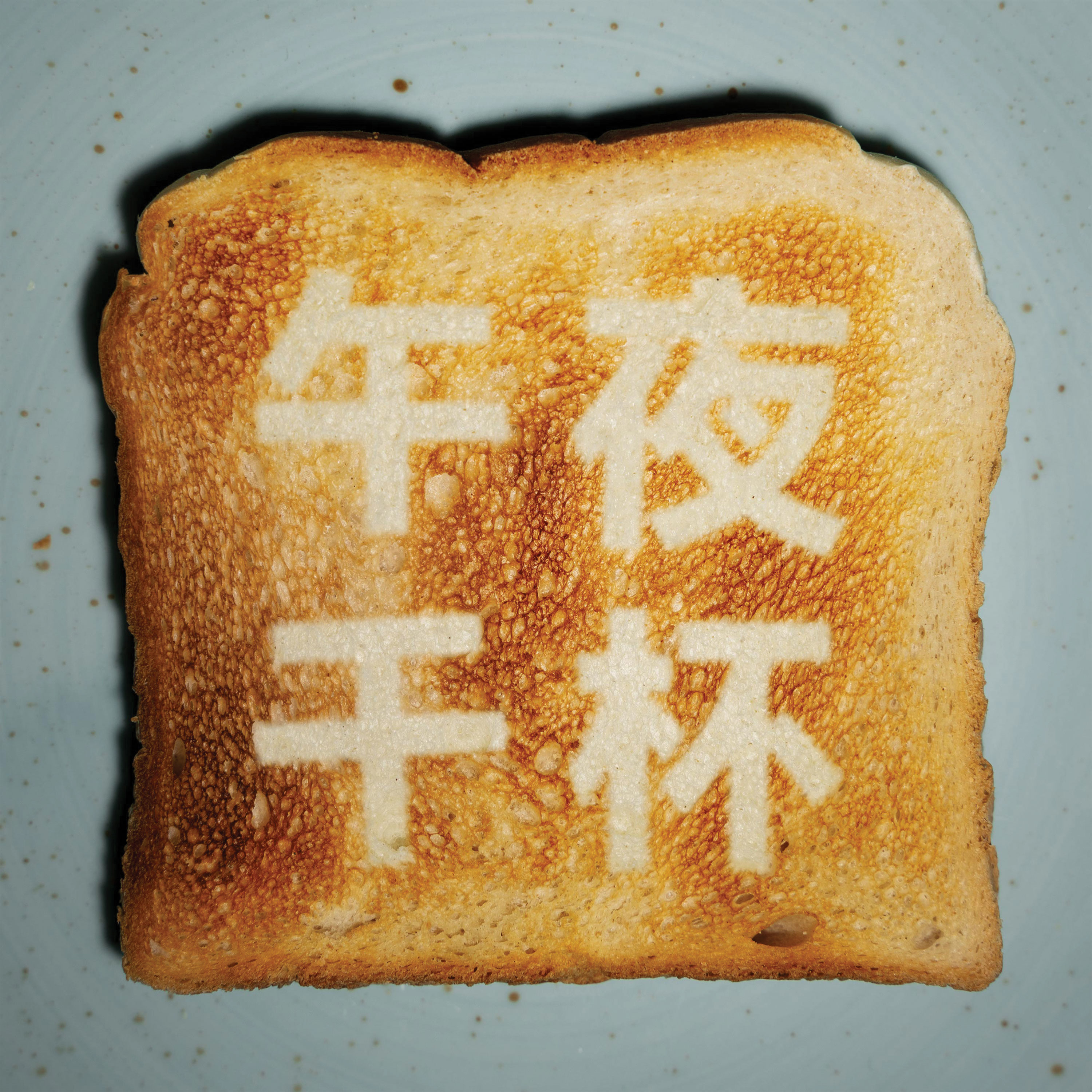We.Wheat.Weave | 2024
Initiative project
Commissioned by: DesignSingapore Council
Concept and Design: Xijing Xu and Yue Liu
Photo credits: Xijing Xu

With the widespread adoption of hybrid breeding, led by major seed companies to boost yield and production stability, the diversity of seeds and traditional cultivars is steadily disappearing from modern agriculture.
We.Wheat.Weave is an ongoing research project that collects diverse wheat and cereal varieties from places designers have lived and visited. Supported by the local community and using traditional weaving techniques, these materials are continuously crafted into a growing, basket-like sculpture that incorporates wheat ears, plant roots, and the weeds growing among the grains in each field.
This blend of materials creates a coarse, vibrant texture and shifting patterns, embodying a vision of ecological diversity and portraying their impressions of different fields.
The project has been presented as one of the special projects in the thematic exhibition area EAT: Transformative Seeds at Singapore Design Week 2024.


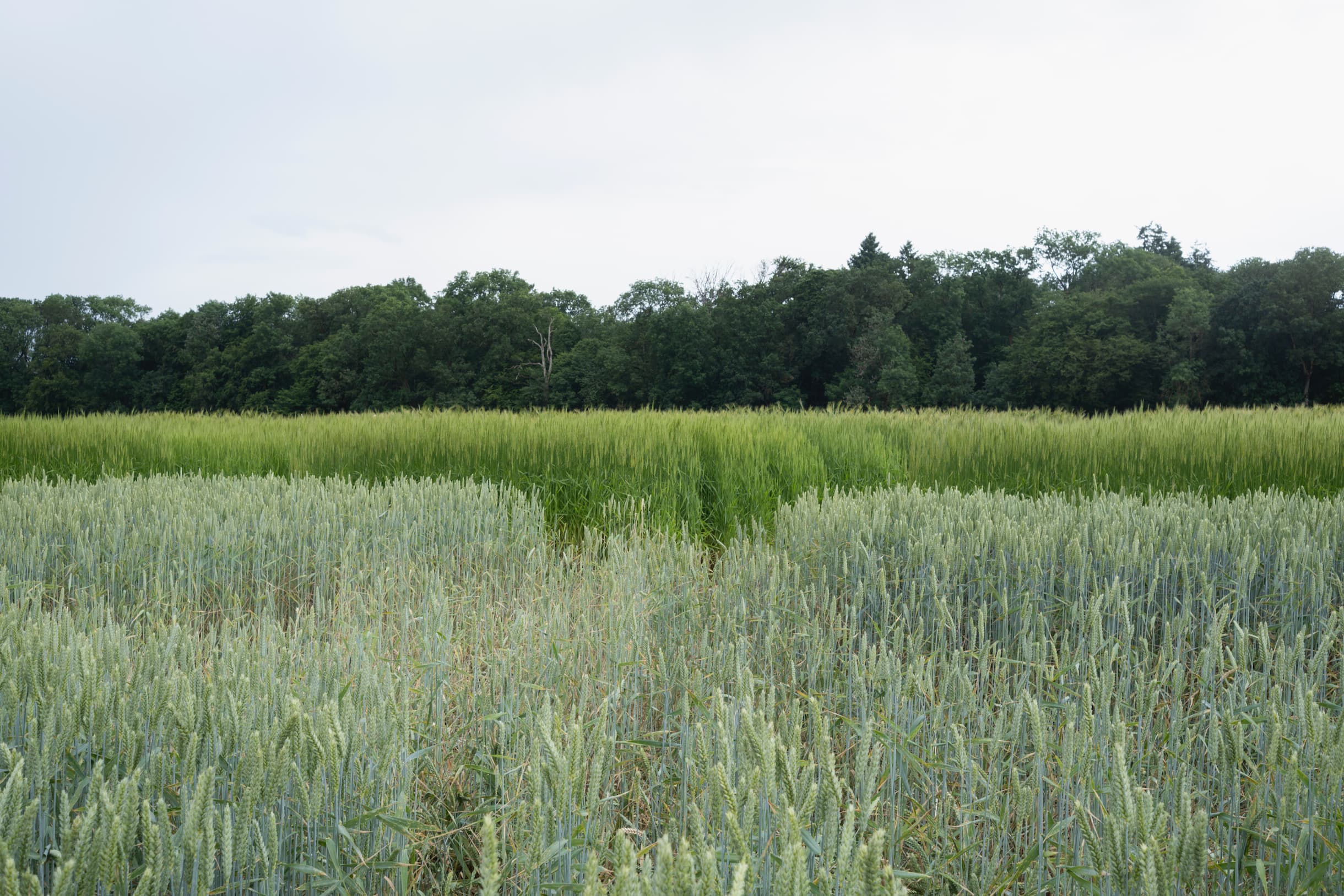




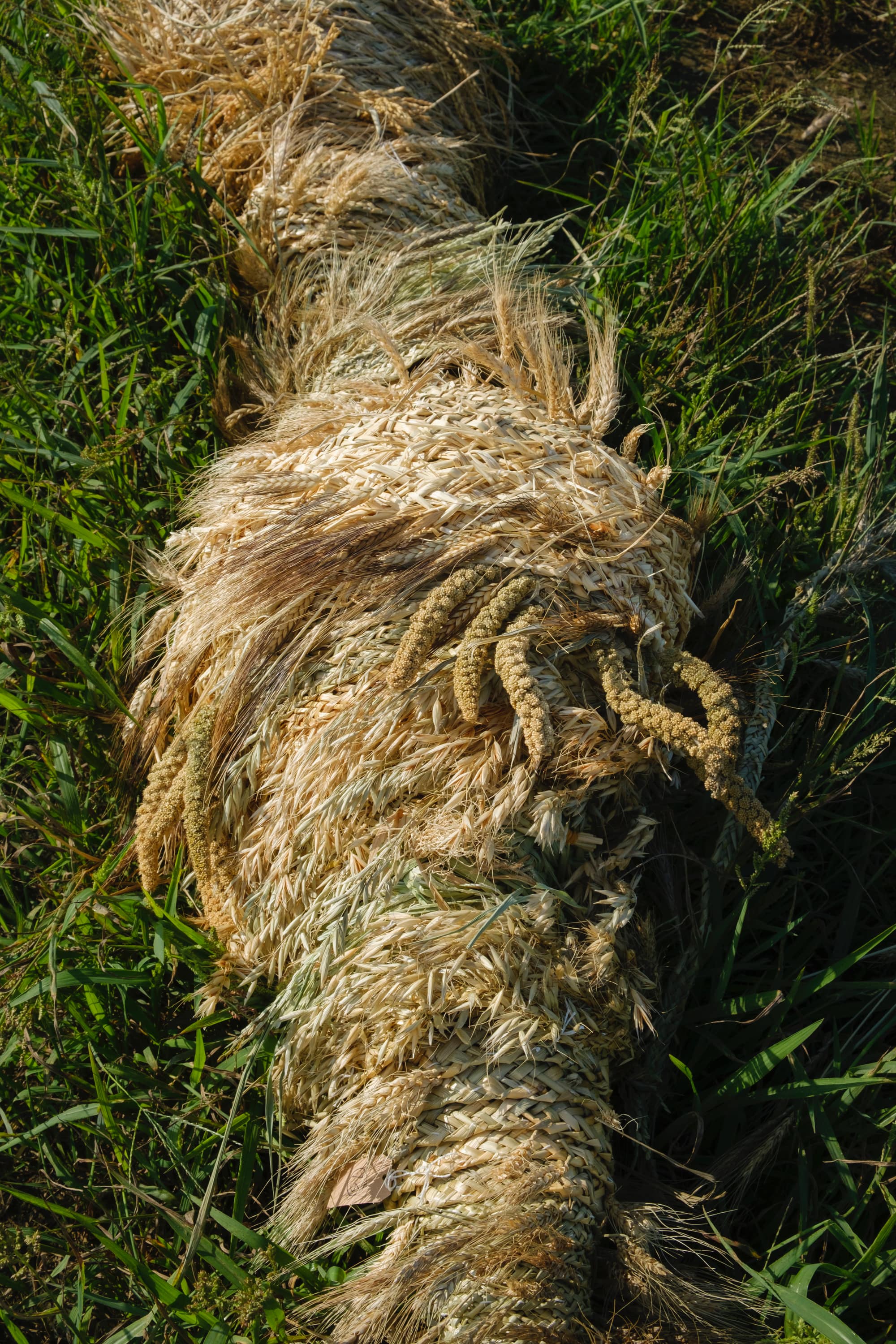

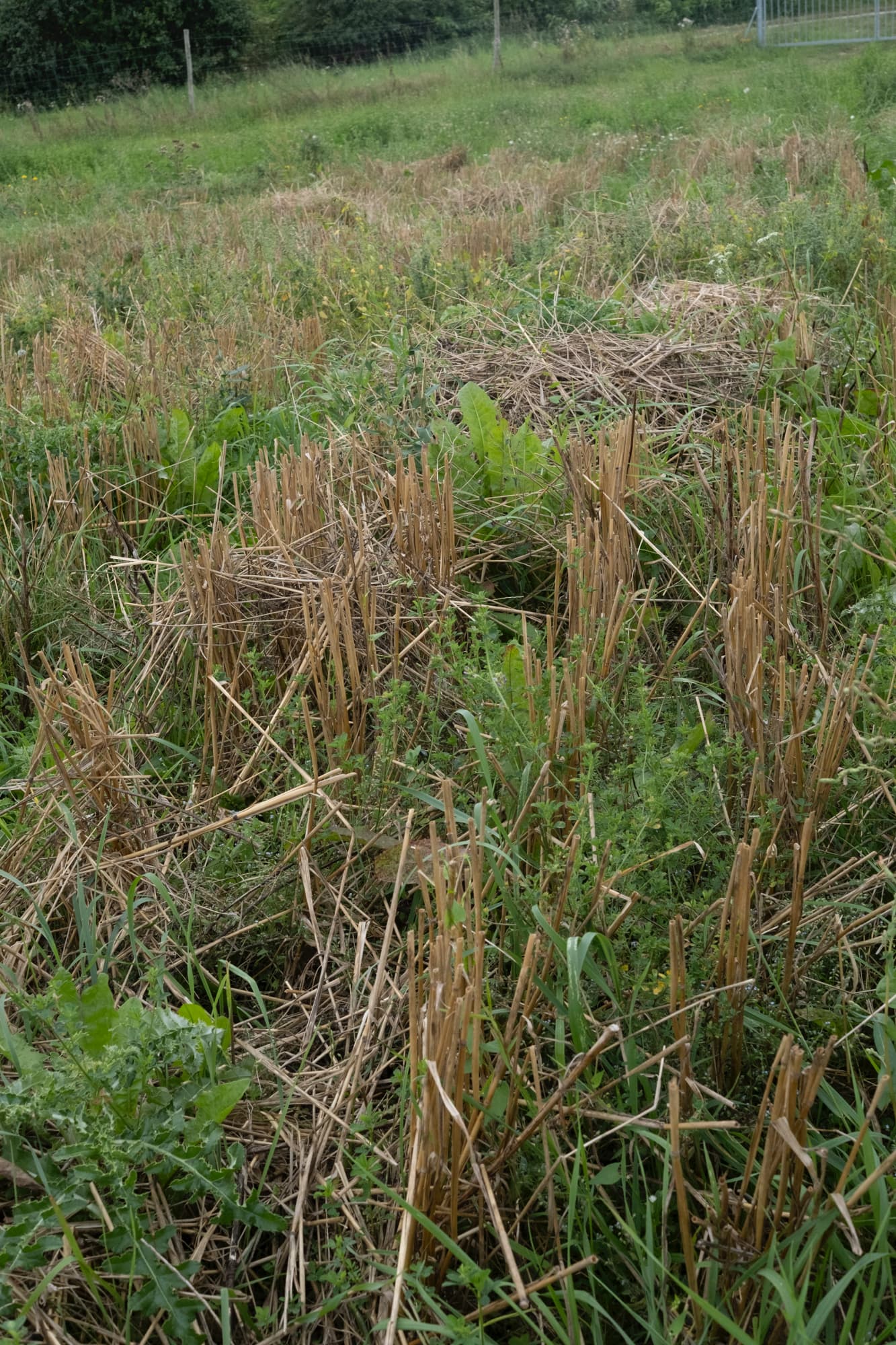

EAT: Transformative Seeds | 2024
Commercial project
Commissioned by: DesignSingapore Council
Curator: Fang Hu
Curatorial Team: Yue Liu, Shijia Huang, Xijing Xu and Yongxin Lai
Exhibition Design: Yuyu Fu
Illustration: Xiaodi Wang
Logistics: Haixing Fan
Volunteers: Kexin Zhao, Xuanzi Zhang, Wantian Wu
Photo credits: Fang Hu

EAT: Transformative Seeds is a food design exhibition revolving around seeds as a central theme, organized by Atelier Fang. The exhibition explores three main areas: culinary transformation and consumption, the propagation and migration of seeds, and the innovative use of food materials. Featuring works from ten countries, it ran from 26th September to 10th November 2024 at the National Design Centre in Singapore.
The exhibition has been divided into five sections:
POP POWER showcases the simplest and oldest methods of creative transformation with seeds. As a representative starting point, the first part of the showcase highlights the cultural significance of seeds from the perspective of taste, sound, and tool design through interactive experiences, products, and kinetic installations.
List of Exhibits:
Popped Grain Archive
The curatorial team / Yongxin Lai China
Popcorn Language
China Academy of Art / Ziye Li, Wei Zhang, Xiaodi Wang, Chenchen Yang China
Oncle Sam
ECAL / Laurent Beirnaet Anglo-Belgian, Pierre Bouvier French-Mexican, Paul Tubiana French
Grain Extruder Machine
Atelier Fang / Fang Hu, Haixing Fan, Yongxin Lai China
Popcorn Robot
Moritz Simon Geist, Jonas Engelhardt Germany
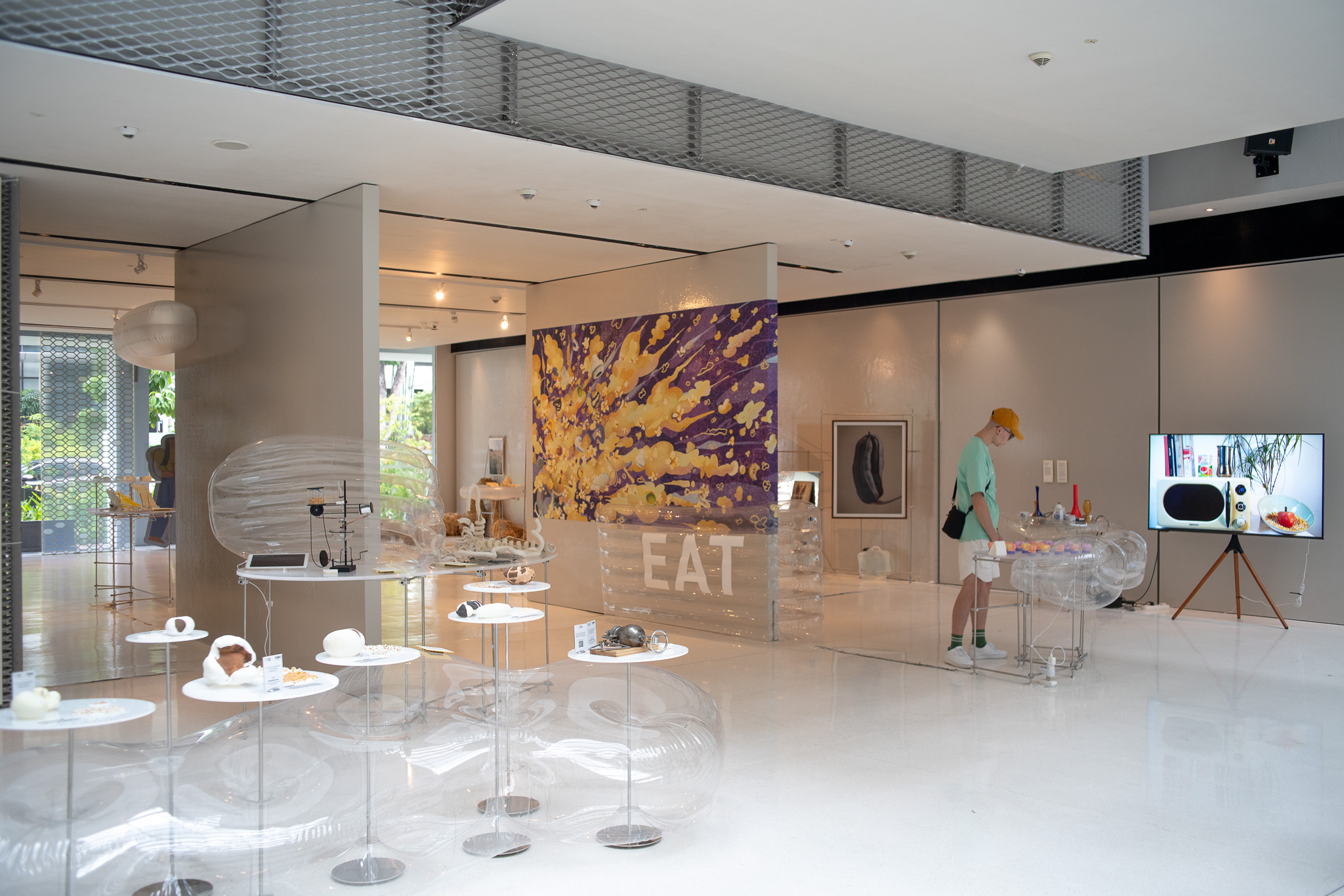


A BITE OF SEEDS mirrors the beauty of nature and the development of human civilization. Discover the narratives of seed wandering, migration, and evolution through works developed to detail these stories in the context of history.
List of Exhibits:
The Hidden Beauty of Seeds & Fruits
Levon Biss UK
Self-burying Seed
Danli Luo, Aditi Maheshwari, Andreea Danielescu, Jiaqi Li, Yue Yang, Ye Tao, Lingyun Sun, Dinesh K. Patel, Guanyun Wang*, Shu Yang*, Teng Zhang*, Lining Yao* International Team
*Corresponding Authors
Edible Echoes
Domingo Club by Maud Bausier and Antoine Jaunard Belgium
Living Necklace: A Cycle of Growth
Domingo Club by Maud Bausier and Antoine Jaunard Belgium
We.Wheat.Weave
tofoodesign by Xijing Xu and Yue Liu China


SEEDING BEYOND captures the fervor of designers as they venture into the realm of food materials. Inspired by ancient cooking techniques, they redefine food's purpose, transforming it into practical objects. This innovative approach, seen through a laboratory lens, expands food usage beyond nourishment, creating everyday items with a touch of ingenuity.
List of Exhibits:
Zero Waster System: Expandable Porous Material
Koh Zhi Hong Benjamin Singapore
Faba-Forma
Nikoleta Dimova Bulgaria
Taco
ECAL / Anouk Quillet Switzerland
Bubbling Bricks, A Crafting Exploration
Atelier Fang / Fang Hu, Shijia Huang China
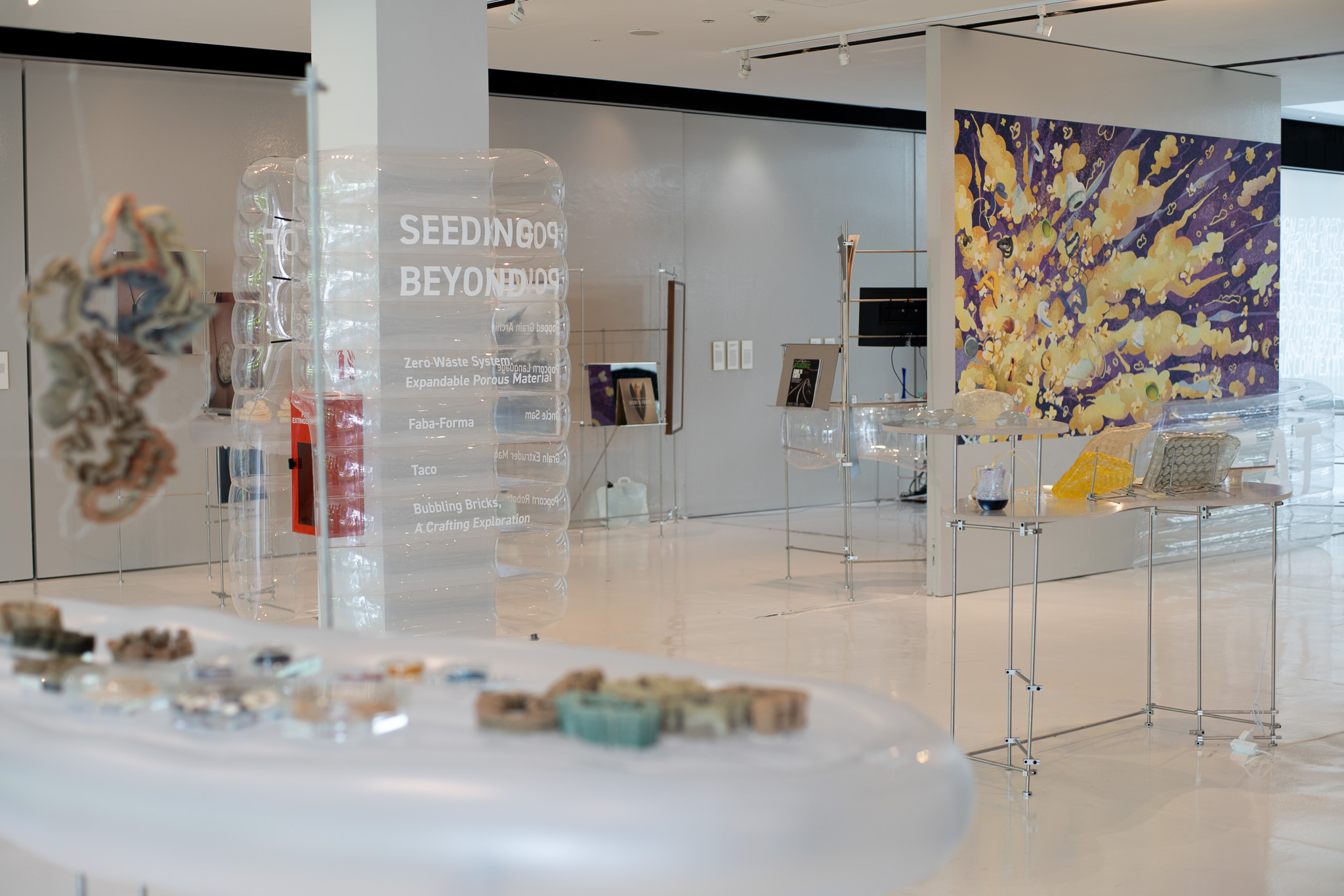


To celebrate and highlight the contributions of remarkable individuals in the world of Food and Design, we present SEEDS OF VISION, a special chapter that reflects on the role of seeds. Finally, at the end of the exhibition, visitors can explore the READING CORNER, which offers recipes and books related to Food and Design, covering topics such as politics, culture, material, science, urbanism and community.
List of Contributors:
Honey & Bunny / Dr. Sonja Stummerer and Martin Hablesreiter
Bompas & Parr / Sam Bompas
Marije Vogelzang
Hans Tan
Martí Guixé
Francesca Zampollo
tofoodesign / Xijing Xu and Yue Liu
Serena Crocco
Anouk Quillet
Ming Liang
Lining Yao
Warren Kuo
Janine Fiedler
Guanqi Li
Tianle Chang
Xin Wang
Yongxin Lai

EAT: Transformative Seeds is part of the People of Design Showcase Series, a key event of Singapore Design Week 2024 curated by Hans Tan together with a team of designer-curators. Ten showcases presented across the Bras Basah.Bugis Design District creatively examine the rituals of daily life through the lens of design, where each showcase delves into a specific activity such as Eat, Sleep, Shop, Read, Heal, Make, Plant, Commute, Display and Design. Through new works and collaborative projects, visitors will discover imaginative design possibilities shaped to offer fresh perspectives on the world around us, inspiring new ways of thinking, seeing, and experiencing daily life.
A++ Recipe | 2024
Initiative project
Commissioned by: DesignSingapore Council
Concept and Design: Fang Hu, Yue Liu, Yongxin Lai, Shijia Huang and Xijing Xu
Photo credits: Yongxin Lai, Fang Hu and Studio Wongs
A++ Recipe: Co-creating Speculative Stories & Recipes is an exploration of Singapore's culinary heritage, brought to life through two local workshops in July 2024. Collaborating with Tipo Pasta Bar, this initiative is part of the research for EAT: Transformative Seeds, celebrating the richness of Singapore’s food culture.
The name A++ stands for:
-
Appetising: Create a delicious dish not only in the way of tasting but also visually attractive.
- Appealing: Design a multi-sensory appealing presentation and not in a common appearance.
- Accessible: Ensure easy access to ingredients and cooking methods for all, celebrating simplicity without compromising on flavor or authenticity.


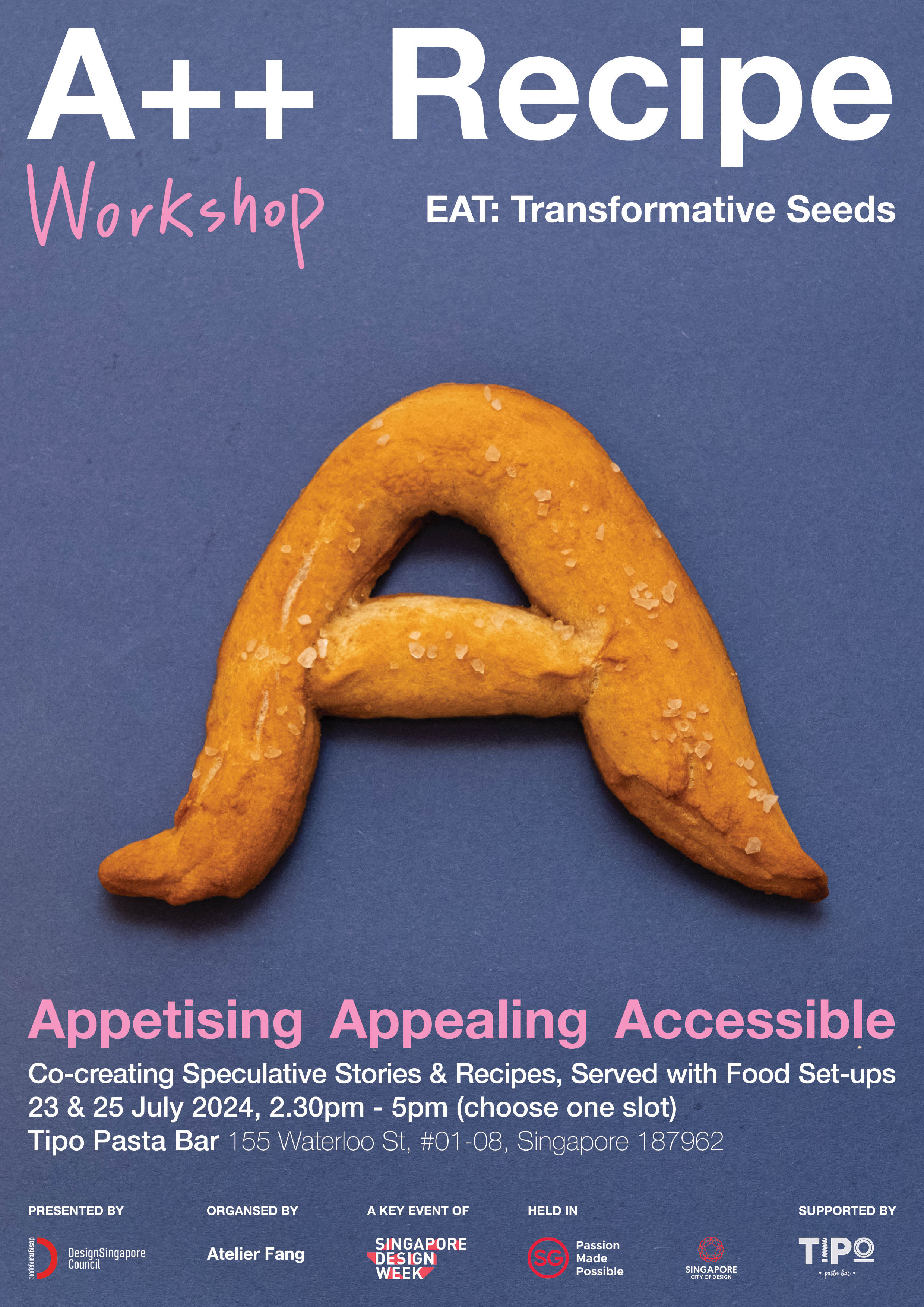

The workshops began with a shared food experience—popped seeds and seed-related snacks prepared in-house at Tipo Pasta Bar. This setup invited participants to explore flavors and provide feedback that shaped a special menu for Singapore Design Week 2024.

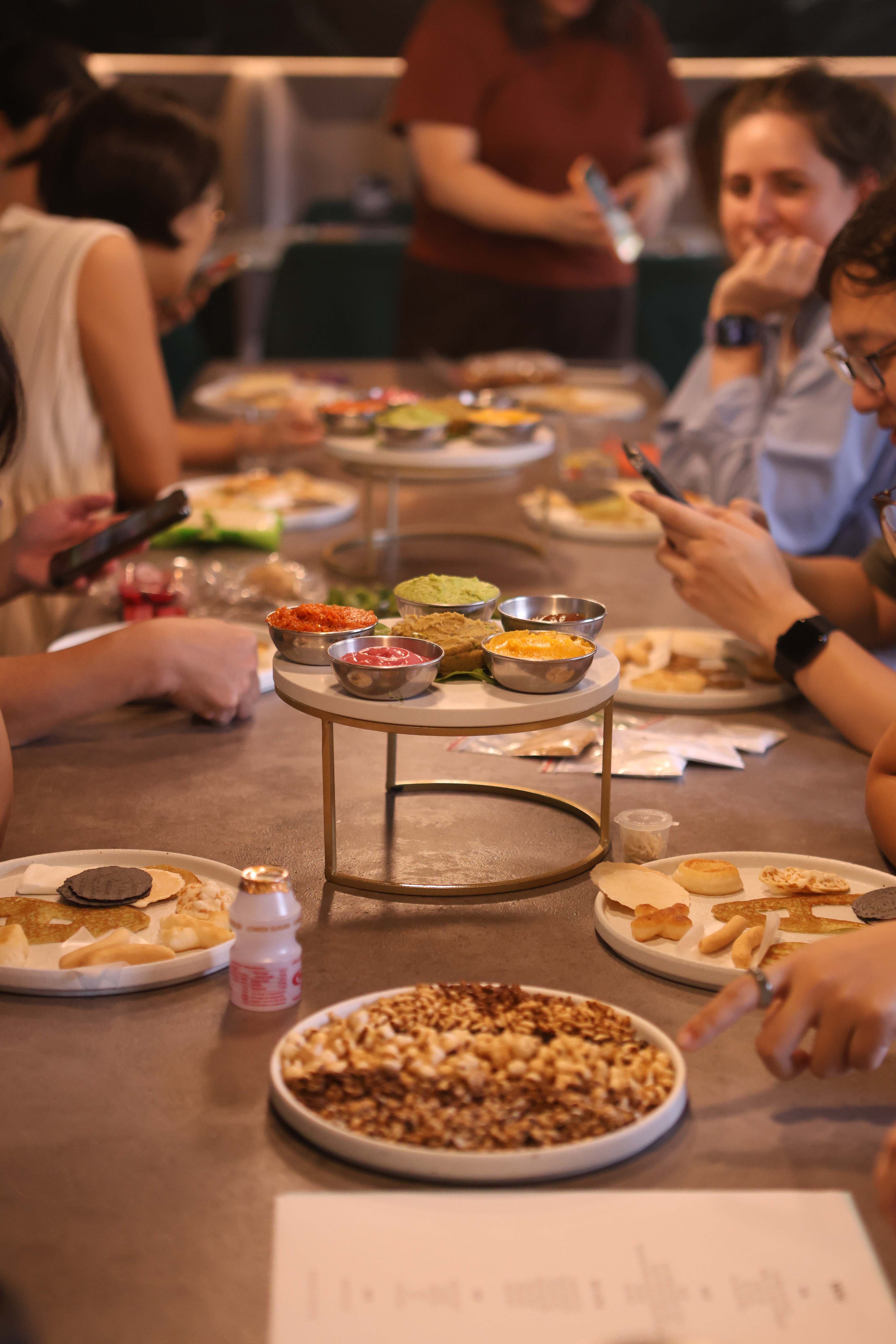
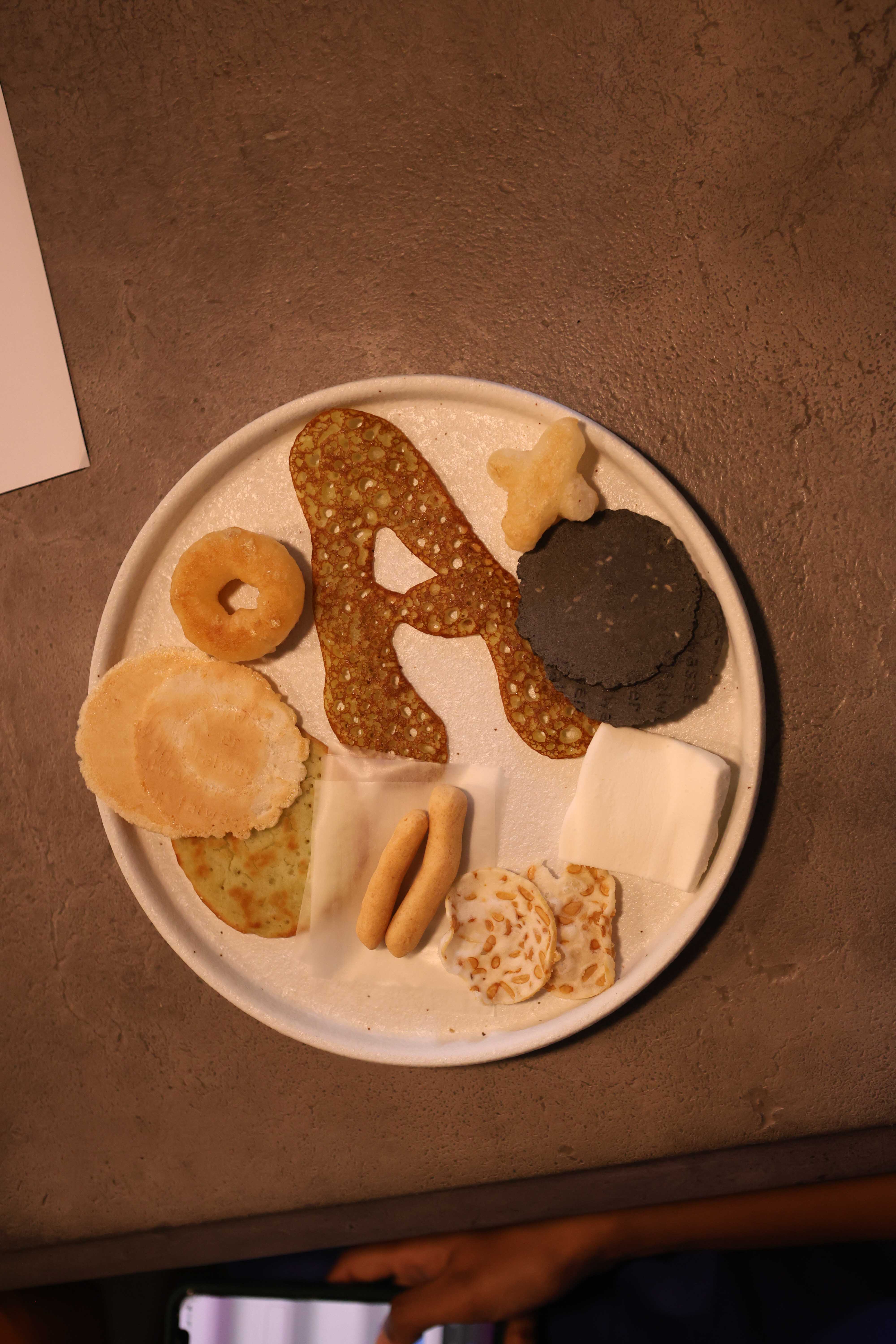


Participants were encouraged to bring objects holding significant food-related memories or stories. Through these, they introduced themselves and shared personal narratives. Using their objects as “raw materials” and “Ingredients Cards”—inspiration cards with visual and textual prompts designed to spark creativity—they brainstormed and transformed taste and cultural memories into specific dishes reflecting Singapore's cultural diversity, social context, and rich flavors.
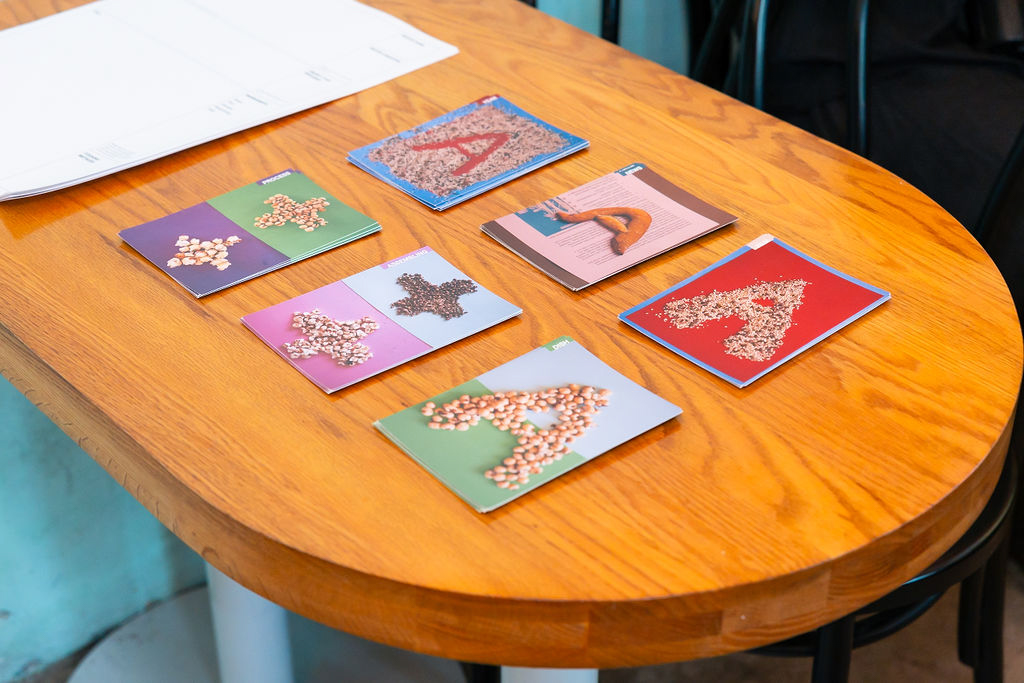

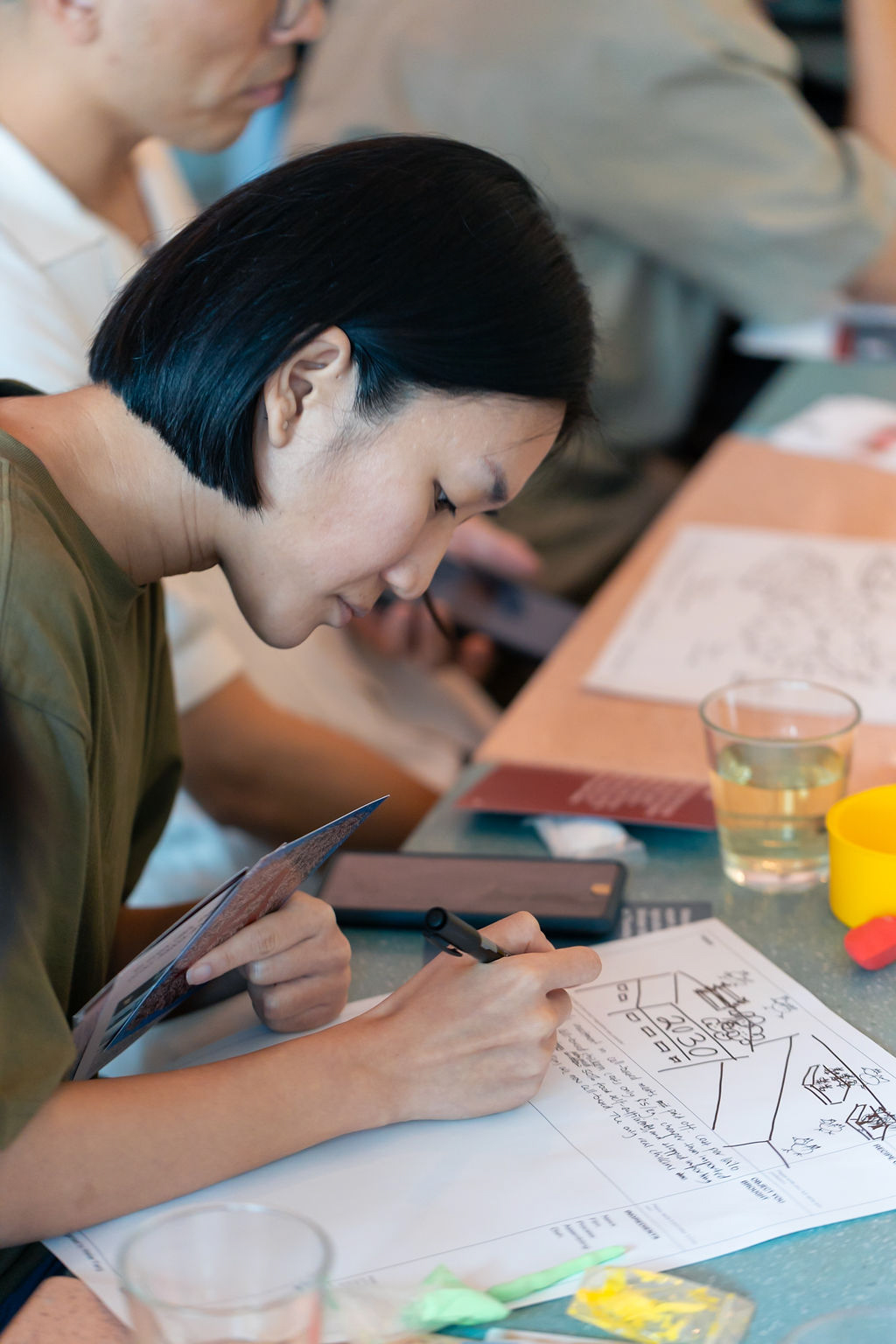
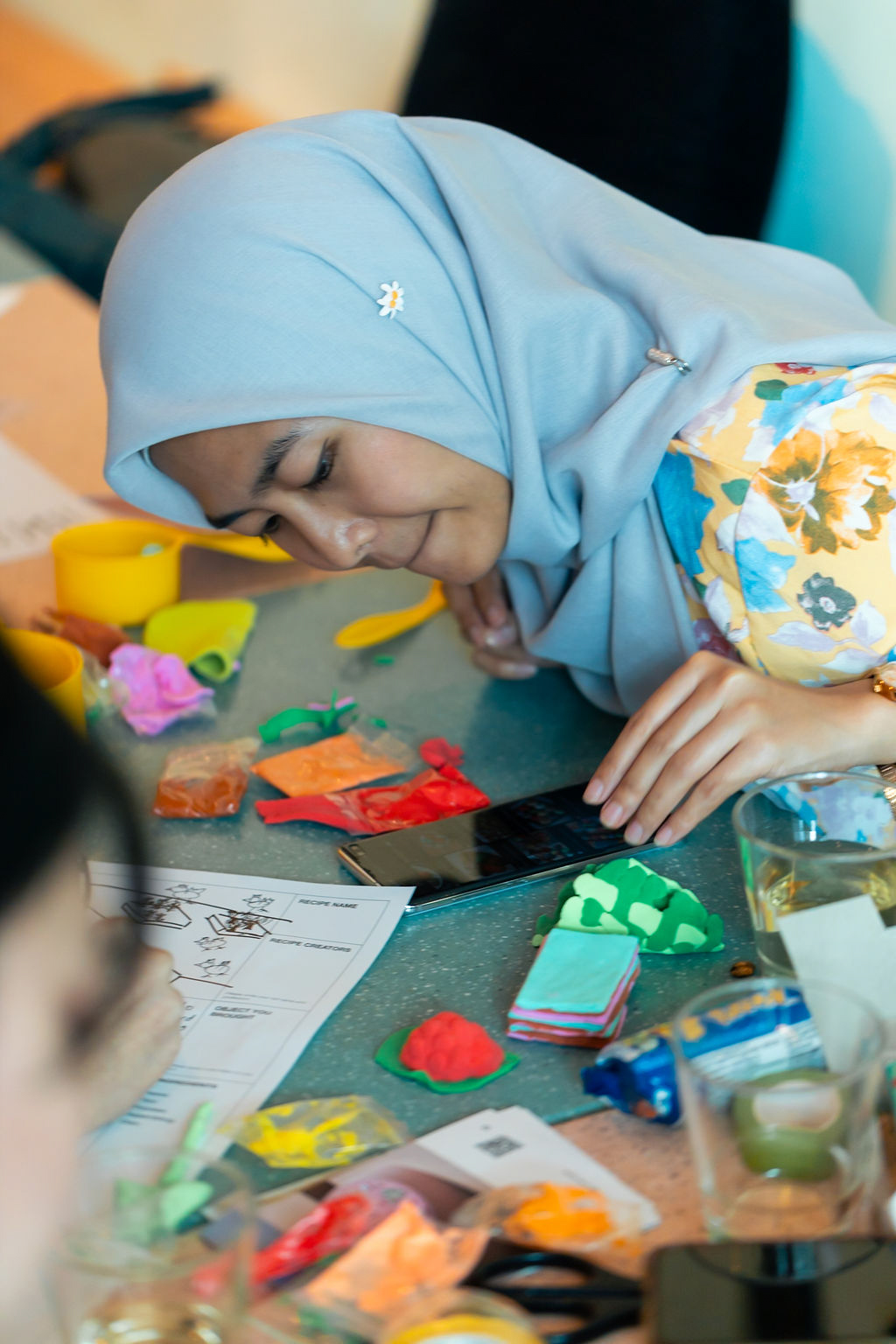
Recipes were documented by participants on A3 templates, resulting in 10 speculative and conceptual creations. The design team “baked” these recipes into 3D sculptures, showcased in the thematic exhibition area DESIGN at Singapore Design Week 2024.
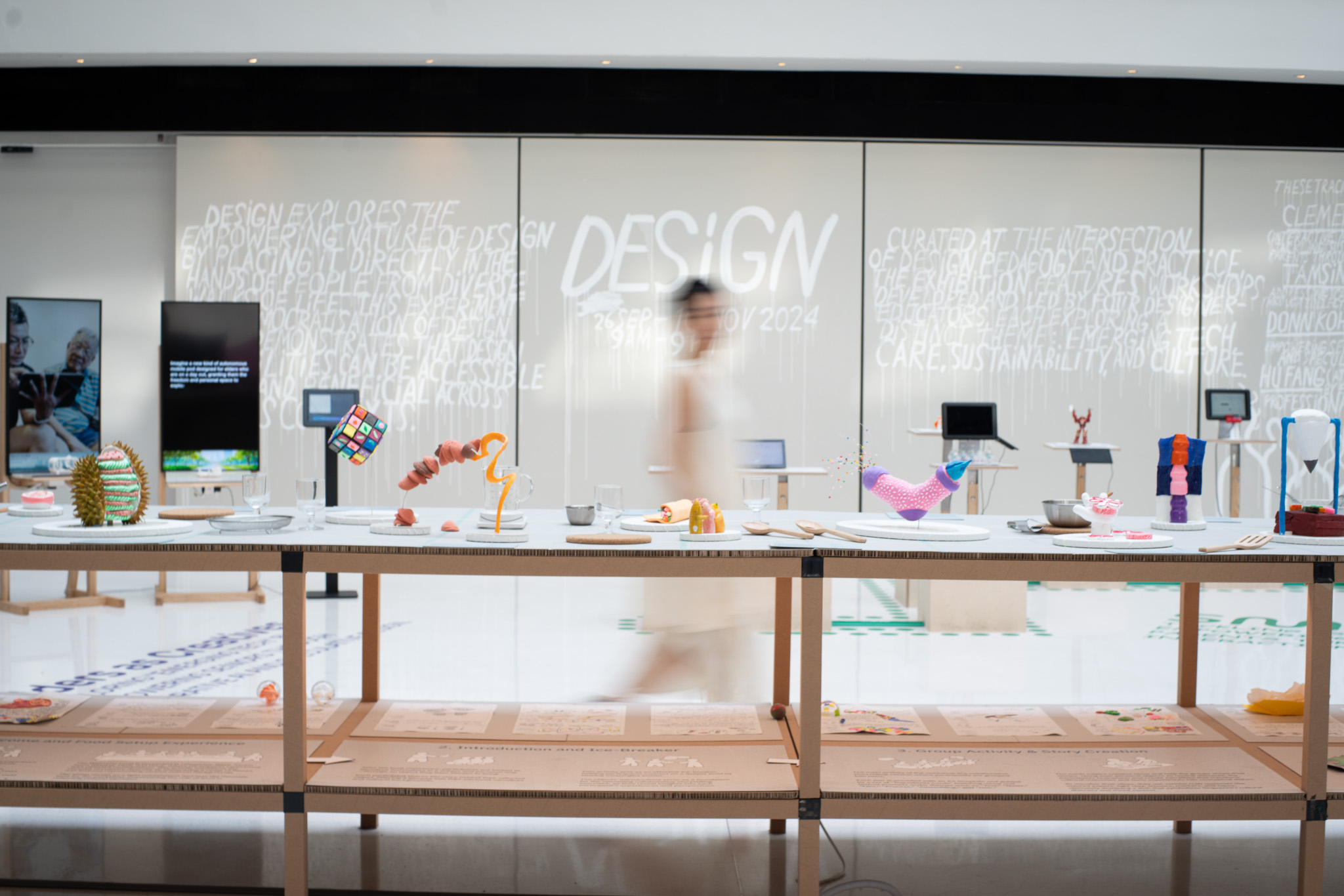


Fortune Desserts | 2022
Initiative project
Commissioned by: abC Art Book Fair
Concept and Design: Xijing Xu and Yue Liu
Photo credits: Xi Chen, Xinyi Tian, Xiaoyu Zhao and abC Art Book Fair

Invented by the Japanese in the 19th century, fortune cookies have traveled overseas along the paths of immigrants and were carried forward by Chinese-Americans throughout the turbulent history. It is presented in the Chinese restaurant at the end of the meal as an alternative to dessert. This humble biscuit, not well known in the East Asian Chinese-speaking world, has gradually become the ambassador of Chinese food overseas. In Chinese restaurants in Italy, a large bowl is often placed at the entrance counter, from which customers can take a fortune cookie at the checkout. For those of us who grew up in mainland China and moved to Europe, it is a moment of re-encounter with the East Asian immigrants of a century ago, thousands of miles away from home.
On the map of food wandering, we trace the history of human migration and movement between continents and oceans and the trajectory of their personal lives. At the end of the exhibition, we have embedded some dessert recipes from our cross-cultural life experiences into the fortune cookies as a 'post-exhibition dessert'. We hope these recipes will also find their way into your kitchens, to achieve their cultural wandering and our taste wandering across borders.
The project has been presented as one of the special projects in the thematic exhibition area at The 7th abC Art Book Fair · Beijing.
Installation details
![]()
![]()
![]()
![]()
![]()
![]()
![]()
![]()

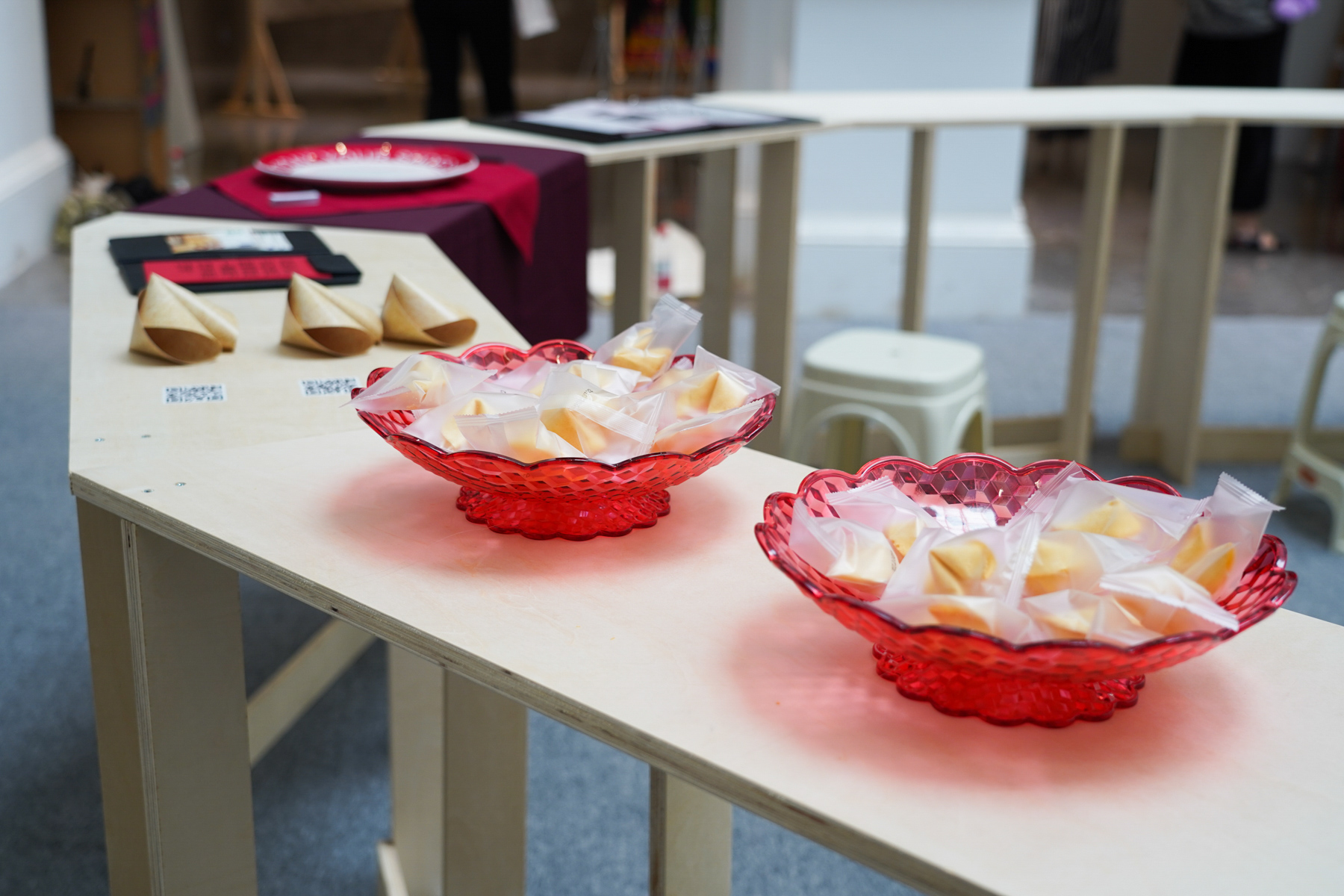
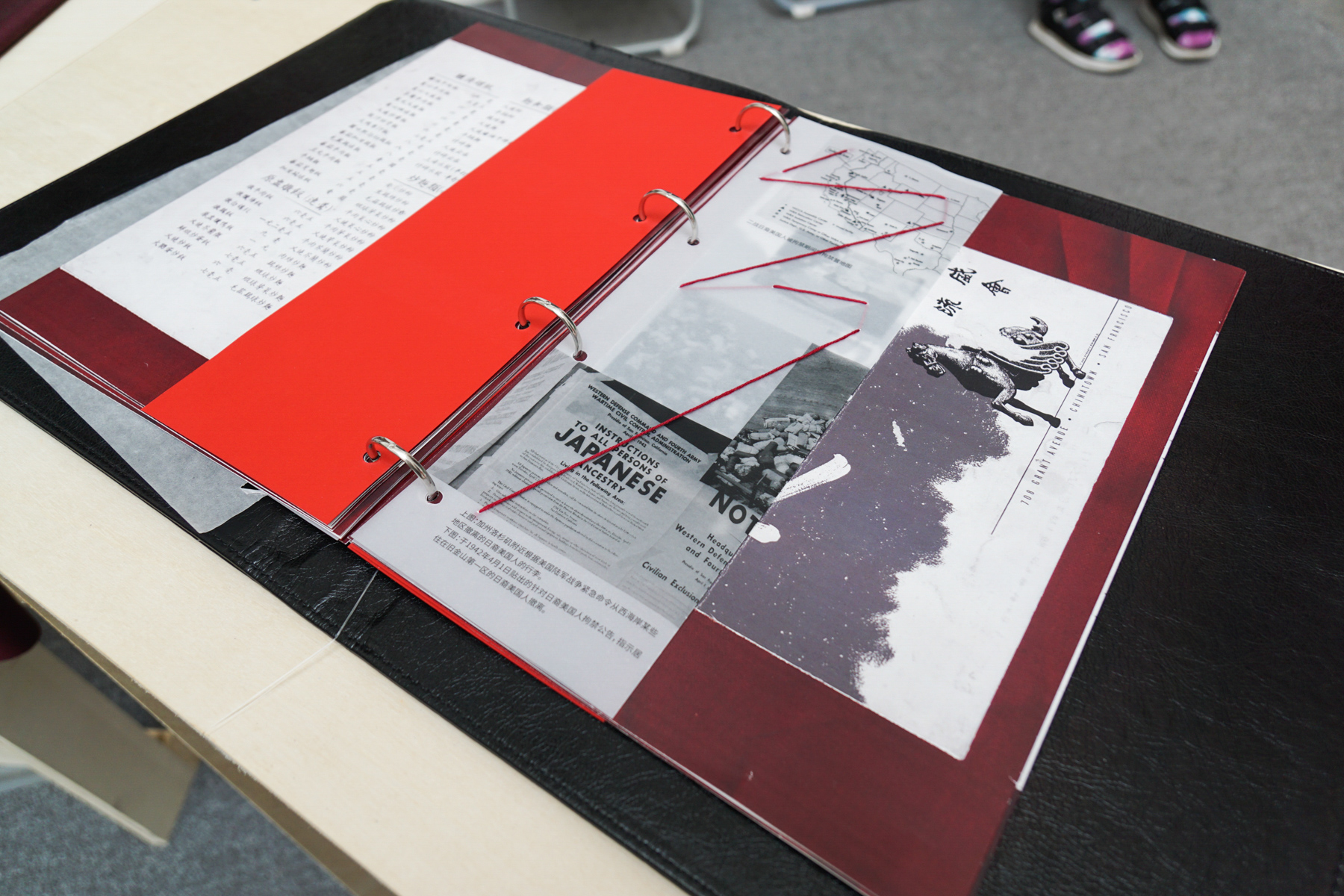


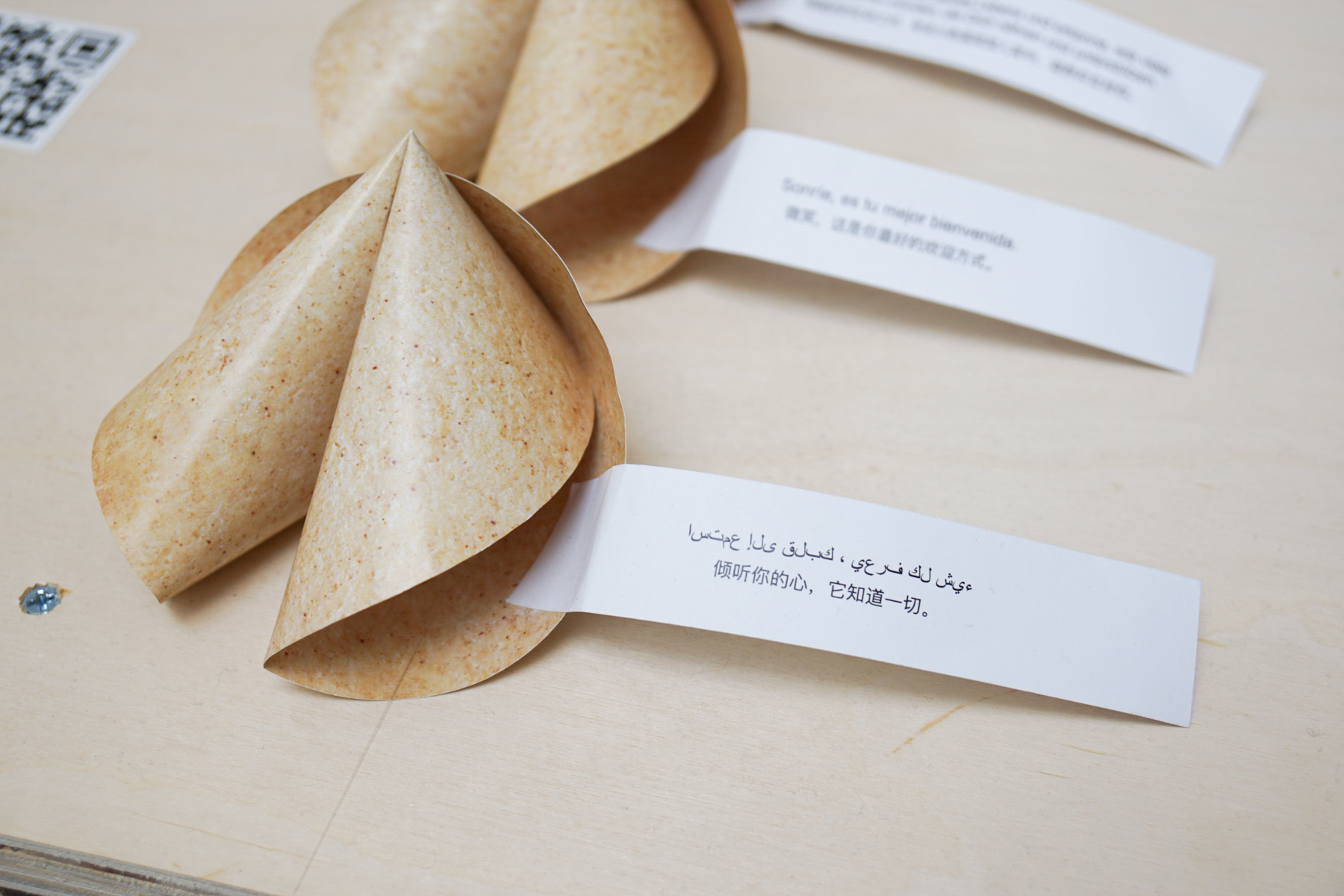
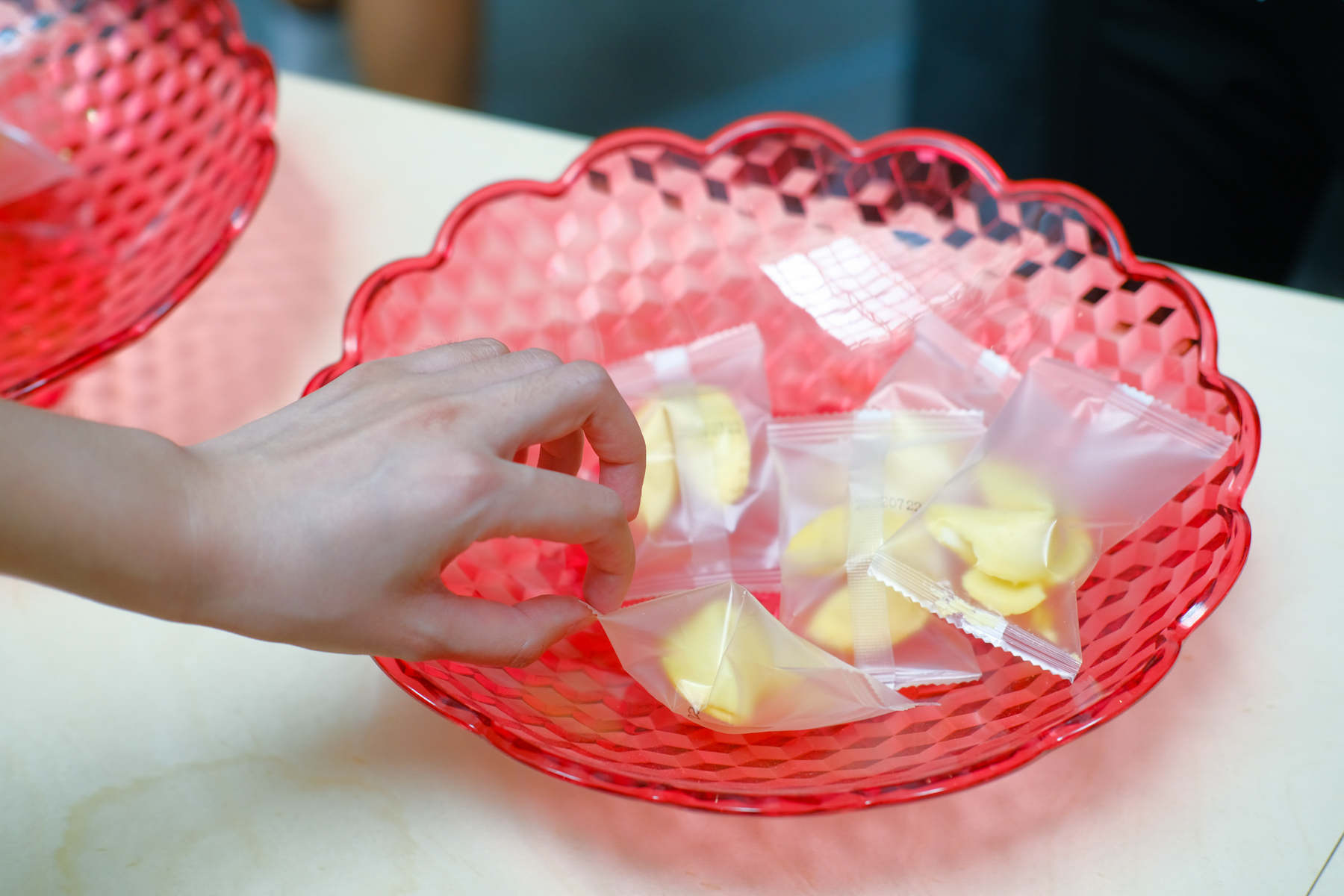
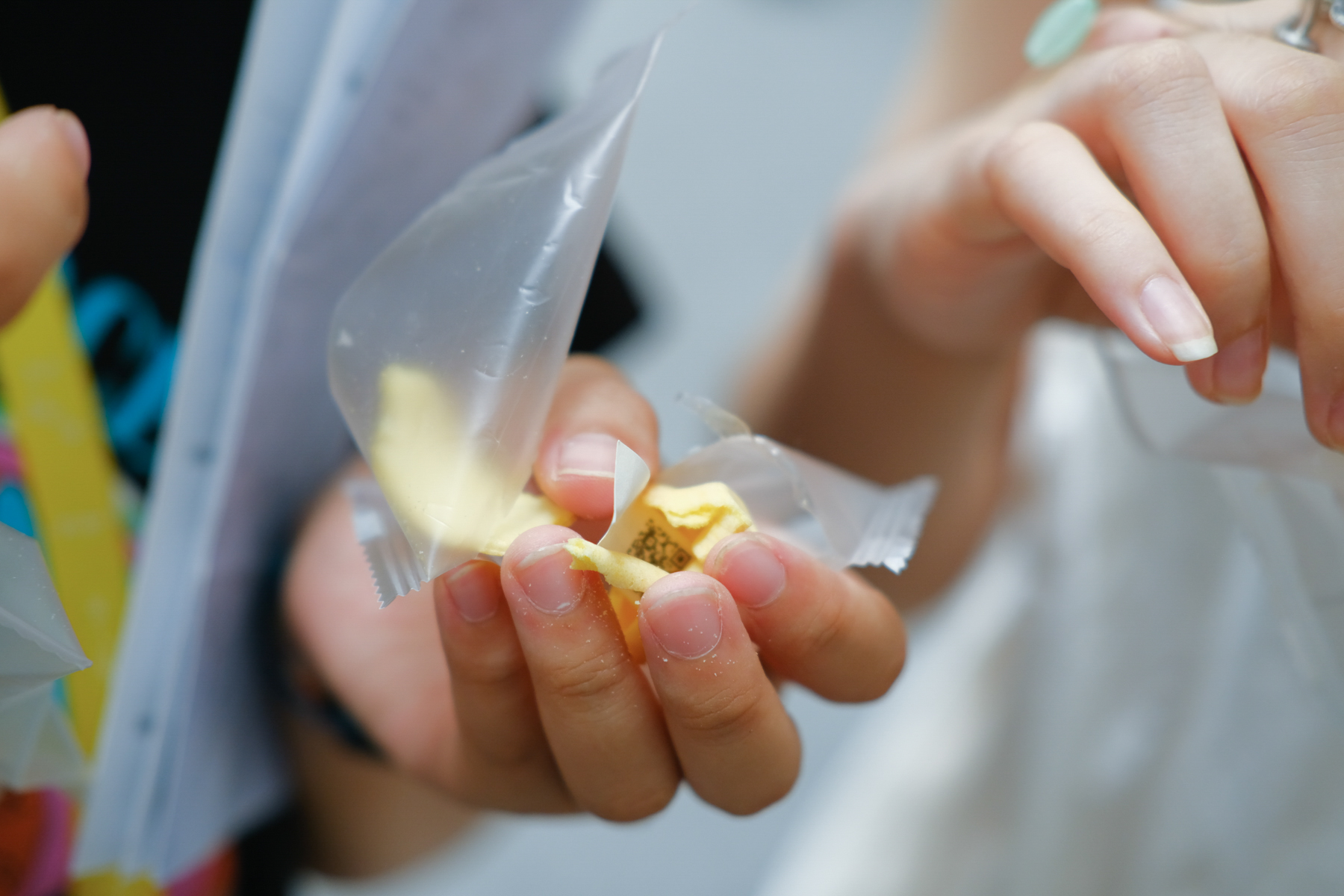
Exhibition Scenes
![]()
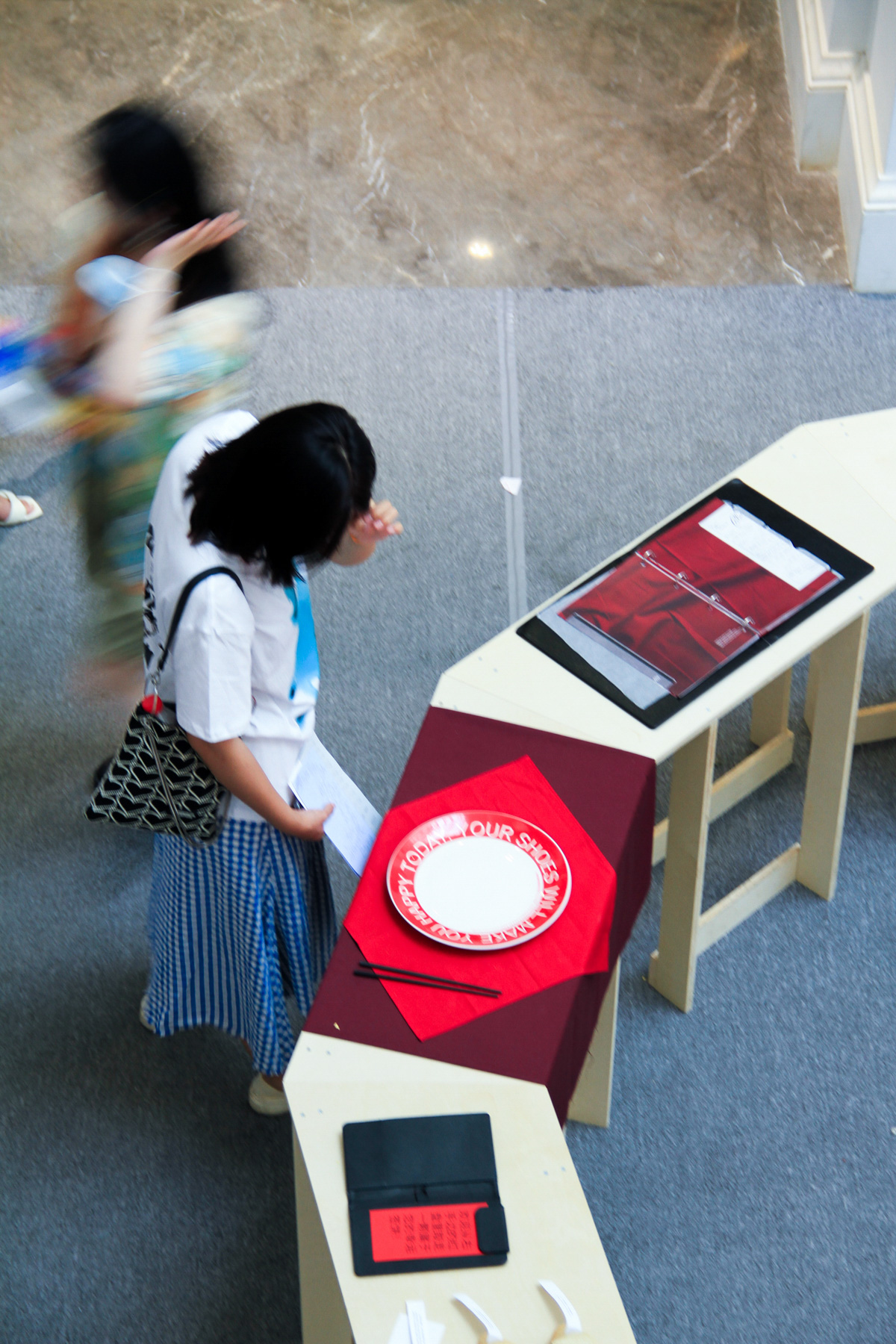
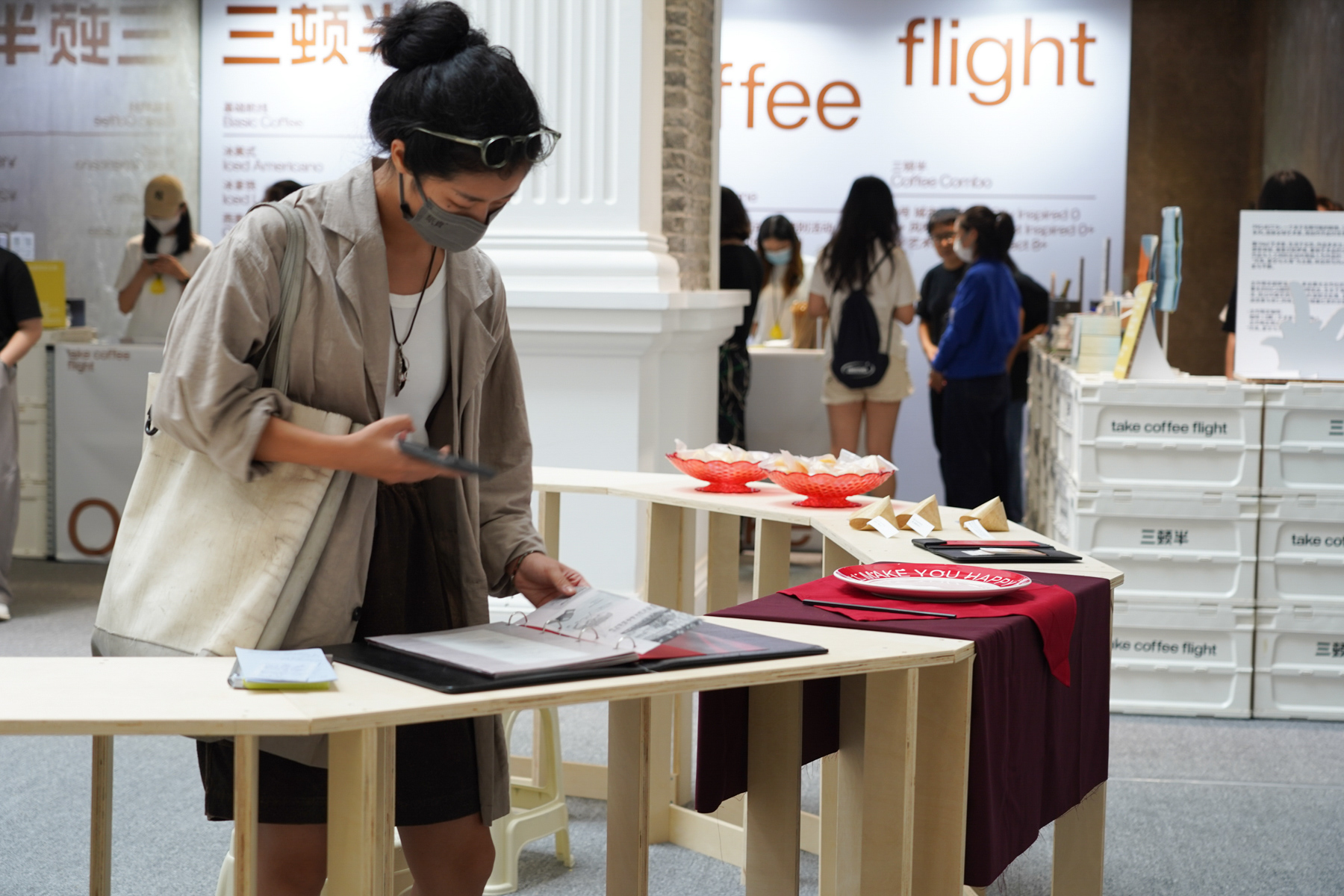

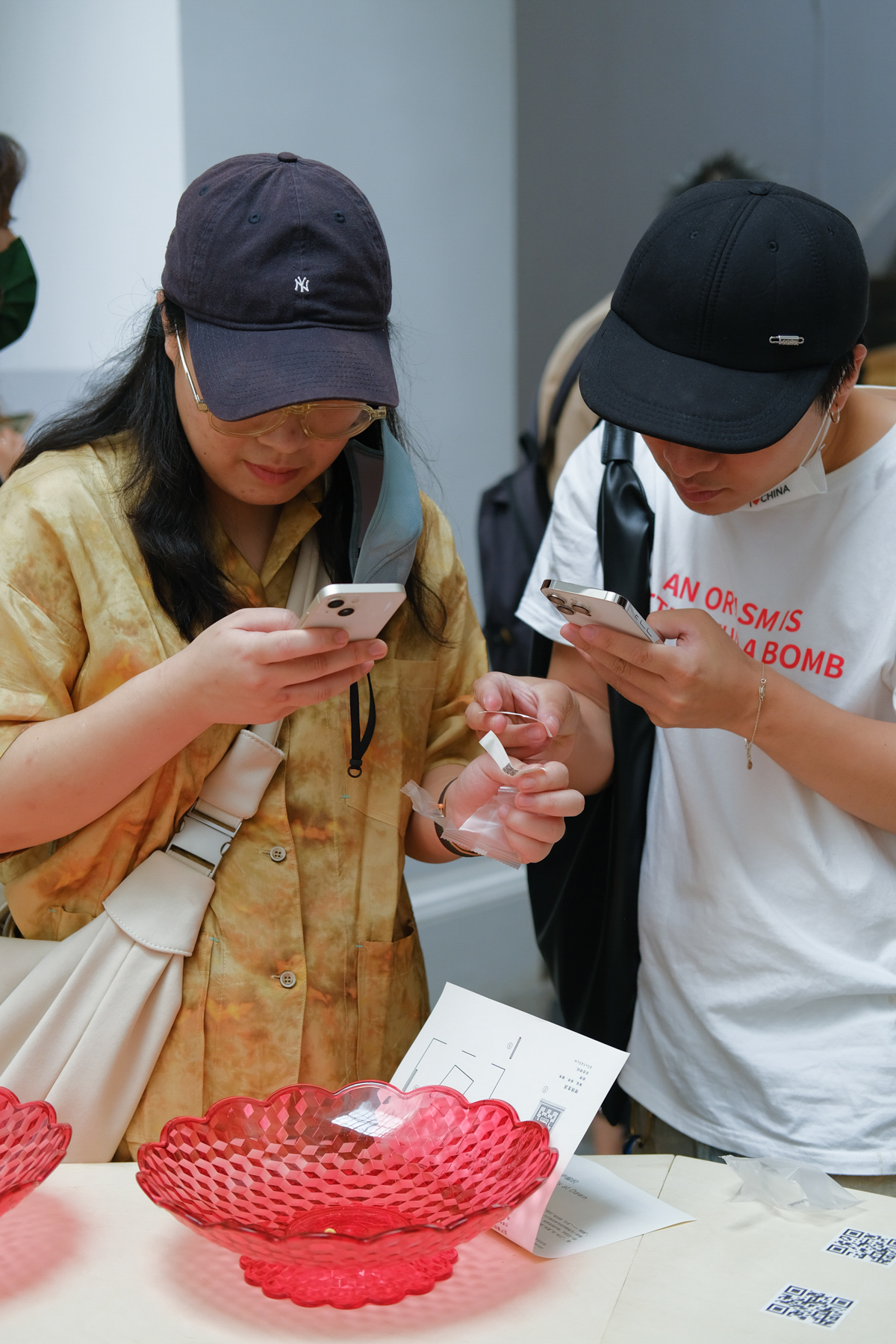
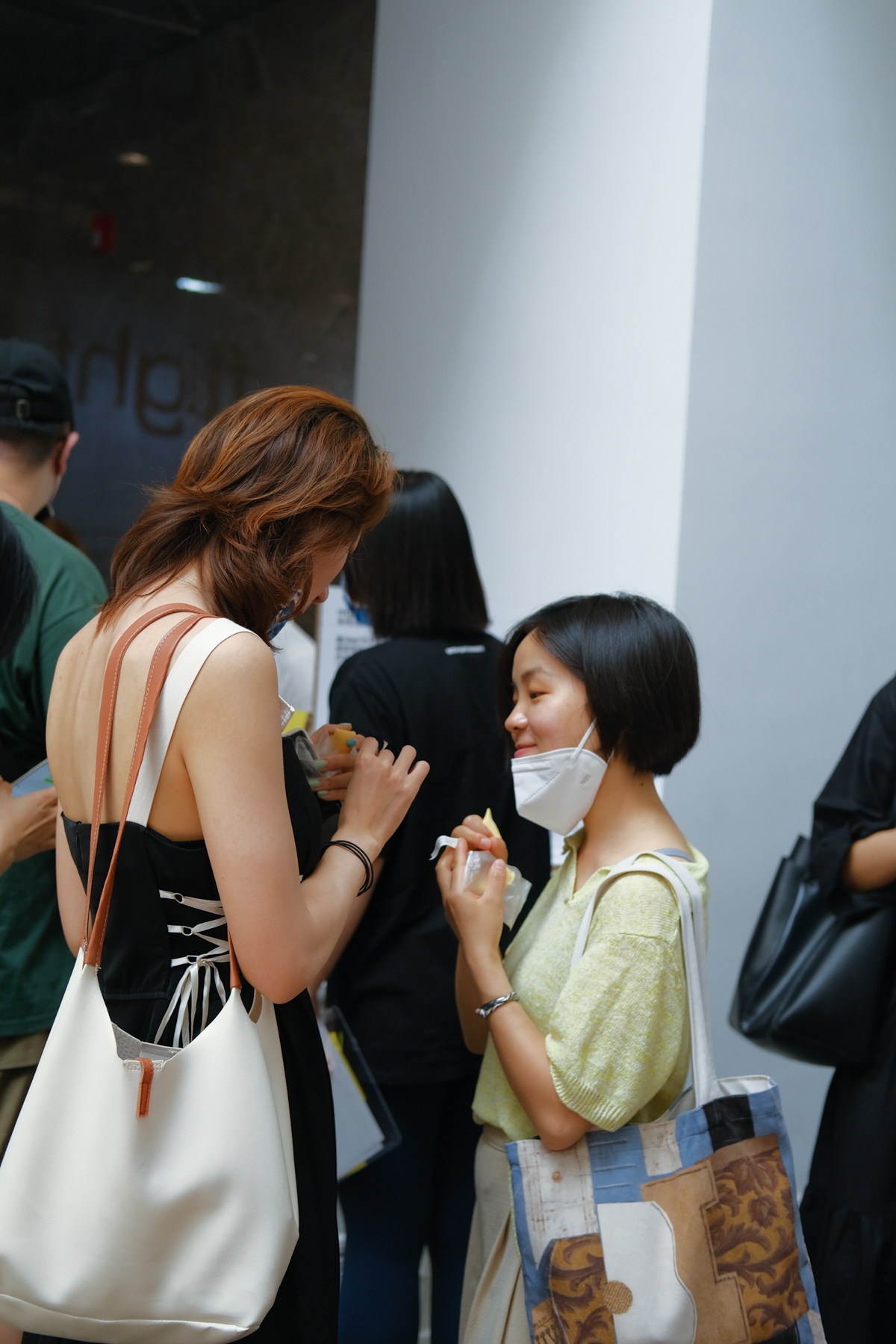

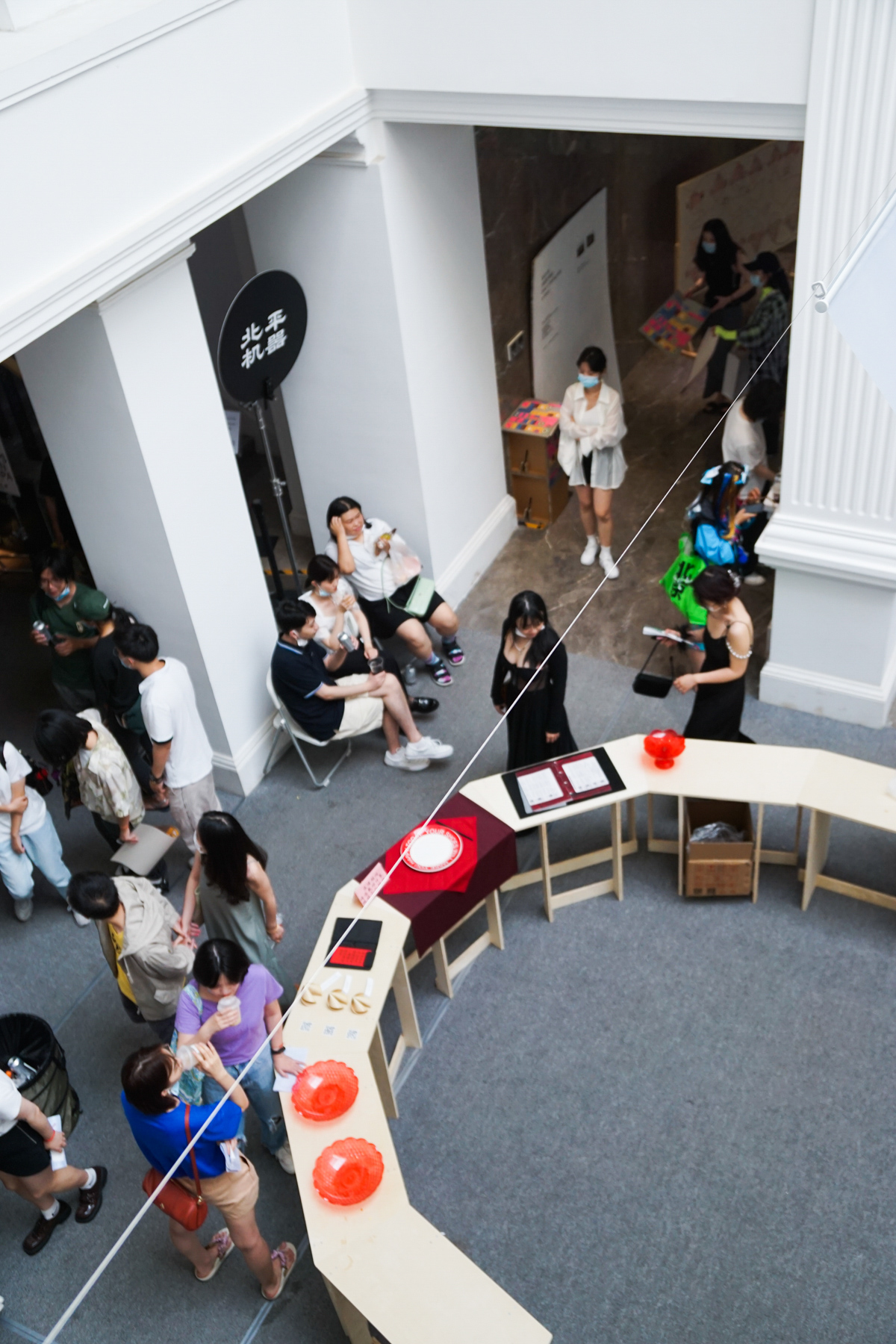
RISO.Edutainment | 2021
Commercial project
Commissioned by: POLI.design
Concept and Design: Yue Liu, Xijing Xu and CILAB team (Arianna Vignati /Project Management, Luca Fois /Design Consulting, Elena Stefani /Graphic Design, Camilla Fraboni /Project Assistance)
RISO.Edutainment is a project for the Distretto Rurale Riso e Rane, in collaboration with CILAB of Politecnico di Milano. The project aims to trigger a path of innovation for the district to develop an organizational model parallel and integrated to the productive one. The focus is on the implementation of strategies for developing edutainment services, distribution and digital communication, implementing a process of synergistic and transversal work on all areas, carried out in parallel. The project contains three main tasks: Innovation of audience engagement processes; Development of new edutainment services; Research and Design of new distribution processes. tofoodesign was commissioned to occupy some parts of task 2 and task 3.
E-commerce collaboration with PAM Panorama
In order to widen and expand the distribution of the products, contacts were made with several stores and supermarket chains, which led to the collaboration with the supermarket chain PAM Panorama. Ad hoc packaging has been designed for PAM.
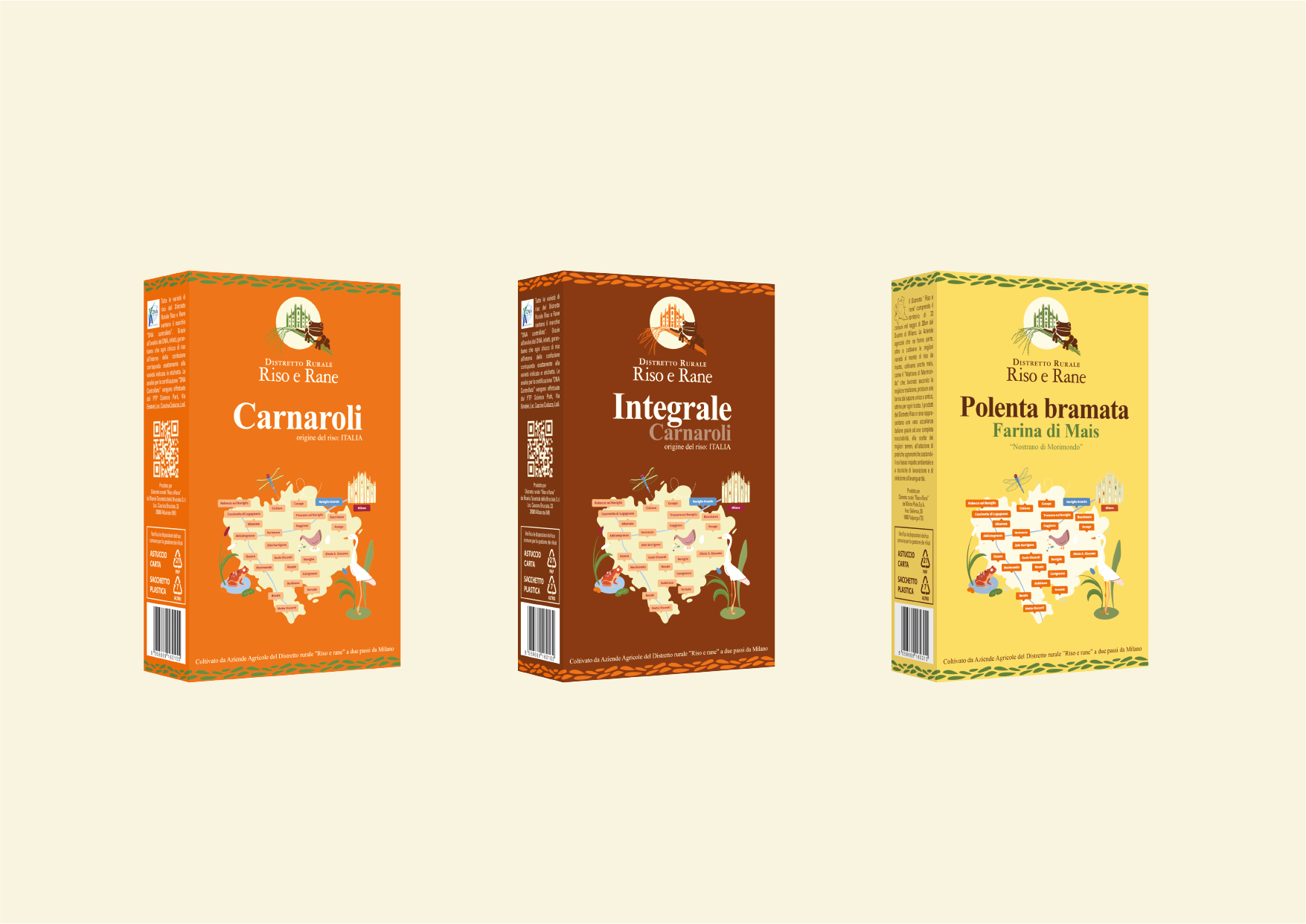
Research and Design for modular exhibition stands
The decision to design modular touring stands resulted from in-depth research into the narration and display of products. It aimed to create a project that would enhance the value of rice as a product, recount its history and potential and be representative of the district and a community. After outlining two main design solutions, we decide to design a modular exhibition stand, adaptable to different occasions and spaces, suitable for the sale of products, the story and communication of the district and the organization of show cooking and workshops.


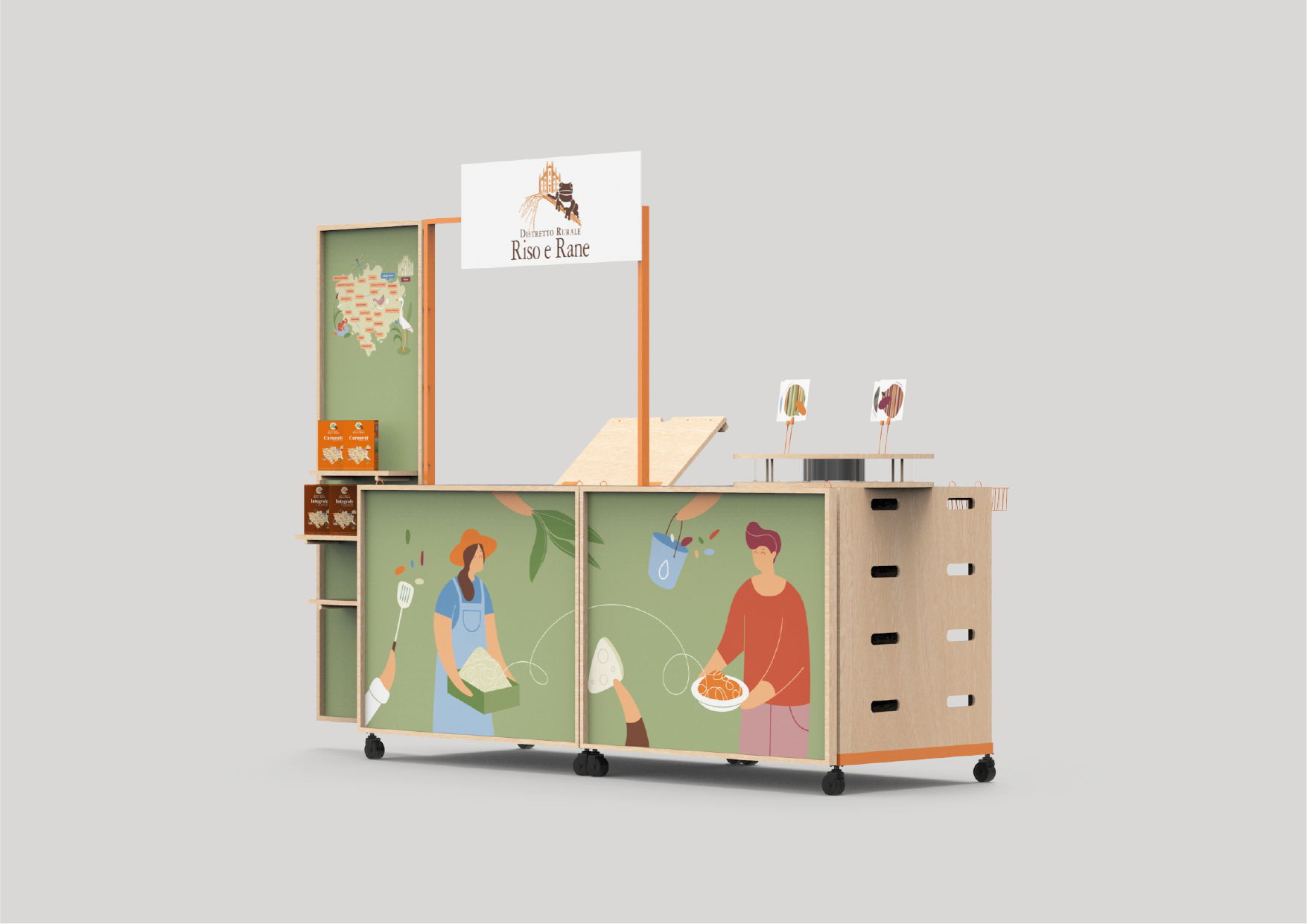
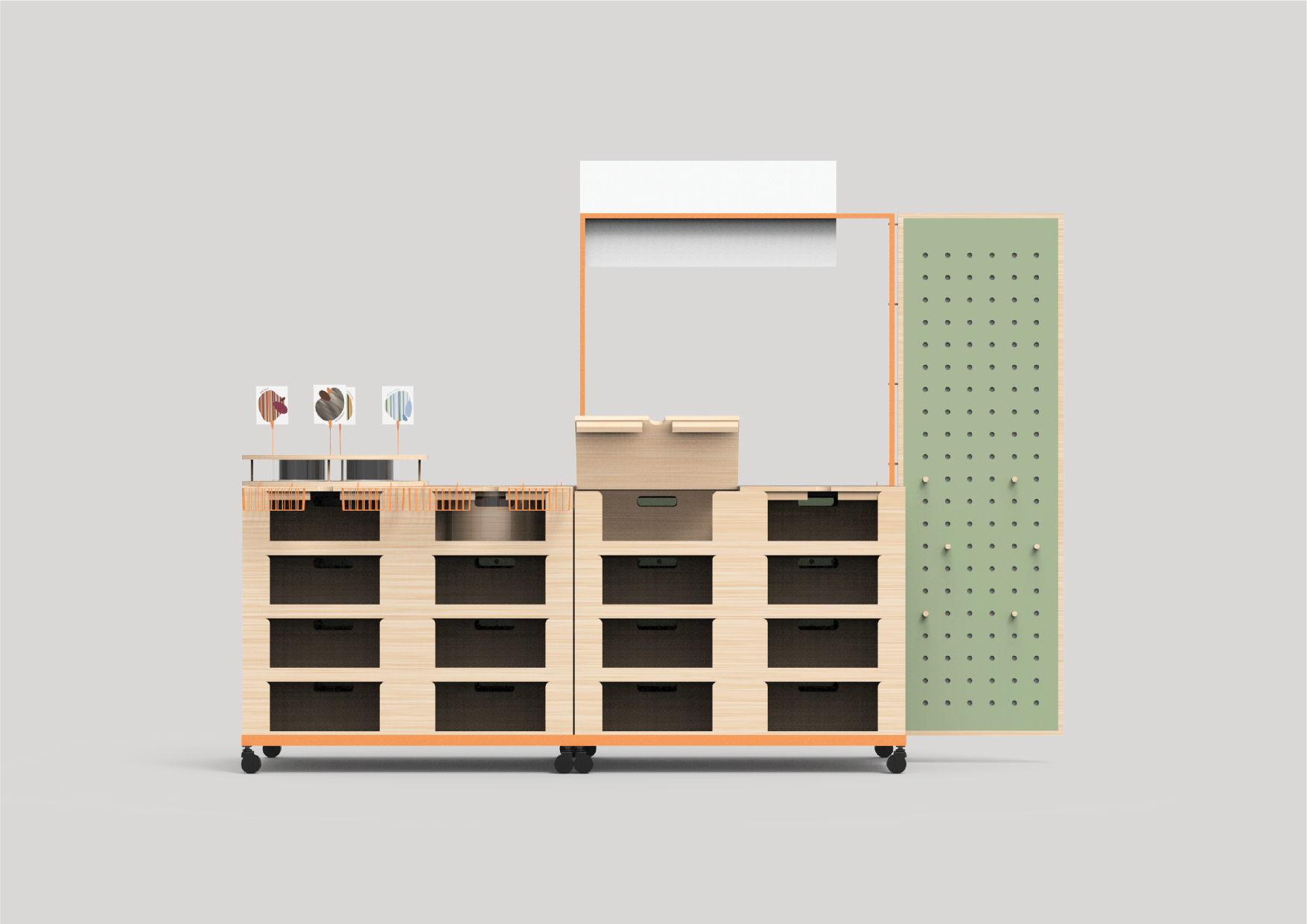
午夜干杯
MidnightToast
“每月某个周末的夜晚,我们希望与你相聚在‘餐桌’前,聊聊饮食文化、设计和艺术。”
微信公众号搜索「豆否」,与我们建立连接。
也欢迎在以下平台关注我们并收听节目:)
︎苹果播客
︎ Spotify
︎ 小宇宙
︎ RSS链接
MidnightToast
“每月某个周末的夜晚,我们希望与你相聚在‘餐桌’前,聊聊饮食文化、设计和艺术。”
微信公众号搜索「豆否」,与我们建立连接。
也欢迎在以下平台关注我们并收听节目:)
︎苹果播客
︎ Spotify
︎ 小宇宙
︎ RSS链接
Edible Invisible - 2018 荷兰设计周
09.11.2018 | 悦&溪婧于荷兰南城埃因霍芬举办的荷兰设计周(DDW2018),今年的主题设定为:如果不是我们,那么是谁?
本届设计周长达九天,由八大展区组成,围绕八大展区展开:
- 数字化 (DIGITAL)
- 艺术&收藏 (ART&COLLECTABLES)
- 新型材料 (NEW MATERIALS)
- 社群设计 (SOCIAL DESIGN)
- 生化设计 (BIO DESIGN)
- 制造者&工艺 (MAKERS & CRAFT)
- 未来居住 (FUTURE LIVING)
- 建筑&公共空间 (ARCHITECTURE&PUBLIC SPACE)
作为食物设计爱好者,我们专程参观了作为本届设计周大展之一,由荷兰食品&设计研究所(The Dutch Institute of Food&Design)主办的微生物主题食物设计展——“可食而不可见的”(EDIBLE INVISIBLE)。
作为每年都会呈现精彩食物设计的食品大使馆(Embassy of Food)的核心展览,展览的主题将聚焦于我们所食之物中不可见的成分——微生物,以及与之相关的食物与设计。微生物无处不在而且很大程度上影响着我们的生活,但却常常被人们忽视。我们的肠道菌群以及所吃的食物不仅影响着我们的身体健康,同时也影响着我们的情绪、行为甚至味觉。
展厅的入口由一条临时搭建的隧道组成,工作人员会给每一个参观者分发一只特殊的笔,写下的字迹只能用特殊的荧光灯灯照亮,参观者可将自己对关于微生物的发问写在墙上,而笔的背面则是荧光灯用来查看其他参观者写下的问题。
![]()
![]()
![]()
此处摘录一些主办方对参观者的发问:
🍀
餐桌上的地衣
为了预防人口增长所带来的粮食短缺问题,奥地利设计师 Julia Schwarz 带来了 Unseen Edible,一种基于地衣(英文为lichen,经常被与moss混谈)的食物。苔藓本身是一种非常有效的药材,它们甚至被证实可以在火星上生长。Unseen Edible向观者们提供了一个把苔藓作为日常食材广泛食用的社群,以提供一种新的饮食可能。
![]()
原始的地衣状态
![]()
设计师提供了两种经过粗加工的地衣让大家品尝,未加盐的地衣略有涩味,而加了盐的地衣作为餐前小菜非常美味
![]()
这是一碗以地衣作为食材之一并添加了青酱以及杏仁酱的创新菜式,味道非常鲜美!
🚽
尿液变化肥
我们平均每天都通过马桶冲走1.4升的尿液,而这要消耗33升的水资源。如果我们能够将身体的这一部分废弃物循环再使用呢?荷兰设计师Eva van Strien、Anne van Strien以及Thieu Custers带来了Anthroponix,通过对尿液的成分研究,他们发现尿液中含有三种传统肥料中所包含的成分:氮、磷、钾。而Anthroponix是一个将尿液提取加工为肥料供植物生长的家用肥料制作系统,通过加入乳酸菌使尿液发酵可排除潜在的病原菌并削减异味。一个人一年的尿液可供养250公斤的小麦生长,相当于3000餐饭!
![]()
![]()
![]()
💅🏻
反香水
传统食物发酵过程所丢弃的发酵水通常被认为是无用的,南非设计工作室Studio H的设计师Hannerie Visser以装置的形式将不同的发酵食物的汁液进行搭配向观者提供了包装精致的九种“香水”,鼓励大家进行“鉴赏”,装置的旁边附有一台食物脚本打印机,脚本的内容是设计师从Youtube上的真实反馈中收集而来,以此来引起大家的深思——不同的文化也时常会被它所引以为傲的珍贵的经典菜肴所嘲讽,而这些“香水”正是希望能提醒人们:我们所食之物没有不同。
![]()
装置左侧为食物脚本打印机,右侧为“香水”瓶
![]()
部分脚本内容
![]()
“香水”配方1——源自网络
![]()
“香水”配方2——源自网络
💦️
源自身体的营养液
通过由德国设计师Ina Turinsky和Andreas Wagner带来的 Nutrient Solution 向人们提供了一种家用供养微藻的方式。三个盘子代表了三种不同的生长环境以生长出三种不同的菜式。唾液与呼吸,通过日常的行为“饲养”你的微藻,10-14天的精心照料你将会得到一盘精美的微藻美味。
![]()
![]()
☕️
红茶菌包装
由波兰设计师Roza Janusz带来的 Scoby Packaging 是由细菌发酵所“编织”而成的红茶菌包装纸,这层菌膜使包装内的产品延长了保质期同时也可以同产品一起食用或者作为混合肥料使用,也许未来的包装将不再破坏土壤而是让土壤更加富饶。
![]()
![]()
循环可视图——源自网络
🍫
巧克力药丸
Mela 是一个投机性服务公司,它的设计师Maria Apud Bell向使用者提供了一种由细菌混合物制作的针对健康问题而设计的的巧克力,通过一个一次性的电子药丸检测人体中的微生物群进而得到人体的细菌需求。通过这个巧克力药丸,使用者可以通过对自己健康状况的了解进而减缓压力、提高睡眠质量、控制糖类和脂类代谢,提高情绪状态并减少消化问题。
![]()
2011年IBM发布了超级计算机Watson,一台创新的、有认知能力的计算机系统,它可以对大量数据进行处理与分析并从经验中学习。在这个技术背景下,来自荷兰的设计师 Katinka Verzendaal 产生了人工智能学习对美食节影响的思考,并带来了模拟项目Chef versus Watson。在这个人机合作的美食项目中,Watson将创建一个食材清单以及每个食材相对应的食材组合。食者选择一个食材,Watson将通过对被选择食材的分析筛选出最佳的食物搭配方案以得到最佳美味。而厨师的角色则是通过他们的厨艺对食材进行加工以呈现出一道佳肴。
![]()
🧫
微生物交响曲
一块酸酵头(sourdough starter)是野生酵母与细菌的培养物,通常用来制作面包。这些微生物被赋予重任让酵母面包有着微微的酸味且充满嚼劲。当储存一块酸酵头的时候,要确保它保持活力并且健康,使它呼吸、分泌、复制并回应。塞浦路斯设计师Olivia Ioannou通过 Microbial Symphony 给酸酵头提供了一次发声的机会,她设计了一个新的发酵环境,使酸酵头在生长过程中的状态以声音数据的方式被记录,成为一种发酵的副产品,这些声音数据被设计师进一步处理成为了一首微生物交响曲,也希望通过这样的记录帮助人们更深入地了解这些微生物的生命状态。
![]()
If not us, then who?
本届设计周长达九天,由八大展区组成,围绕八大展区展开:
- 数字化 (DIGITAL)
- 艺术&收藏 (ART&COLLECTABLES)
- 新型材料 (NEW MATERIALS)
- 社群设计 (SOCIAL DESIGN)
- 生化设计 (BIO DESIGN)
- 制造者&工艺 (MAKERS & CRAFT)
- 未来居住 (FUTURE LIVING)
- 建筑&公共空间 (ARCHITECTURE&PUBLIC SPACE)
作为食物设计爱好者,我们专程参观了作为本届设计周大展之一,由荷兰食品&设计研究所(The Dutch Institute of Food&Design)主办的微生物主题食物设计展——“可食而不可见的”(EDIBLE INVISIBLE)。
︎关于展览
![]()
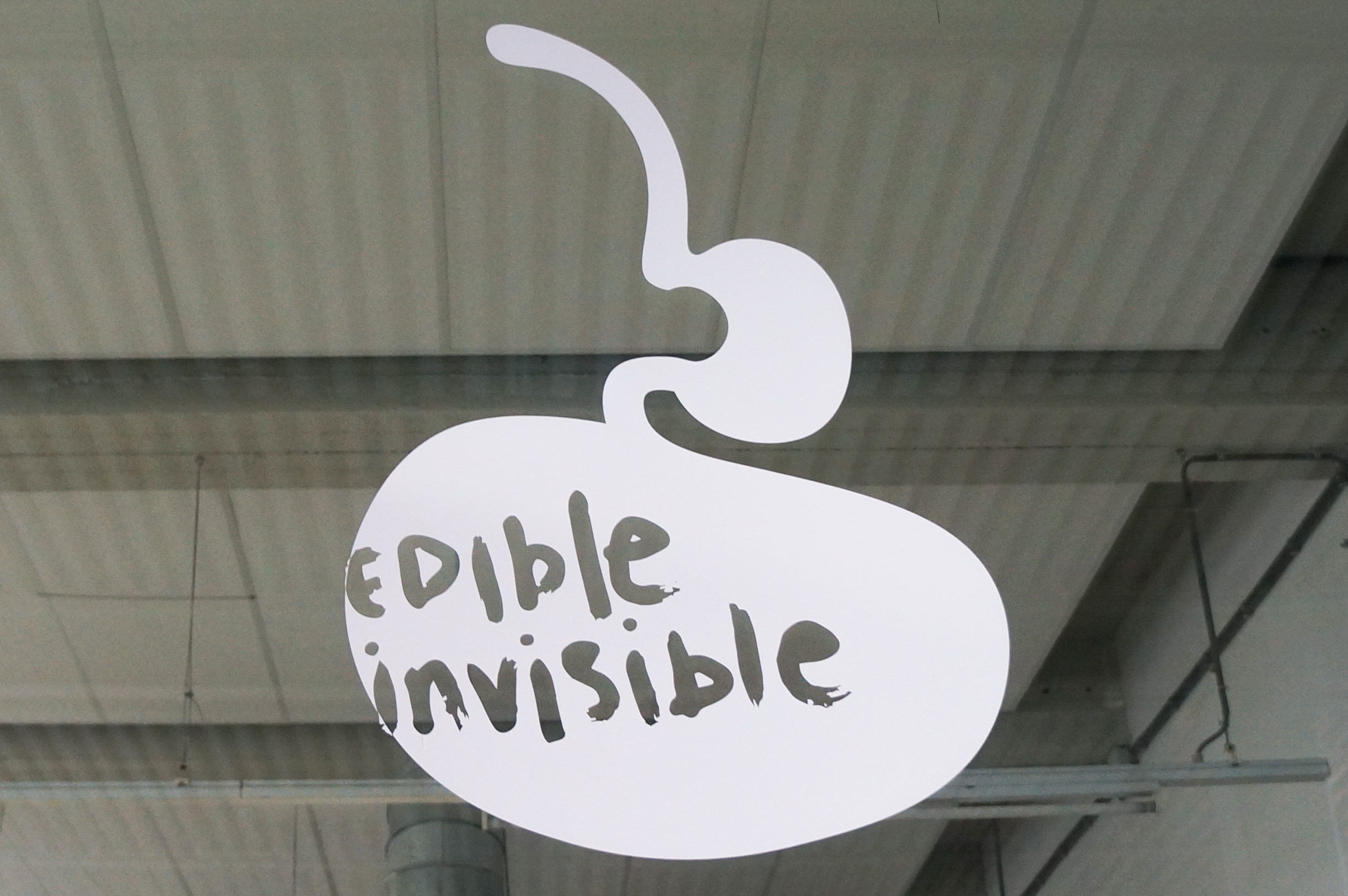
作为每年都会呈现精彩食物设计的食品大使馆(Embassy of Food)的核心展览,展览的主题将聚焦于我们所食之物中不可见的成分——微生物,以及与之相关的食物与设计。微生物无处不在而且很大程度上影响着我们的生活,但却常常被人们忽视。我们的肠道菌群以及所吃的食物不仅影响着我们的身体健康,同时也影响着我们的情绪、行为甚至味觉。
展厅的入口由一条临时搭建的隧道组成,工作人员会给每一个参观者分发一只特殊的笔,写下的字迹只能用特殊的荧光灯灯照亮,参观者可将自己对关于微生物的发问写在墙上,而笔的背面则是荧光灯用来查看其他参观者写下的问题。
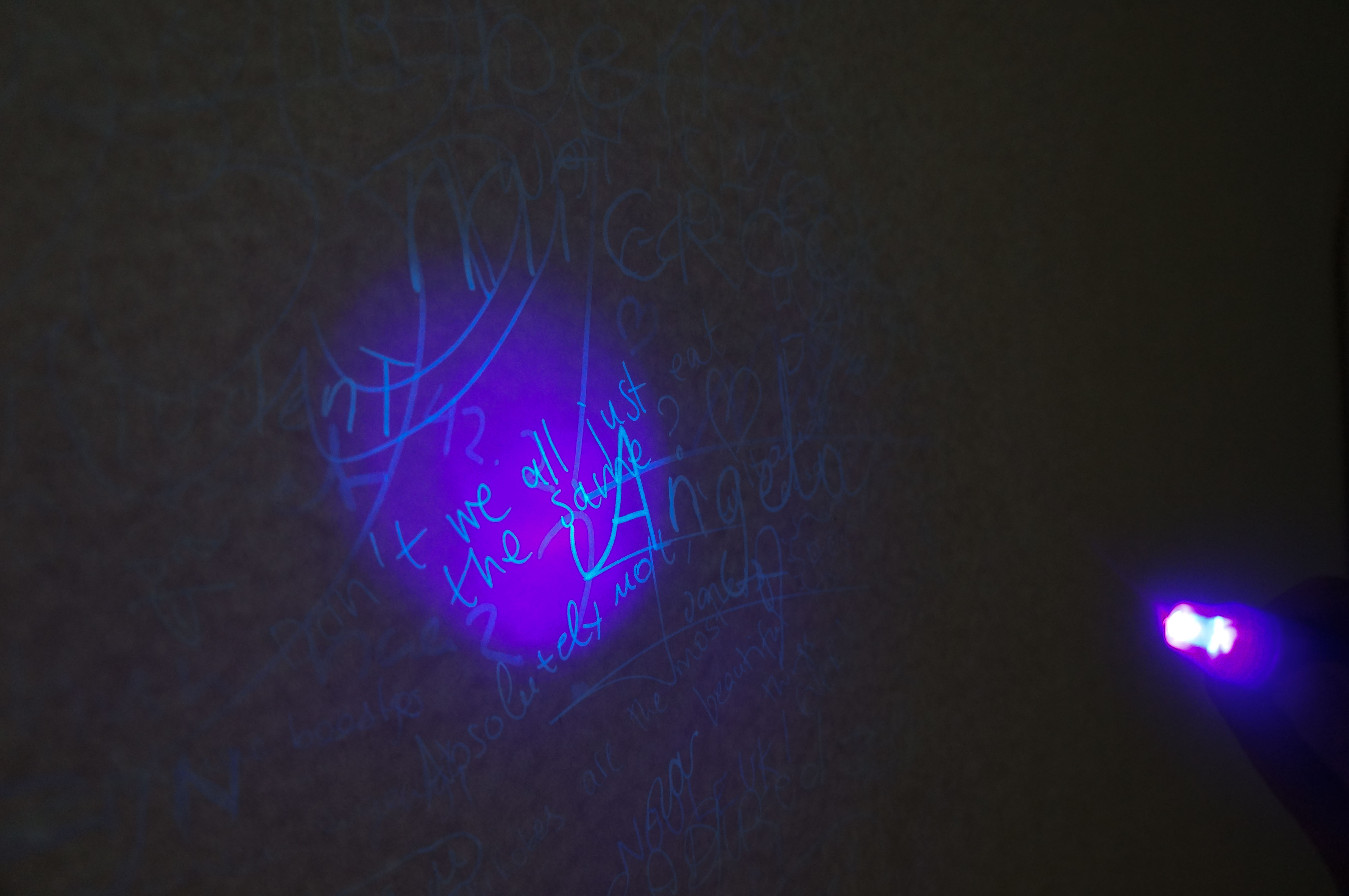
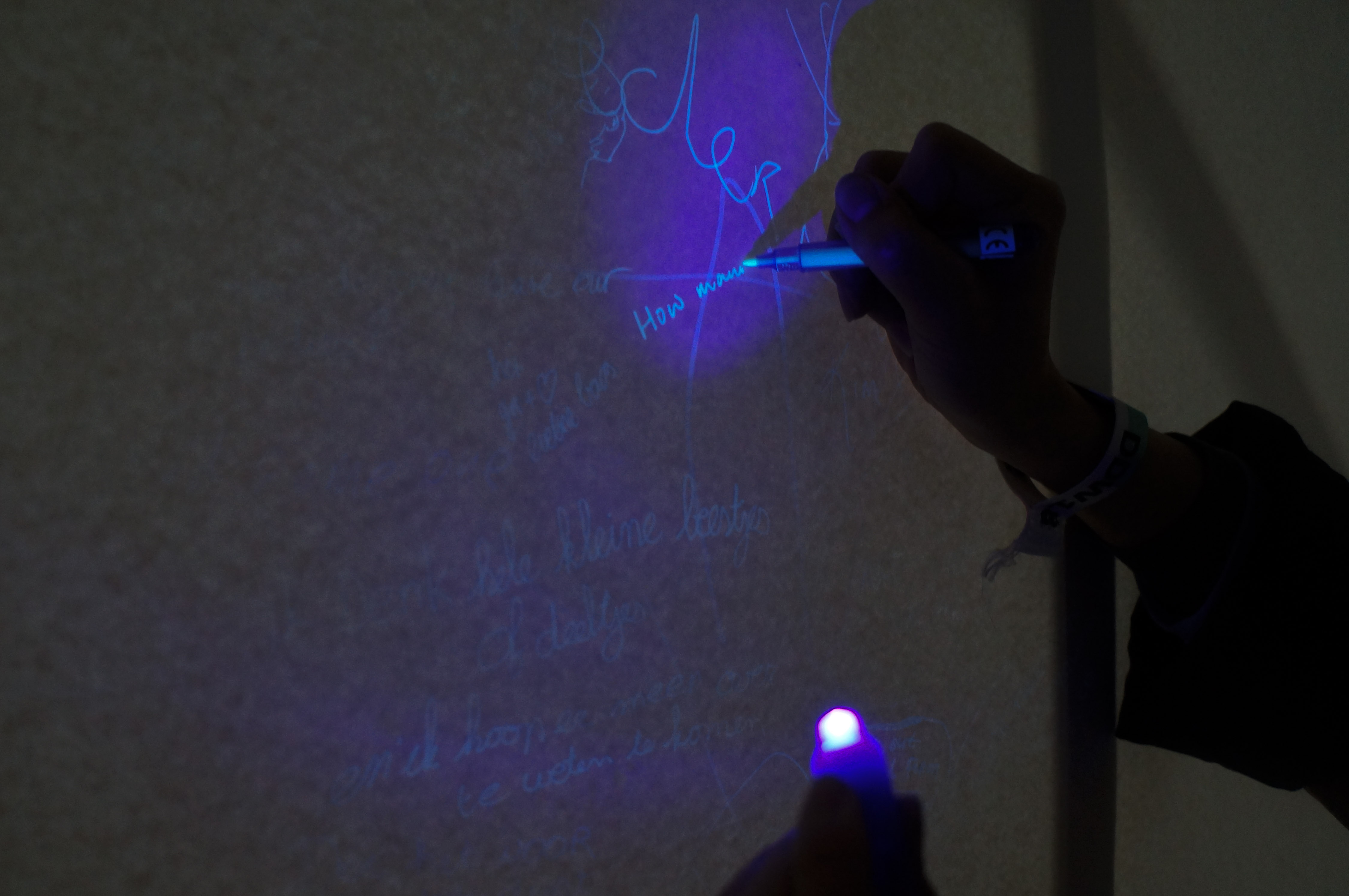

此处摘录一些主办方对参观者的发问:
- 微生物会对我们的身体做些什么?
- 我们在喂养我们的身体还是身体中的微生物?
- 我们需要更多的营养师,更少的精神病医生?
- 奶农们需要喂养他们的奶牛还是喂养土壤?
- 设计师能对微生物做些什么?
- 我们如何设计那些不可见的事物?
- 我身体中的微生物在控制我的思想吗?
- 我们如何正确使用微生物而不生病?
- 作为一个微生物是什么感觉?
🍀
餐桌上的地衣
为了预防人口增长所带来的粮食短缺问题,奥地利设计师 Julia Schwarz 带来了 Unseen Edible,一种基于地衣(英文为lichen,经常被与moss混谈)的食物。苔藓本身是一种非常有效的药材,它们甚至被证实可以在火星上生长。Unseen Edible向观者们提供了一个把苔藓作为日常食材广泛食用的社群,以提供一种新的饮食可能。
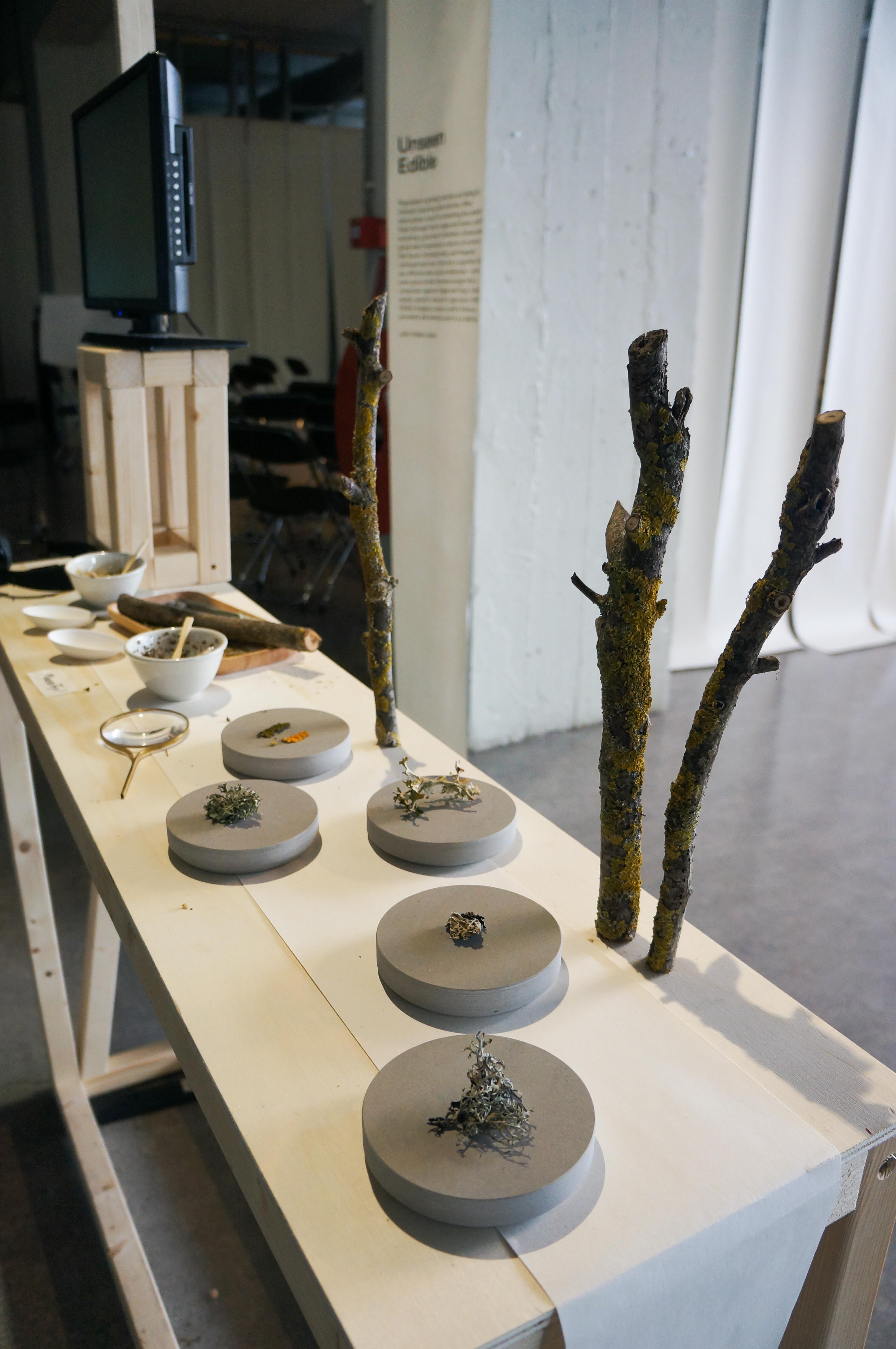
原始的地衣状态
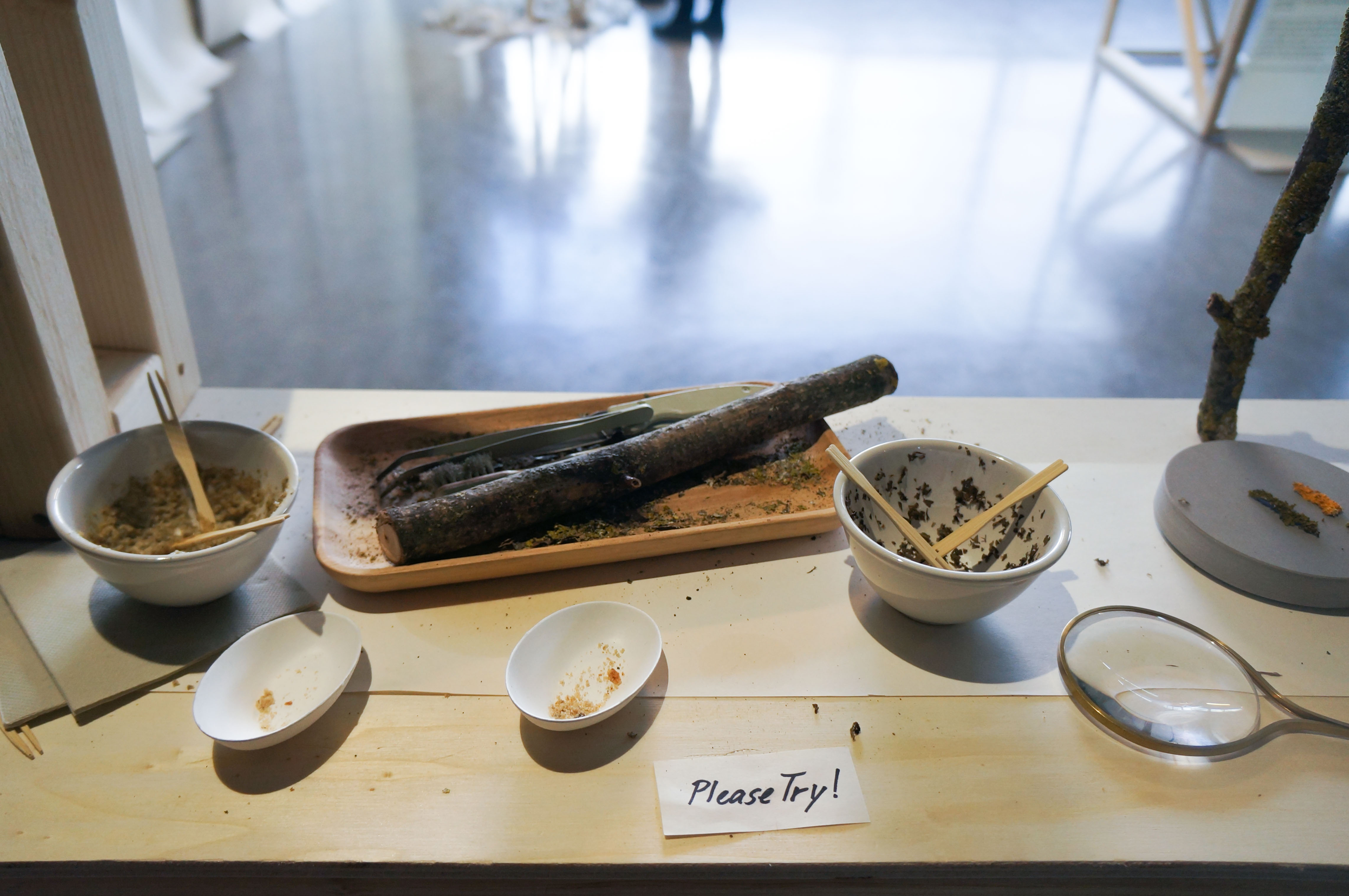
设计师提供了两种经过粗加工的地衣让大家品尝,未加盐的地衣略有涩味,而加了盐的地衣作为餐前小菜非常美味
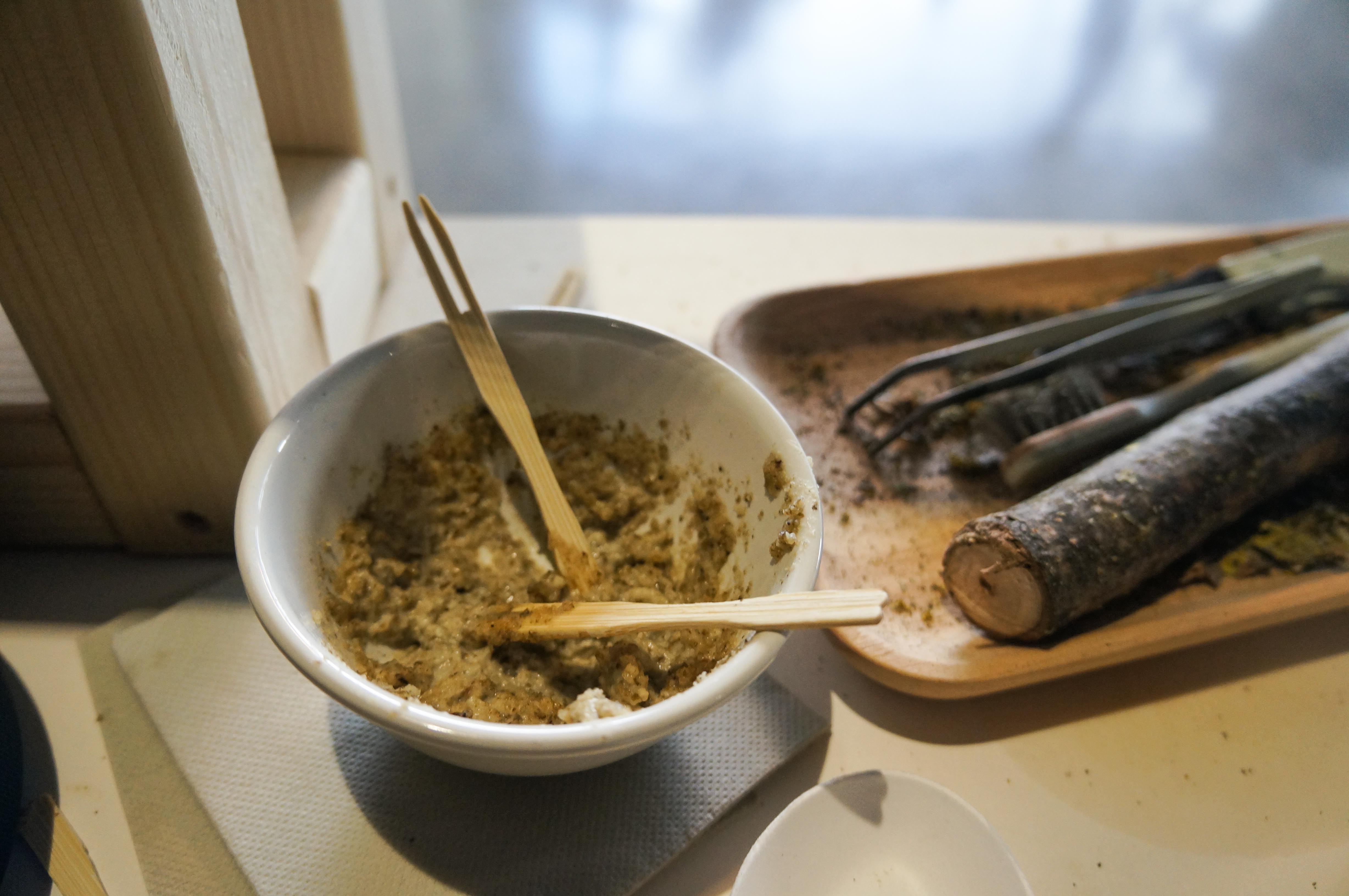
这是一碗以地衣作为食材之一并添加了青酱以及杏仁酱的创新菜式,味道非常鲜美!
🚽
尿液变化肥



💅🏻
反香水
传统食物发酵过程所丢弃的发酵水通常被认为是无用的,南非设计工作室Studio H的设计师Hannerie Visser以装置的形式将不同的发酵食物的汁液进行搭配向观者提供了包装精致的九种“香水”,鼓励大家进行“鉴赏”,装置的旁边附有一台食物脚本打印机,脚本的内容是设计师从Youtube上的真实反馈中收集而来,以此来引起大家的深思——不同的文化也时常会被它所引以为傲的珍贵的经典菜肴所嘲讽,而这些“香水”正是希望能提醒人们:我们所食之物没有不同。

装置左侧为食物脚本打印机,右侧为“香水”瓶
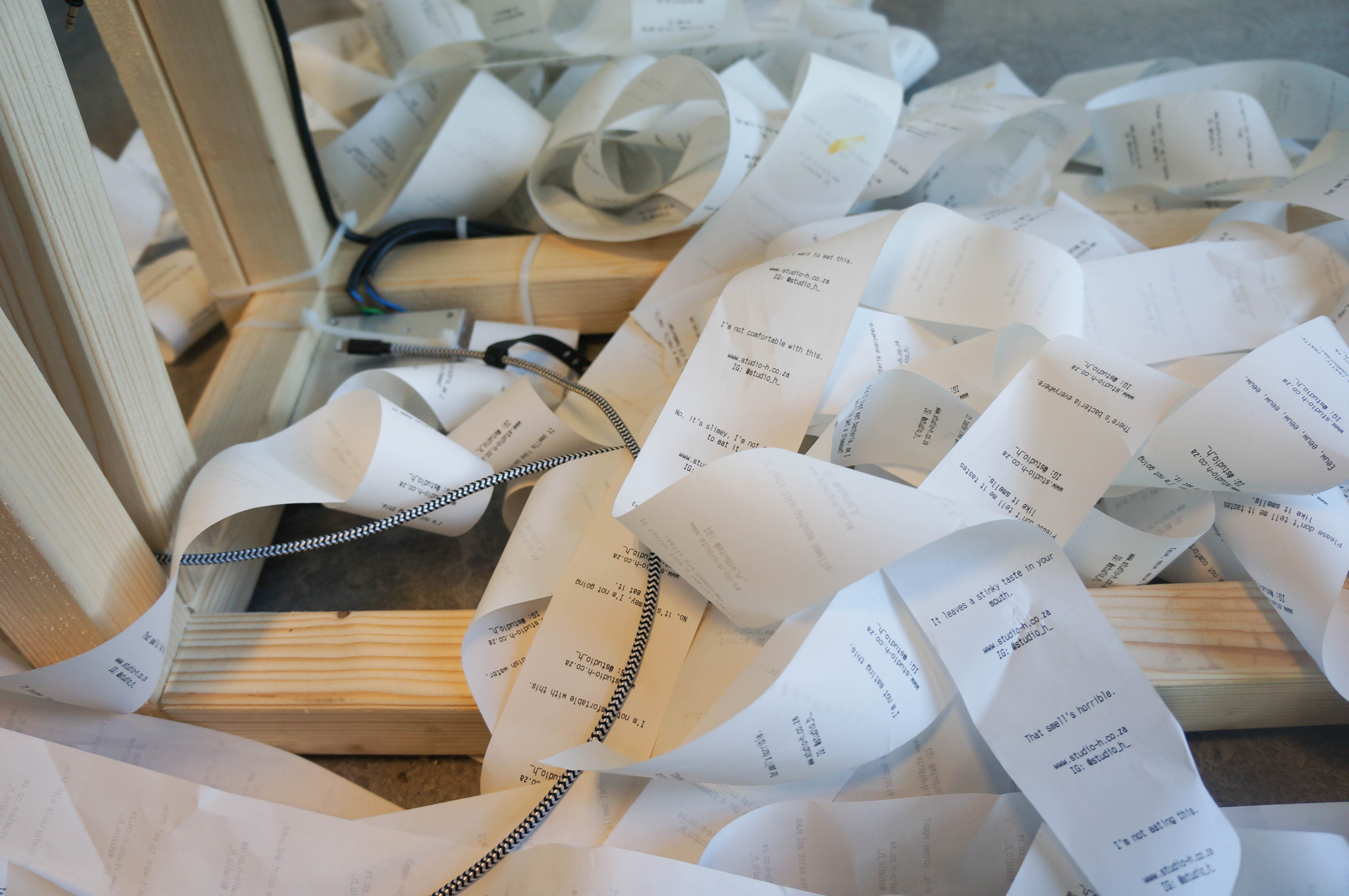
部分脚本内容

“香水”配方1——源自网络

“香水”配方2——源自网络
💦️
源自身体的营养液
通过由德国设计师Ina Turinsky和Andreas Wagner带来的 Nutrient Solution 向人们提供了一种家用供养微藻的方式。三个盘子代表了三种不同的生长环境以生长出三种不同的菜式。唾液与呼吸,通过日常的行为“饲养”你的微藻,10-14天的精心照料你将会得到一盘精美的微藻美味。


☕️
红茶菌包装
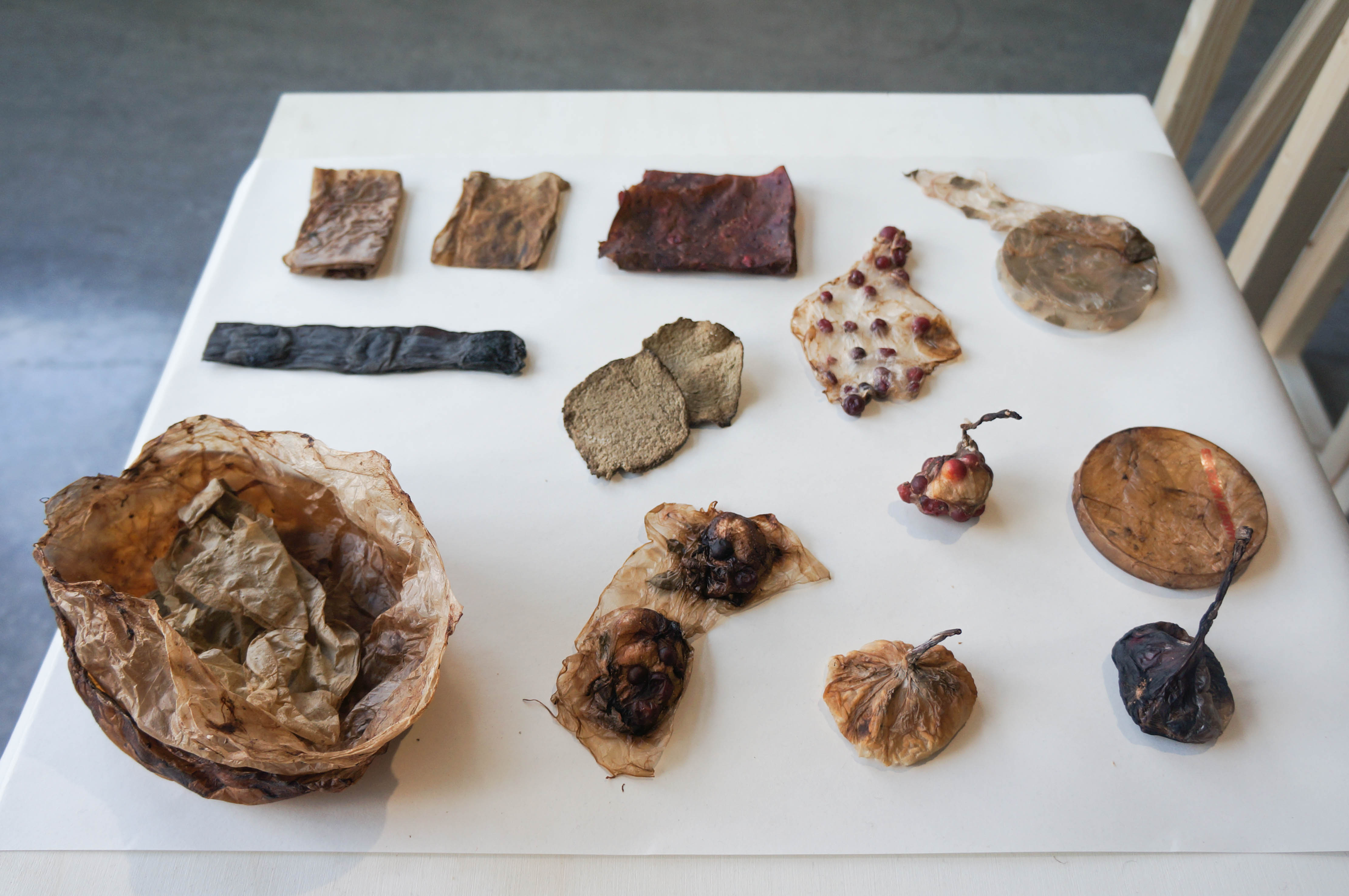

循环可视图——源自网络
🍫
巧克力药丸
Mela 是一个投机性服务公司,它的设计师Maria Apud Bell向使用者提供了一种由细菌混合物制作的针对健康问题而设计的的巧克力,通过一个一次性的电子药丸检测人体中的微生物群进而得到人体的细菌需求。通过这个巧克力药丸,使用者可以通过对自己健康状况的了解进而减缓压力、提高睡眠质量、控制糖类和脂类代谢,提高情绪状态并减少消化问题。

👩🏻🍳
你的人工智能厨师
你的人工智能厨师
2011年IBM发布了超级计算机Watson,一台创新的、有认知能力的计算机系统,它可以对大量数据进行处理与分析并从经验中学习。在这个技术背景下,来自荷兰的设计师 Katinka Verzendaal 产生了人工智能学习对美食节影响的思考,并带来了模拟项目Chef versus Watson。在这个人机合作的美食项目中,Watson将创建一个食材清单以及每个食材相对应的食材组合。食者选择一个食材,Watson将通过对被选择食材的分析筛选出最佳的食物搭配方案以得到最佳美味。而厨师的角色则是通过他们的厨艺对食材进行加工以呈现出一道佳肴。

🧫
微生物交响曲

Wanderer - Fermentation in Daily Objects
11.2018 | Xijing XU🔍 Have a Look on the project
The word ‘fermentation’ can literally evoke a tasteful fantasy about food with rich aroma. However, I would rather like to describe fermentation as a gift from nature instead of an art of culinary art. As human beings we can only base on our experiences and knowledge, adjust to the environment, temperature or other external factors, so that we could obtain the essence at some point. The real functional „role“ in this process is still played by invisible micro creatures.
The curiosity about food fermentation led me to focus on the fermenting process of milk products, above all, of sour milk. The appearance and smell of sour milk is similar to yoghurt. However, yoghurt is an industrial product, usually fermented through a vacuum-freeze-drying isolated single culture ( in most cases are streptococcus thermopiles and lactobacillus delbrueckii subsp. bulgaricus). Unicity of the culture ensure hygiene and safety of yoghurt, it conduces to the unity of the food taste in mass production. However, in this way, the yoghurt also loses the ability of concerning long-term conservation and unlimited usage as a starter culture of yoghurt producing.
In contrast, sour milk is an natural fermented milk product: one can put a little batch of ready-made sour milk (which is called starter culture in this case) into fresh milk and leaves it somewhere with room temperature, where the microbe can reproduce themselves in an appropriate environment (room temperature) and gain enough nutrition (fattiness from the milk) – Metaphorically, it could be described as a process of gradual and cultural assimilation. There are different kinds of microbe exist in different regions, of which built a diverse taste-spectrum of sour milk, many fermenters enjoy collecting and sharing the old starter cultures of them. But what are those microbes consist in sour milk in general? No one is able to answer this question. Even if starter cultures came from same origin, after being treated differently or placed under distinct conditions, the species inside will change and grow dissimilarly. during the time and the process of changes in different environment, sour milk derived some strong but inclusive small ecosystems, tirelessly save and update the taste of sour milk.
![]()
![]()
![]()
left to right
> streptococcus thermophilus
> lactobacillus delbrueckii subsp. bulgaricus
> Milk pasteurising equipment in 1953, for ensuring no other bacteria will be enrolled during the production of milk products
![]()
The home-used bacteria-pulver available in markets are mostly produced from labs, for making yoghurt consist of single species of culture
![]()
Vilii is a sort of sour milk from Finnland, which could be easily identified by their viscous and extensile appearance
![]()
Step by step, I also started to develop my little collection of cultures. I take care of these mini microbial „pet“ with friends in our atelier together. From this process, I gathered a strong feeling, that the happiness of enjoying fermented food doesn’t only come from the taste itself, but more from the interaction and communication with ferment-lovers
In comparison, the exchanging and delivering of starter on a small scale is still imaginable, a long-term and transregional preservation seems relatively tricky. In fact, considering the fermenting process of sour milk is actually the growing and activating process of lactobacillus (mesophilic or thermophilic bacteria), which means, the starter could be inactivated while changing the factor of either temperature or humidity. A good example would be, putting yoghurt into a refrigerator is for lowering down the heat to reduce the activity of yoghurt , therefore, to keep it alive for longer period. Nevertheless, for expanding the „network“ of culture exchanging, ferment-lovers need to take one more step to change another factor: dehydrating the sour milk, on purpose to allow the sour milk became more suitable for delivering.
During my search for different types of sour milk, I was fascinated by the derived forms of „storage“ and „container“ for them: Some people put cottons into sour milk and dehydrate them, someone sent me crumbs of dried sour milk, one of my friend used a tissue as media and „smuggled” some viili to Berlin… As if these mini creatures have found themselves peaceful corners in the gap of human industrial civilization for their own growth.. The most astonishing story is from the Finnish immigrants of last century, for bringing the starter culture of viili to the USA, they applied sour milk on a dried clean handkerchief, after making it dried, they would roll and put it into a bag, and transoceanically regenerate them.
![]()
„Storage“ of starter cultures in different forms
![]()
The „activating“ process of a „storage“
![]()
In his work The Art of Fermentation, Sandor Ellix Katz told the transportation story of viili of Finnish immigrants
![]()
After hearing the Finnish story, a friend of mine had a journey to Finland and wanted to bring me some viili, whom has been stopped in the airport because of the luggage limitation for liquid. Facing this embarrassing moment, he came up with an idea which was applying some viili onto a piece of tissue and brought the tissue back to Berlin, few days after putting the tissue in milk, the milk fermented into new viili…
![]()
![]()
Being influenced by these stories, I also tried to apply the regular yoghurt onto textile and dry them up, and used them as a starter culture
The story of Finnish immigrants led my attention towards Textile as a kind of media. Mentioning the word ‘textile’, we can always recognize the original culture of a piece of textile, by identifying their unique visual style, which results in their vernacular weaving, printing and dyeing technique. In this regard, the textile is an expression medium of a culture on a civilized level.
In Germanic languages „culture“ possesses two meanings: one is the civilized rise, one is the bacterial cultivation. In the story of Finnish immigrants, a piece of textile became a literary carrier of culture. The pun leads to a playful literary meaning. I started to think about how to use textile to convey the multi-paraphrasing of „culture“.
If I consider the process of applying sour milk on textile and dehydrating them as a transformation of textile to a „medium” or „storage“, can we beautify or regularize the presenting way of sour milk (as a content) on textile (as a container)? If the textile is a carrier for sour milk babies, are they reusable after finishing their mission? I turned my attention to the white, thick sour milk – Can this semi-liquid substance also be used as a pigment for drawing a portrait of the microorganisms in sour milk?
![]()
I tried to print some texts on the textile through screen printing
![]()
The patterns were inspired by the form of lactobacillus
![]()
Before and after drying
I chose three kinds of sour milk from different cultures: matsoni from Georgia, viili from Finland, filmjölk from Sweden. The fabric/pattern from each culture has its own striking personality: Geometric pattern of Georgian carpet, Finnish lattice fabric, Swedish Kubrits pattern…I extracted the most representative visual elements in each culture and designed three different flat patterns for each sour milk. The textile as a container has been divided into equal parts with the unit of 10cm *10cm. The negative patterns and the name of related sour milk were screen printed on textile with food colouring, and then the corresponding sour milk was applied on each square to cover the positive pattern. After drying, every little unit square can be cut off and used for fermenting a small bottle of sour milk starter.
![]()
![]()
The evolution of patterns design for sour milk from three cultures
︎
![]()
![]()
![]()
![]() The processing method of my fabric allows people to cut them off as small squares easily, The lightness of material allows it to be inserted into any corner around. In this sense, the culture not only has the possibility of infinite extension along the longitudinal axis of time but also gets to wander around in different spatial extents whenever people walks by. I cut down pieces of my culture and shared with friends via post or visiting. Thus the micro bacteria rely on a light cloth completed their journey as a wanderer. As the natural fermentation is still full of uncertainties, from the feedbacks of friends,I learned that not every container gets a perfect result. But as a friend said: „it was fun“, I think the „ fun“ is the most substantial reason and most joyful thing, to cultivate and exchange culture, to enjoy fermented food in our daily life.
The processing method of my fabric allows people to cut them off as small squares easily, The lightness of material allows it to be inserted into any corner around. In this sense, the culture not only has the possibility of infinite extension along the longitudinal axis of time but also gets to wander around in different spatial extents whenever people walks by. I cut down pieces of my culture and shared with friends via post or visiting. Thus the micro bacteria rely on a light cloth completed their journey as a wanderer. As the natural fermentation is still full of uncertainties, from the feedbacks of friends,I learned that not every container gets a perfect result. But as a friend said: „it was fun“, I think the „ fun“ is the most substantial reason and most joyful thing, to cultivate and exchange culture, to enjoy fermented food in our daily life.
![]()
Wanderer | Masterarbeit 2018
Betreuer/in:
Axel Kufus
Johanna Schmeer
Special Thanks to
Edible Alchemy
Julia Kunz
Sandor Ellix Katz
Zining LIU
Fang HU
Dong LIU
Kailin LU
Videos feedback provided by
Filippo Maria MIRASOLE
Samuel VON DÜFFEL
Adrian BACHMANN
Yue LIU
Esmée WILLEMSEN
Juan GAEZE
The word ‘fermentation’ can literally evoke a tasteful fantasy about food with rich aroma. However, I would rather like to describe fermentation as a gift from nature instead of an art of culinary art. As human beings we can only base on our experiences and knowledge, adjust to the environment, temperature or other external factors, so that we could obtain the essence at some point. The real functional „role“ in this process is still played by invisible micro creatures.
The curiosity about food fermentation led me to focus on the fermenting process of milk products, above all, of sour milk. The appearance and smell of sour milk is similar to yoghurt. However, yoghurt is an industrial product, usually fermented through a vacuum-freeze-drying isolated single culture ( in most cases are streptococcus thermopiles and lactobacillus delbrueckii subsp. bulgaricus). Unicity of the culture ensure hygiene and safety of yoghurt, it conduces to the unity of the food taste in mass production. However, in this way, the yoghurt also loses the ability of concerning long-term conservation and unlimited usage as a starter culture of yoghurt producing.
In contrast, sour milk is an natural fermented milk product: one can put a little batch of ready-made sour milk (which is called starter culture in this case) into fresh milk and leaves it somewhere with room temperature, where the microbe can reproduce themselves in an appropriate environment (room temperature) and gain enough nutrition (fattiness from the milk) – Metaphorically, it could be described as a process of gradual and cultural assimilation. There are different kinds of microbe exist in different regions, of which built a diverse taste-spectrum of sour milk, many fermenters enjoy collecting and sharing the old starter cultures of them. But what are those microbes consist in sour milk in general? No one is able to answer this question. Even if starter cultures came from same origin, after being treated differently or placed under distinct conditions, the species inside will change and grow dissimilarly. during the time and the process of changes in different environment, sour milk derived some strong but inclusive small ecosystems, tirelessly save and update the taste of sour milk.
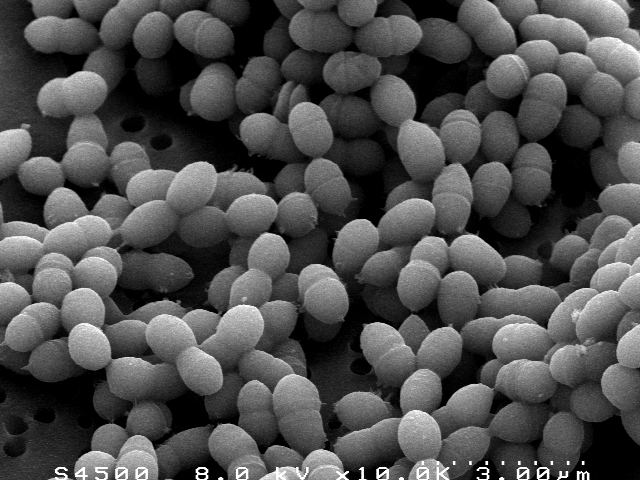
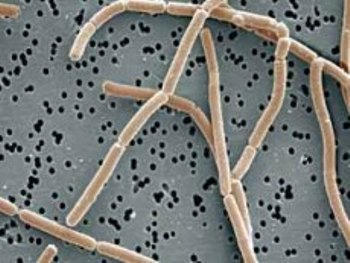

left to right
> streptococcus thermophilus
> lactobacillus delbrueckii subsp. bulgaricus
> Milk pasteurising equipment in 1953, for ensuring no other bacteria will be enrolled during the production of milk products

The home-used bacteria-pulver available in markets are mostly produced from labs, for making yoghurt consist of single species of culture
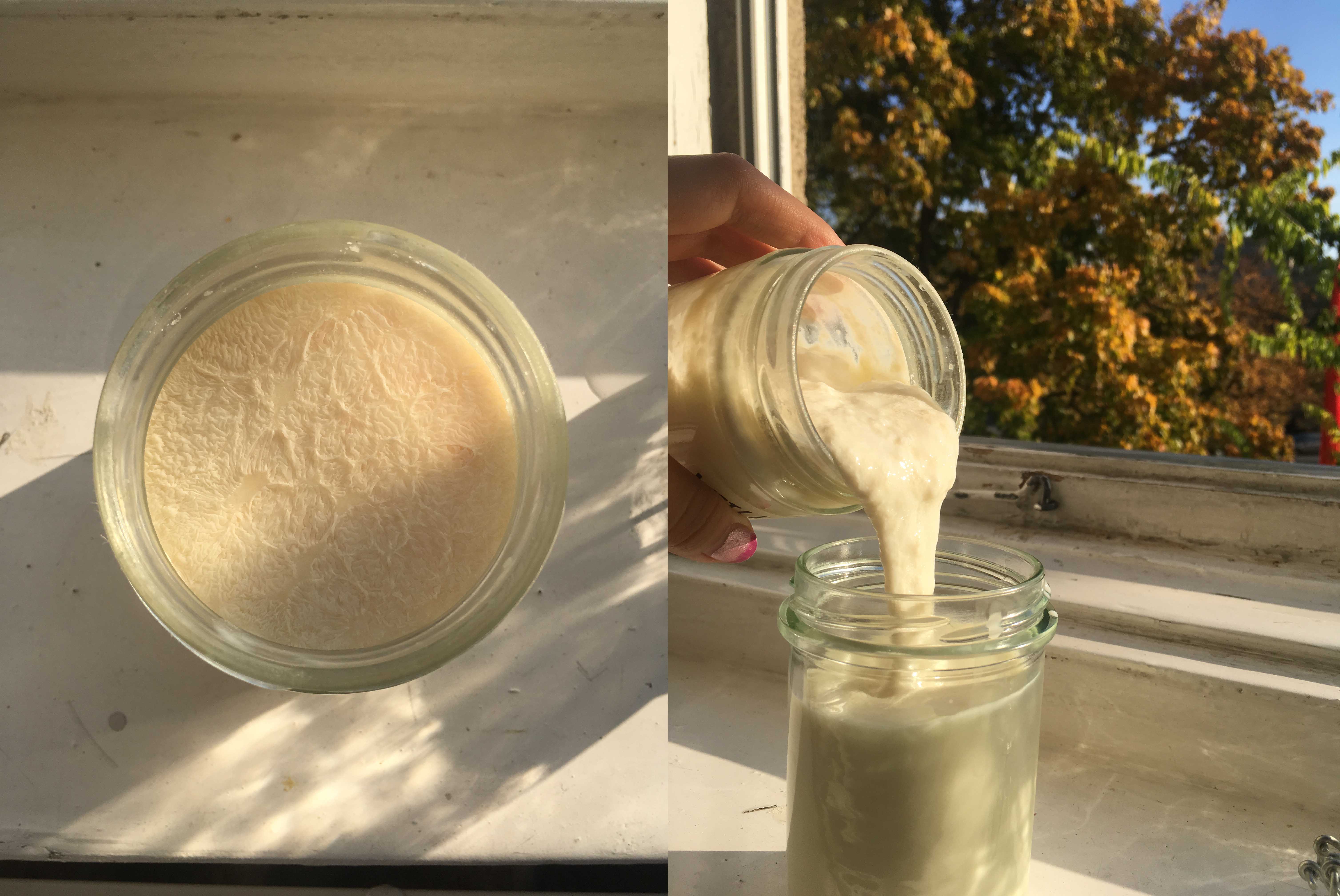
Vilii is a sort of sour milk from Finnland, which could be easily identified by their viscous and extensile appearance

Step by step, I also started to develop my little collection of cultures. I take care of these mini microbial „pet“ with friends in our atelier together. From this process, I gathered a strong feeling, that the happiness of enjoying fermented food doesn’t only come from the taste itself, but more from the interaction and communication with ferment-lovers
In comparison, the exchanging and delivering of starter on a small scale is still imaginable, a long-term and transregional preservation seems relatively tricky. In fact, considering the fermenting process of sour milk is actually the growing and activating process of lactobacillus (mesophilic or thermophilic bacteria), which means, the starter could be inactivated while changing the factor of either temperature or humidity. A good example would be, putting yoghurt into a refrigerator is for lowering down the heat to reduce the activity of yoghurt , therefore, to keep it alive for longer period. Nevertheless, for expanding the „network“ of culture exchanging, ferment-lovers need to take one more step to change another factor: dehydrating the sour milk, on purpose to allow the sour milk became more suitable for delivering.
During my search for different types of sour milk, I was fascinated by the derived forms of „storage“ and „container“ for them: Some people put cottons into sour milk and dehydrate them, someone sent me crumbs of dried sour milk, one of my friend used a tissue as media and „smuggled” some viili to Berlin… As if these mini creatures have found themselves peaceful corners in the gap of human industrial civilization for their own growth.. The most astonishing story is from the Finnish immigrants of last century, for bringing the starter culture of viili to the USA, they applied sour milk on a dried clean handkerchief, after making it dried, they would roll and put it into a bag, and transoceanically regenerate them.
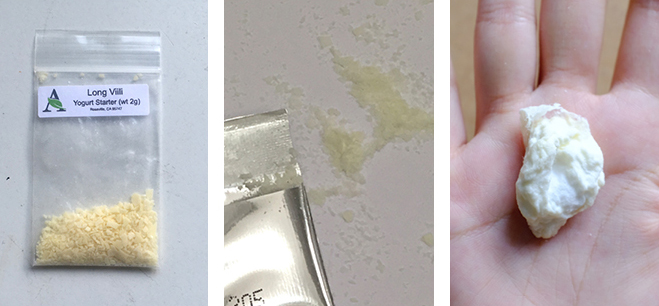
„Storage“ of starter cultures in different forms

The „activating“ process of a „storage“
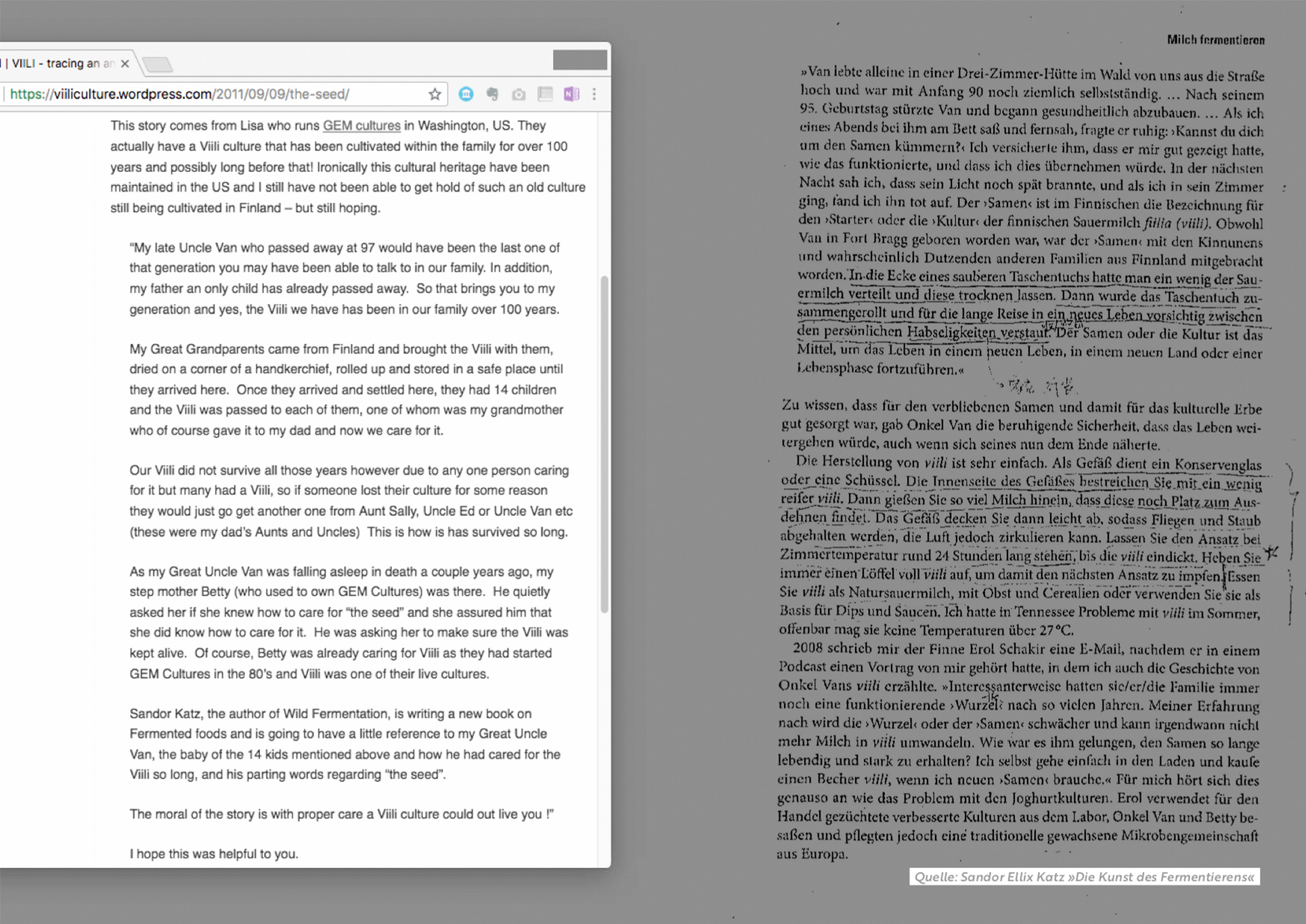
In his work The Art of Fermentation, Sandor Ellix Katz told the transportation story of viili of Finnish immigrants

After hearing the Finnish story, a friend of mine had a journey to Finland and wanted to bring me some viili, whom has been stopped in the airport because of the luggage limitation for liquid. Facing this embarrassing moment, he came up with an idea which was applying some viili onto a piece of tissue and brought the tissue back to Berlin, few days after putting the tissue in milk, the milk fermented into new viili…


Being influenced by these stories, I also tried to apply the regular yoghurt onto textile and dry them up, and used them as a starter culture
The story of Finnish immigrants led my attention towards Textile as a kind of media. Mentioning the word ‘textile’, we can always recognize the original culture of a piece of textile, by identifying their unique visual style, which results in their vernacular weaving, printing and dyeing technique. In this regard, the textile is an expression medium of a culture on a civilized level.
In Germanic languages „culture“ possesses two meanings: one is the civilized rise, one is the bacterial cultivation. In the story of Finnish immigrants, a piece of textile became a literary carrier of culture. The pun leads to a playful literary meaning. I started to think about how to use textile to convey the multi-paraphrasing of „culture“.
If I consider the process of applying sour milk on textile and dehydrating them as a transformation of textile to a „medium” or „storage“, can we beautify or regularize the presenting way of sour milk (as a content) on textile (as a container)? If the textile is a carrier for sour milk babies, are they reusable after finishing their mission? I turned my attention to the white, thick sour milk – Can this semi-liquid substance also be used as a pigment for drawing a portrait of the microorganisms in sour milk?
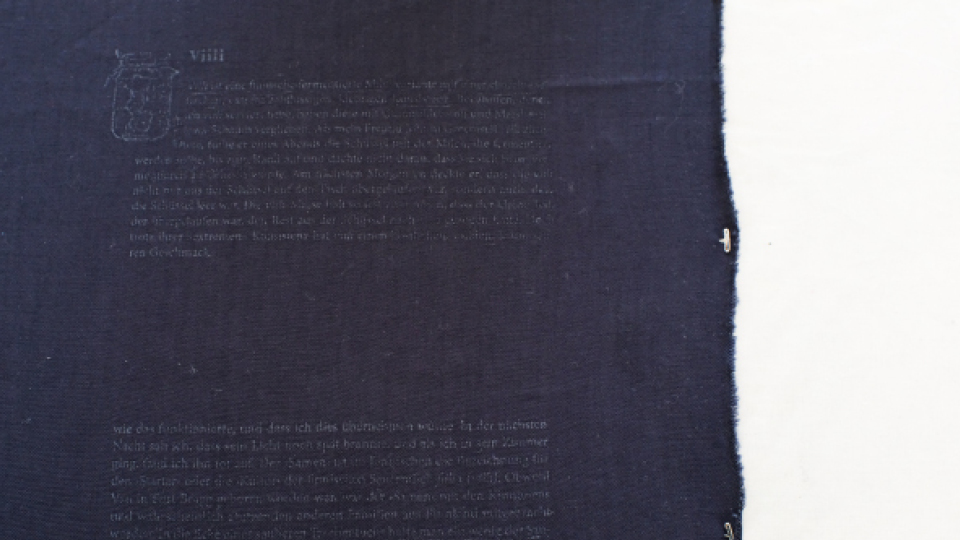
I tried to print some texts on the textile through screen printing

The patterns were inspired by the form of lactobacillus
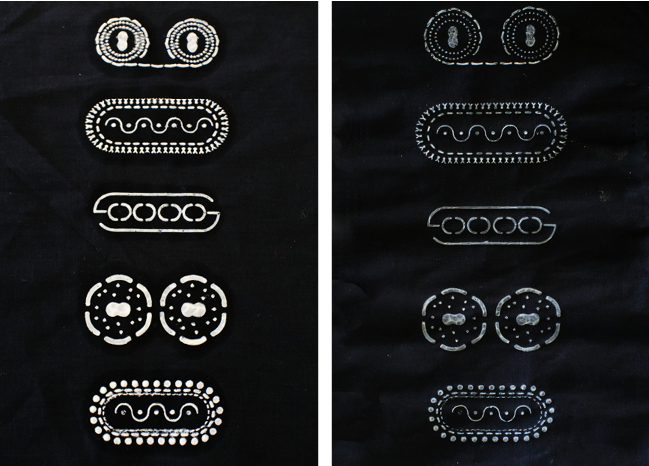
Before and after drying
I chose three kinds of sour milk from different cultures: matsoni from Georgia, viili from Finland, filmjölk from Sweden. The fabric/pattern from each culture has its own striking personality: Geometric pattern of Georgian carpet, Finnish lattice fabric, Swedish Kubrits pattern…I extracted the most representative visual elements in each culture and designed three different flat patterns for each sour milk. The textile as a container has been divided into equal parts with the unit of 10cm *10cm. The negative patterns and the name of related sour milk were screen printed on textile with food colouring, and then the corresponding sour milk was applied on each square to cover the positive pattern. After drying, every little unit square can be cut off and used for fermenting a small bottle of sour milk starter.


The evolution of patterns design for sour milk from three cultures
︎
MAKING PROCESS
I – Screen Printing

The negative patterns of sour milk were screen printed on textile

II – Sewing
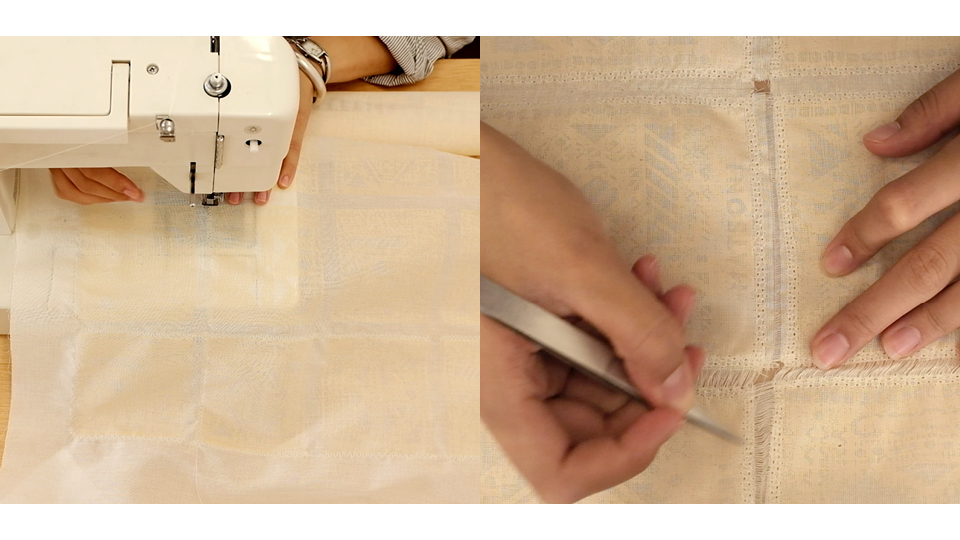
Overlocking the edges of little squares, and pulling out the lines in between
III – Applying the sour milk on fabric
 The processing method of my fabric allows people to cut them off as small squares easily, The lightness of material allows it to be inserted into any corner around. In this sense, the culture not only has the possibility of infinite extension along the longitudinal axis of time but also gets to wander around in different spatial extents whenever people walks by. I cut down pieces of my culture and shared with friends via post or visiting. Thus the micro bacteria rely on a light cloth completed their journey as a wanderer. As the natural fermentation is still full of uncertainties, from the feedbacks of friends,I learned that not every container gets a perfect result. But as a friend said: „it was fun“, I think the „ fun“ is the most substantial reason and most joyful thing, to cultivate and exchange culture, to enjoy fermented food in our daily life.
The processing method of my fabric allows people to cut them off as small squares easily, The lightness of material allows it to be inserted into any corner around. In this sense, the culture not only has the possibility of infinite extension along the longitudinal axis of time but also gets to wander around in different spatial extents whenever people walks by. I cut down pieces of my culture and shared with friends via post or visiting. Thus the micro bacteria rely on a light cloth completed their journey as a wanderer. As the natural fermentation is still full of uncertainties, from the feedbacks of friends,I learned that not every container gets a perfect result. But as a friend said: „it was fun“, I think the „ fun“ is the most substantial reason and most joyful thing, to cultivate and exchange culture, to enjoy fermented food in our daily life.🔍 Have a Look on the project
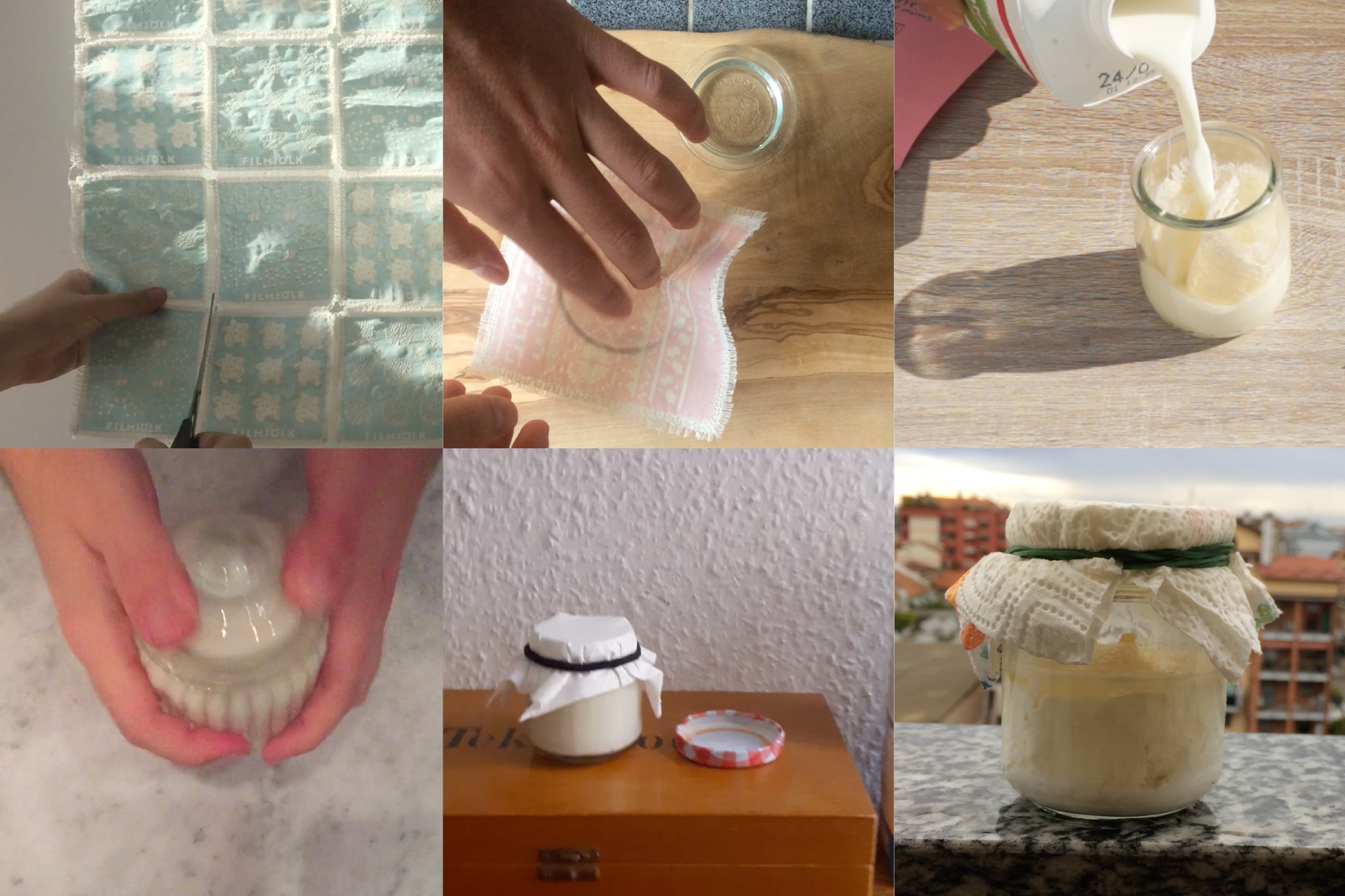
Wanderer | Masterarbeit 2018
Betreuer/in:
Axel Kufus
Johanna Schmeer
Special Thanks to
Edible Alchemy
Julia Kunz
Sandor Ellix Katz
Zining LIU
Fang HU
Dong LIU
Kailin LU
Videos feedback provided by
Filippo Maria MIRASOLE
Samuel VON DÜFFEL
Adrian BACHMANN
Yue LIU
Esmée WILLEMSEN
Juan GAEZE
Crafts behind TOFU DRINK
Chapter 1 - Crafts of Tofu
Beginning with research about traditional Chinese ingredients (soy products) and digging out the various crafts and flavours behind them, we had a chance to look at the way the production of one ingredient can vary at different scales (mass production/middle manufacture/small hand-crafting atelier/home-made), but the different way of producting soy products can also be generalized to one linear process.
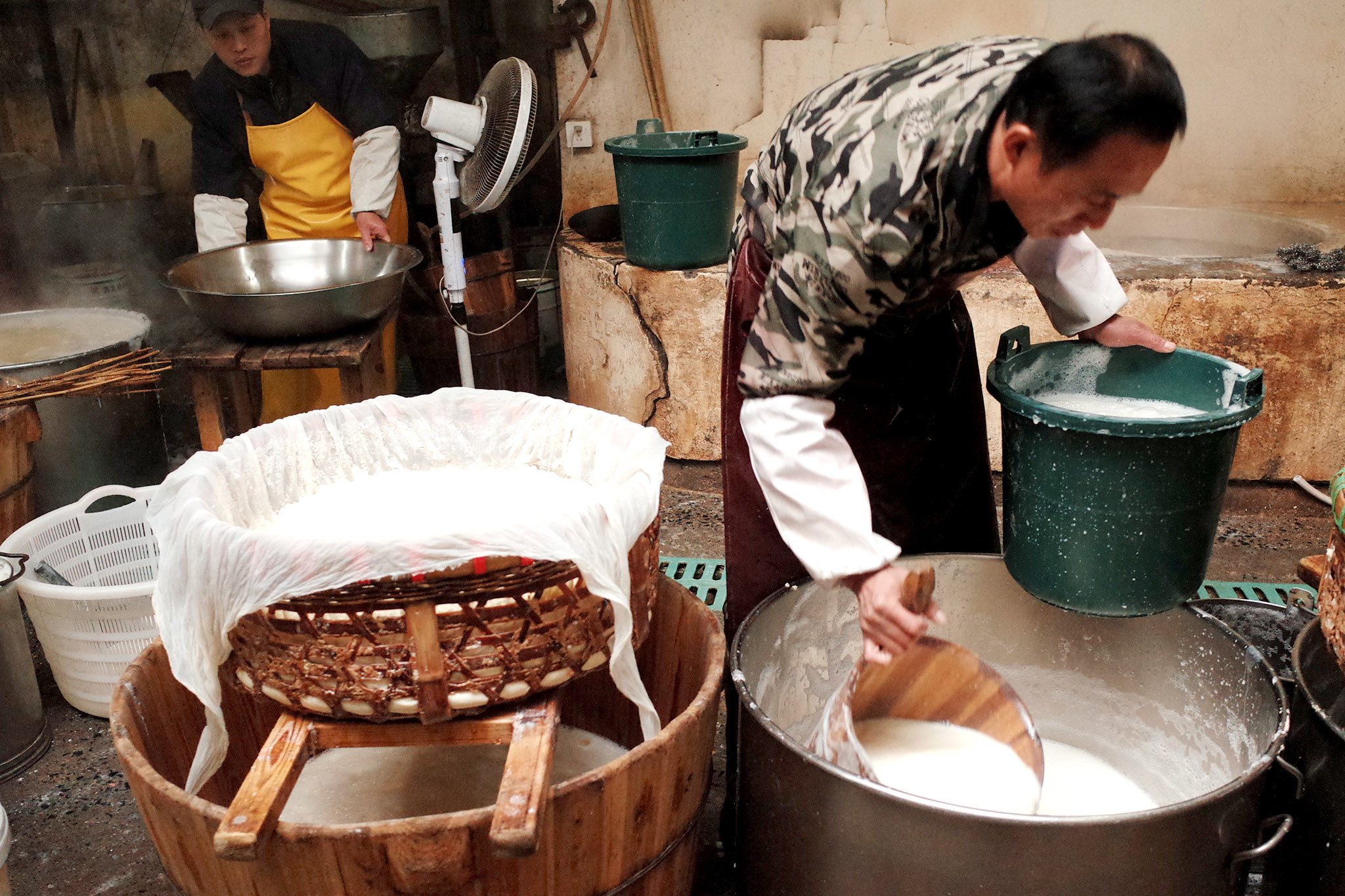
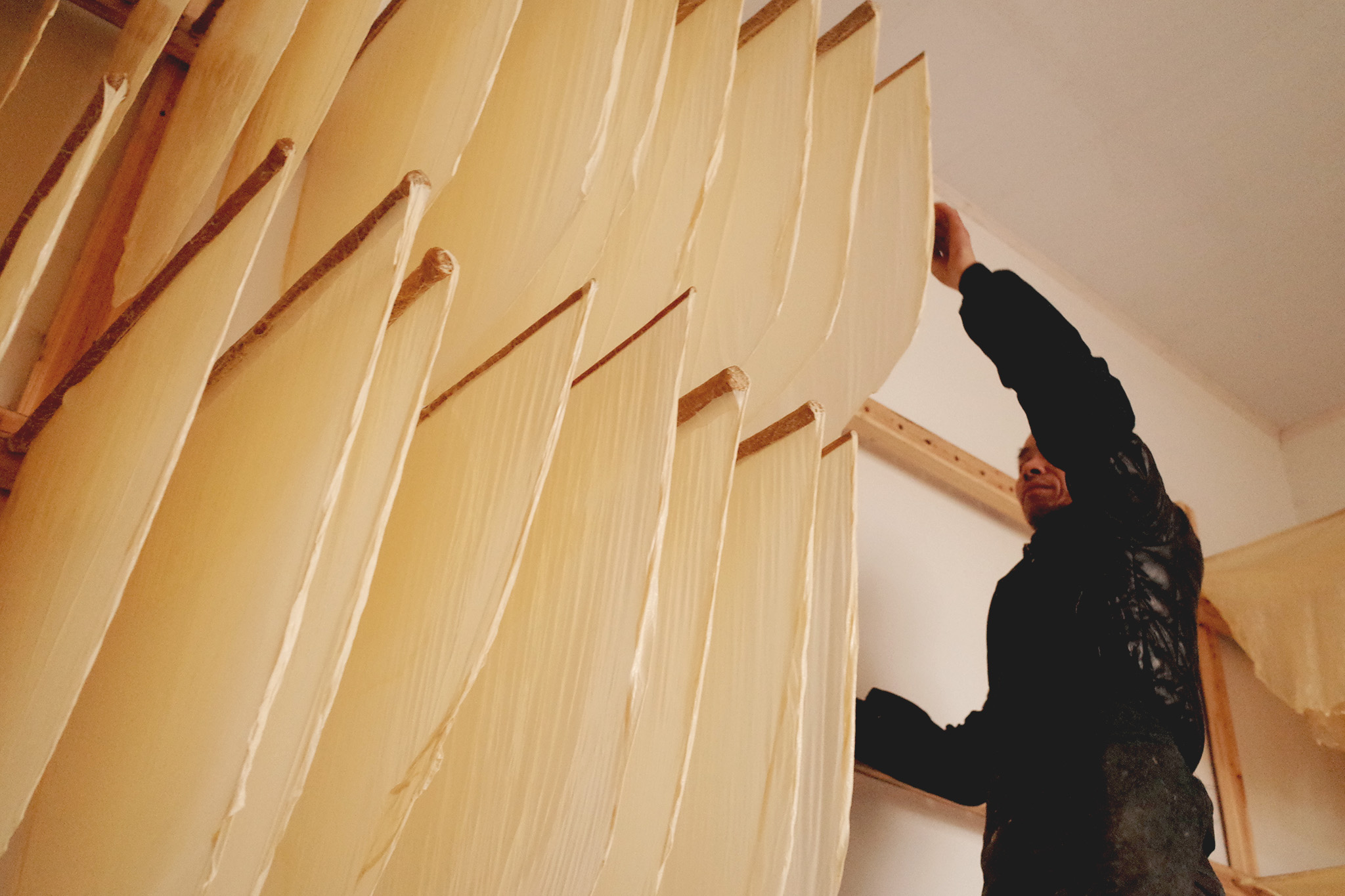
From Soaking (❶) to Blending (❷) the soybeans, then you get a mixture of soybeans which should be filtered till the soymilk left (❸). After the soymilk getting boiled (❹) and being cooled down to 80 °C (❺) add coagulator in it (❺). Wait until the protein inside getting coagulated and put it into a model, press until been formed (❻) -- Then you get your tofu.



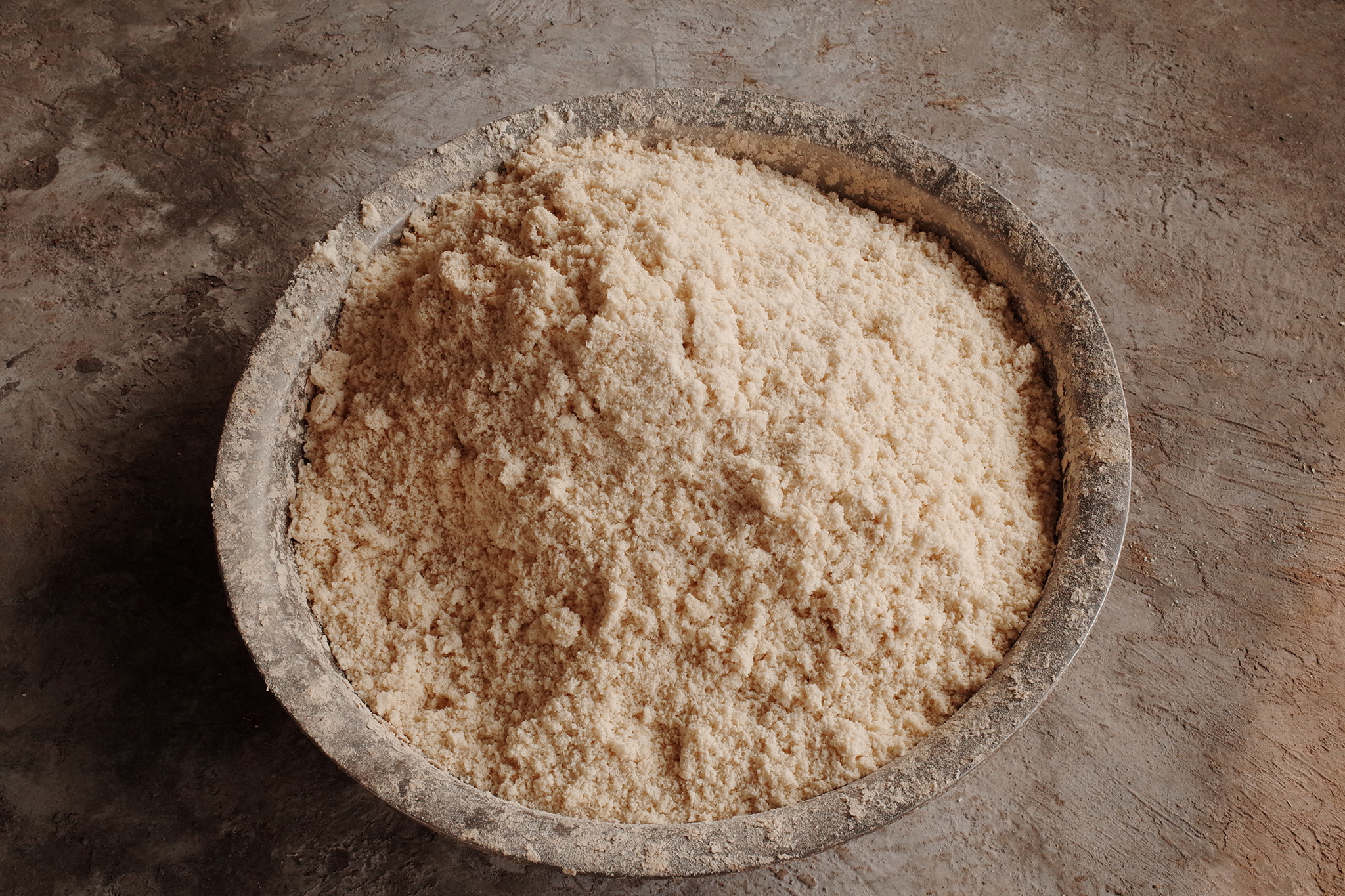
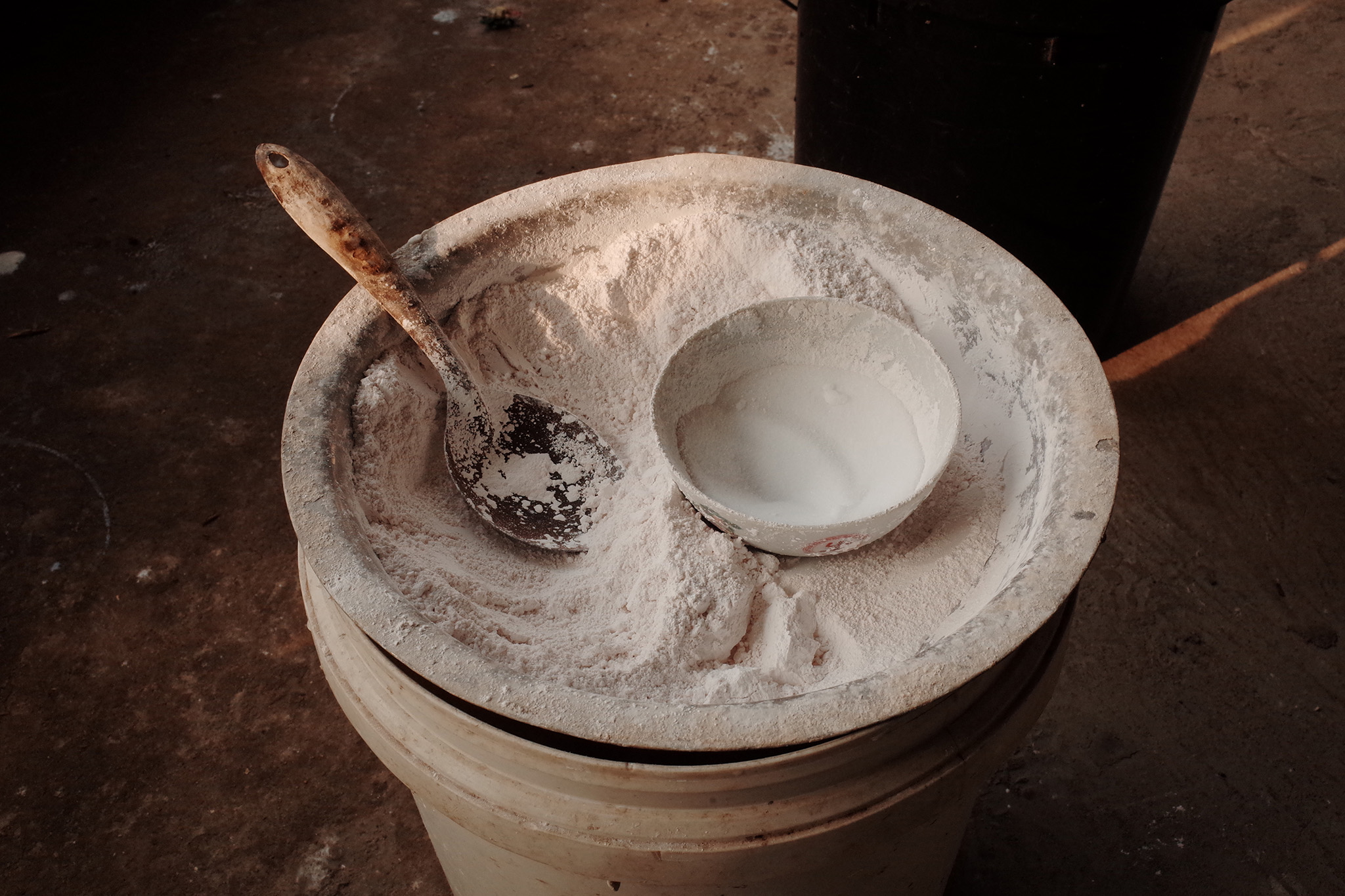
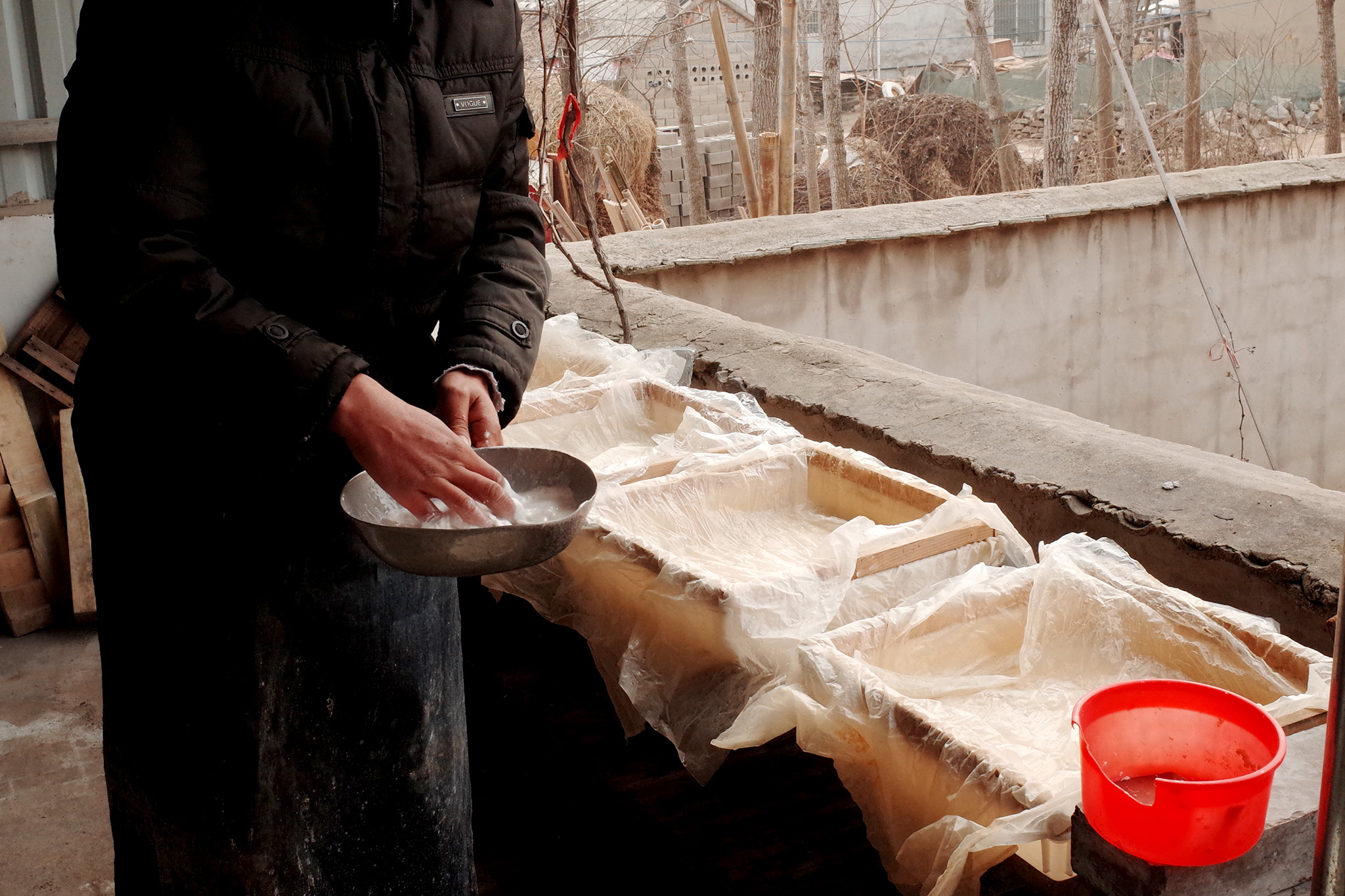
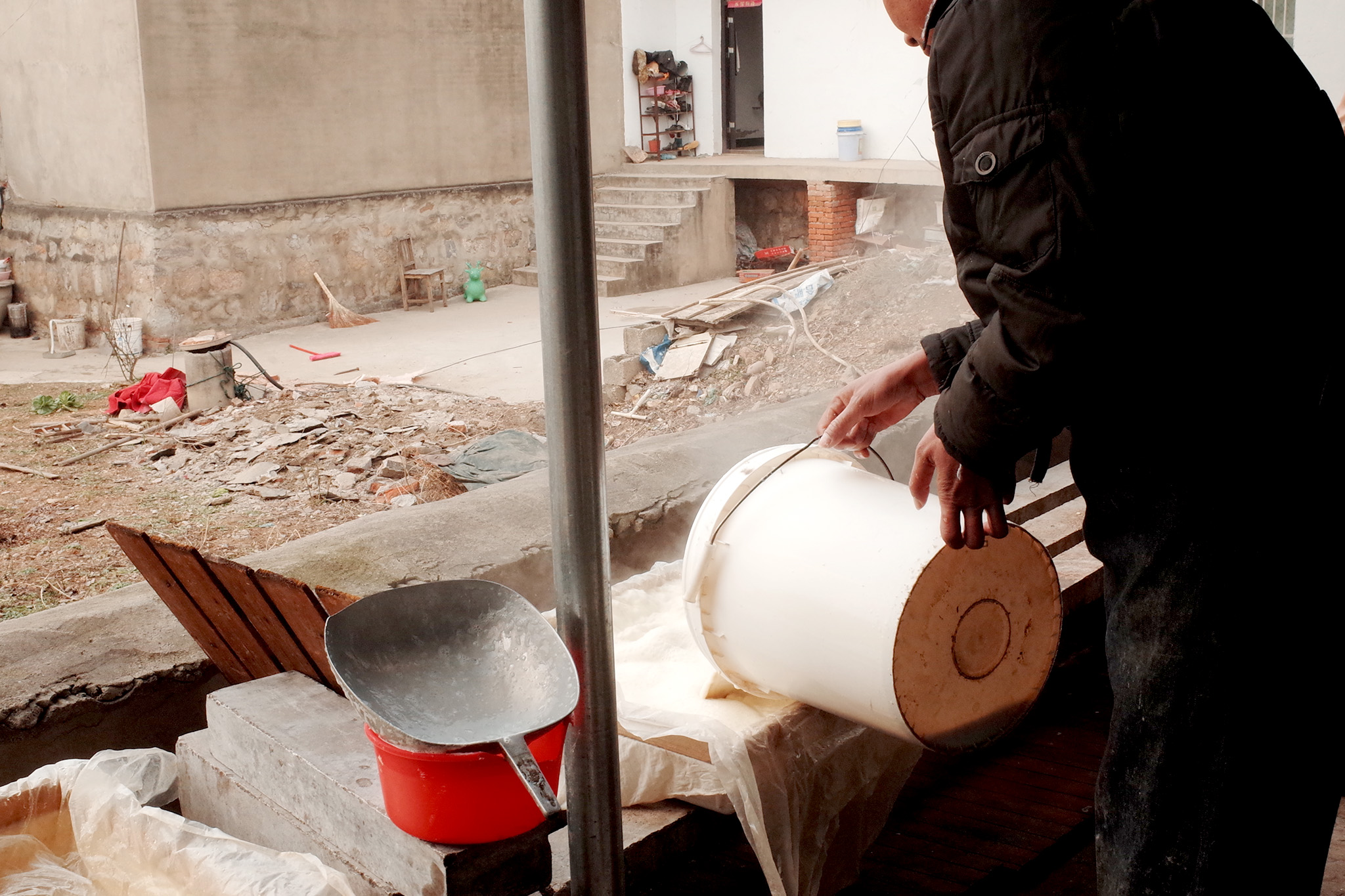
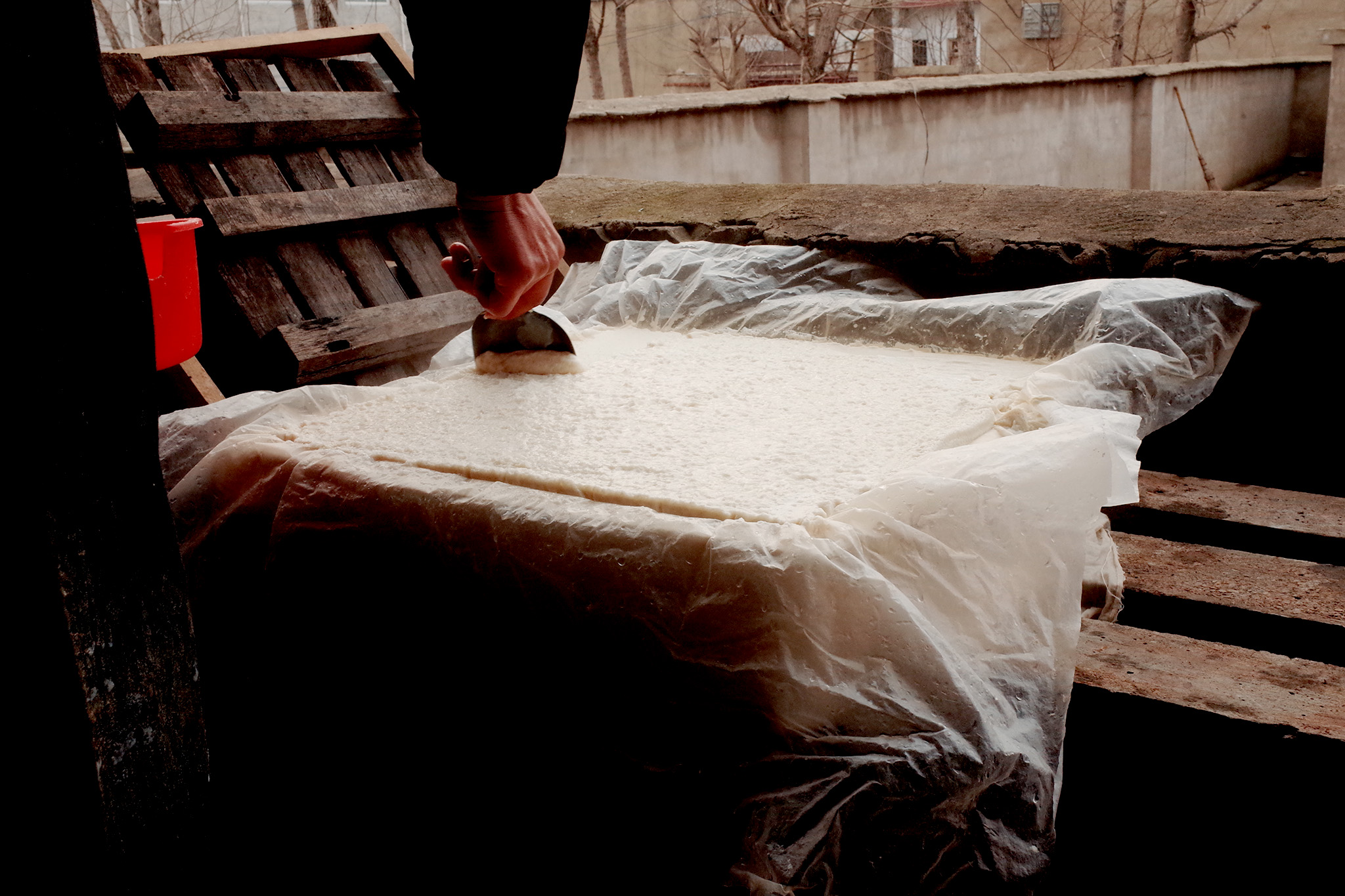

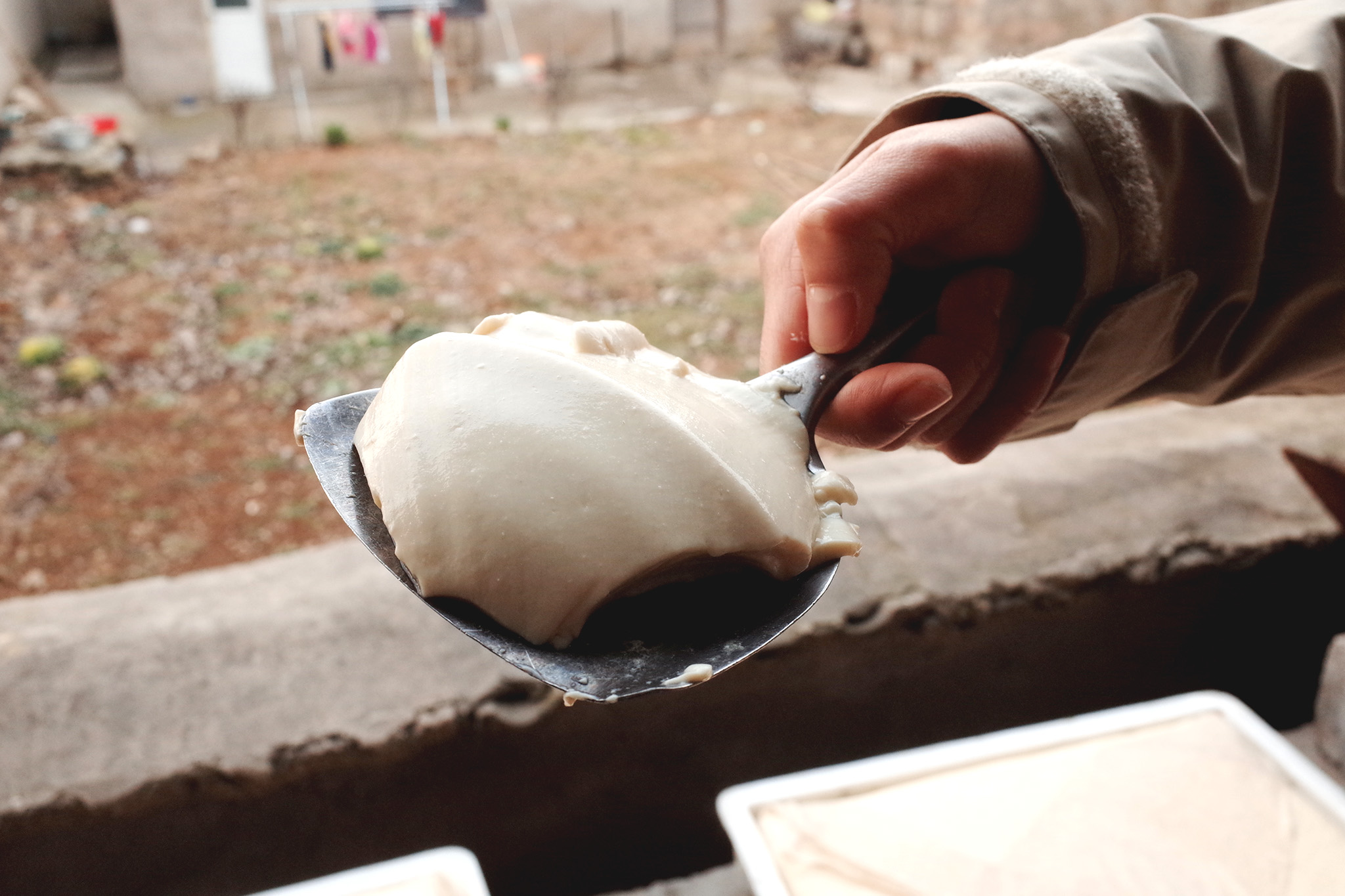

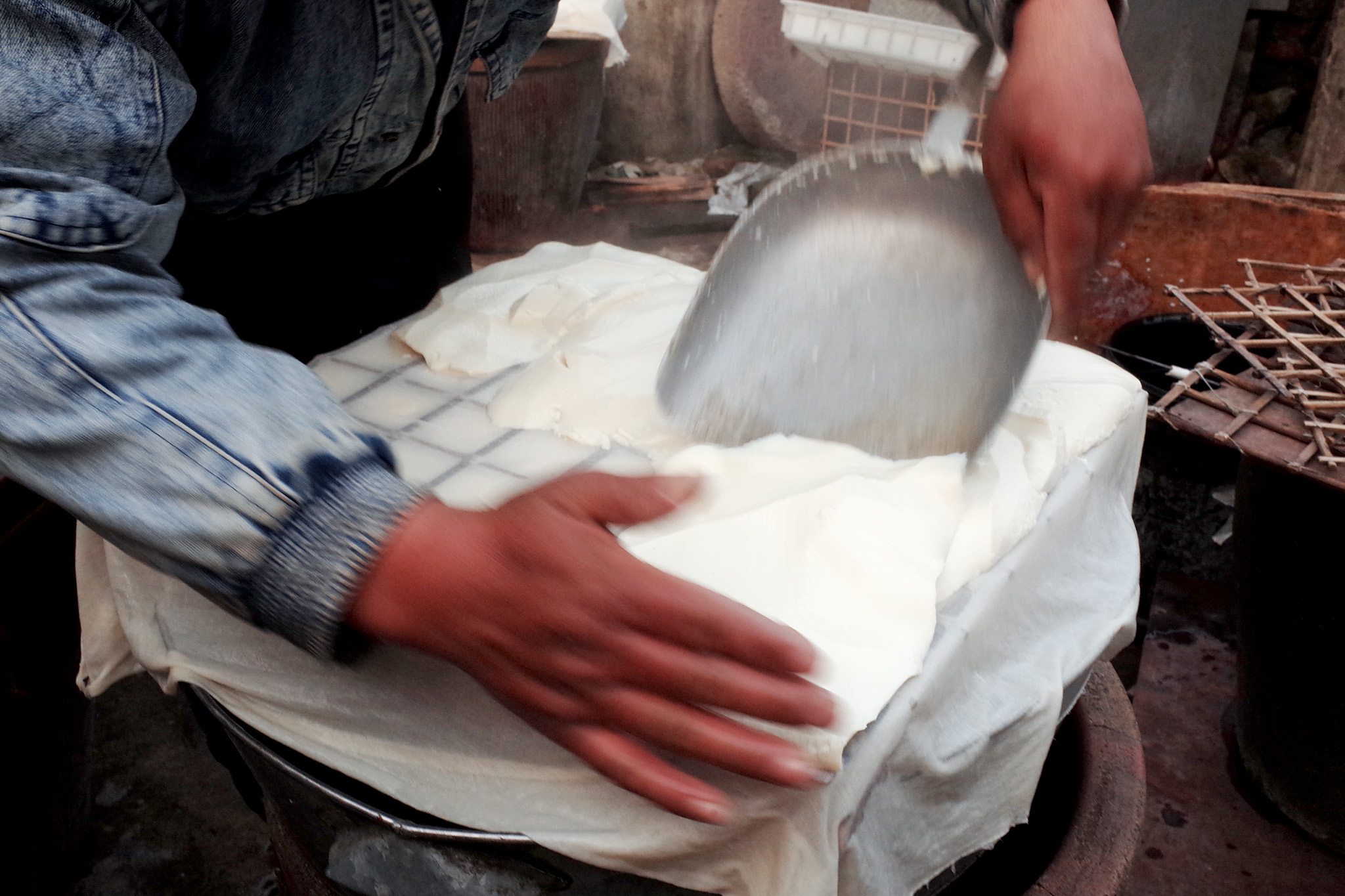
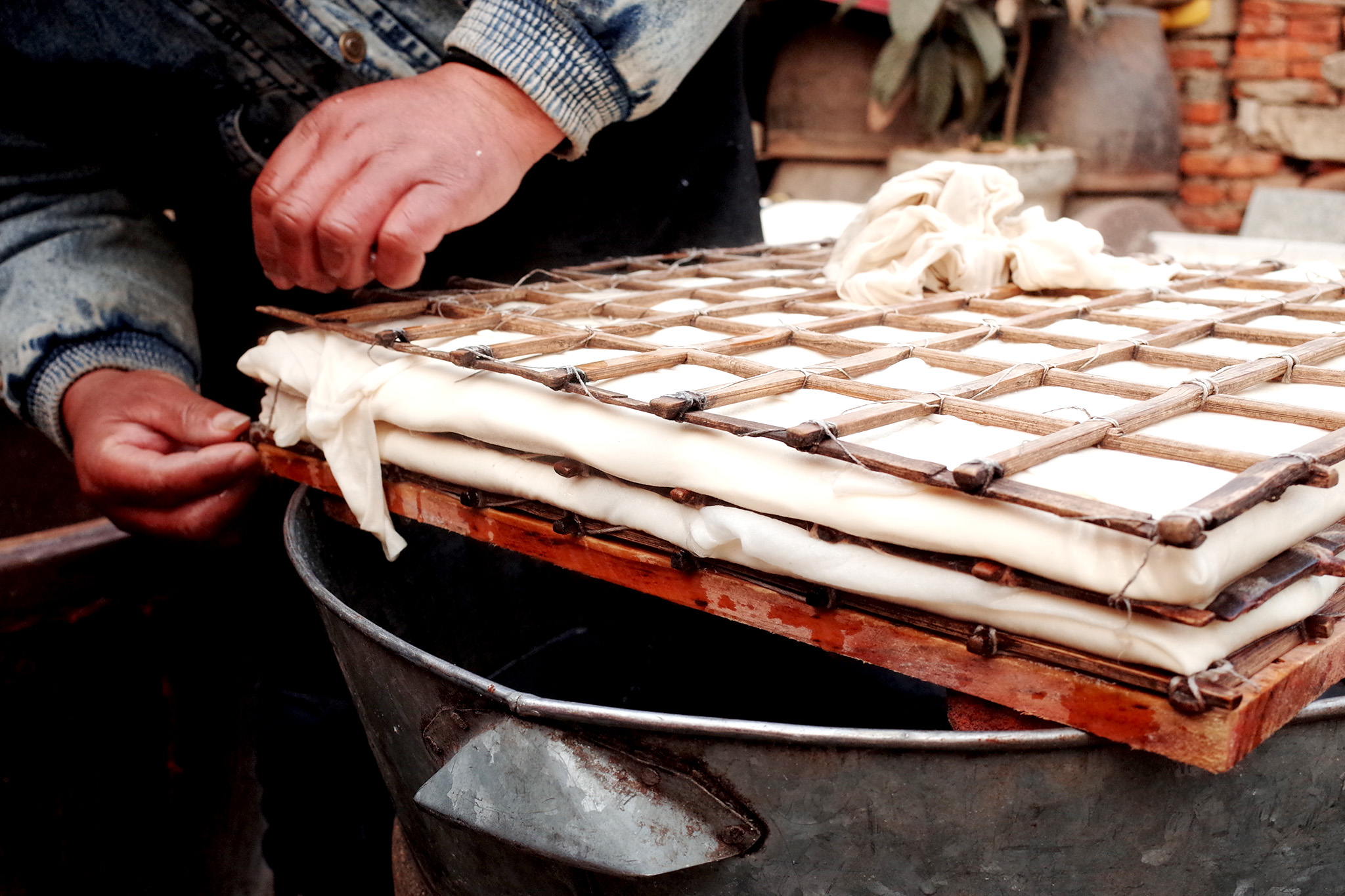
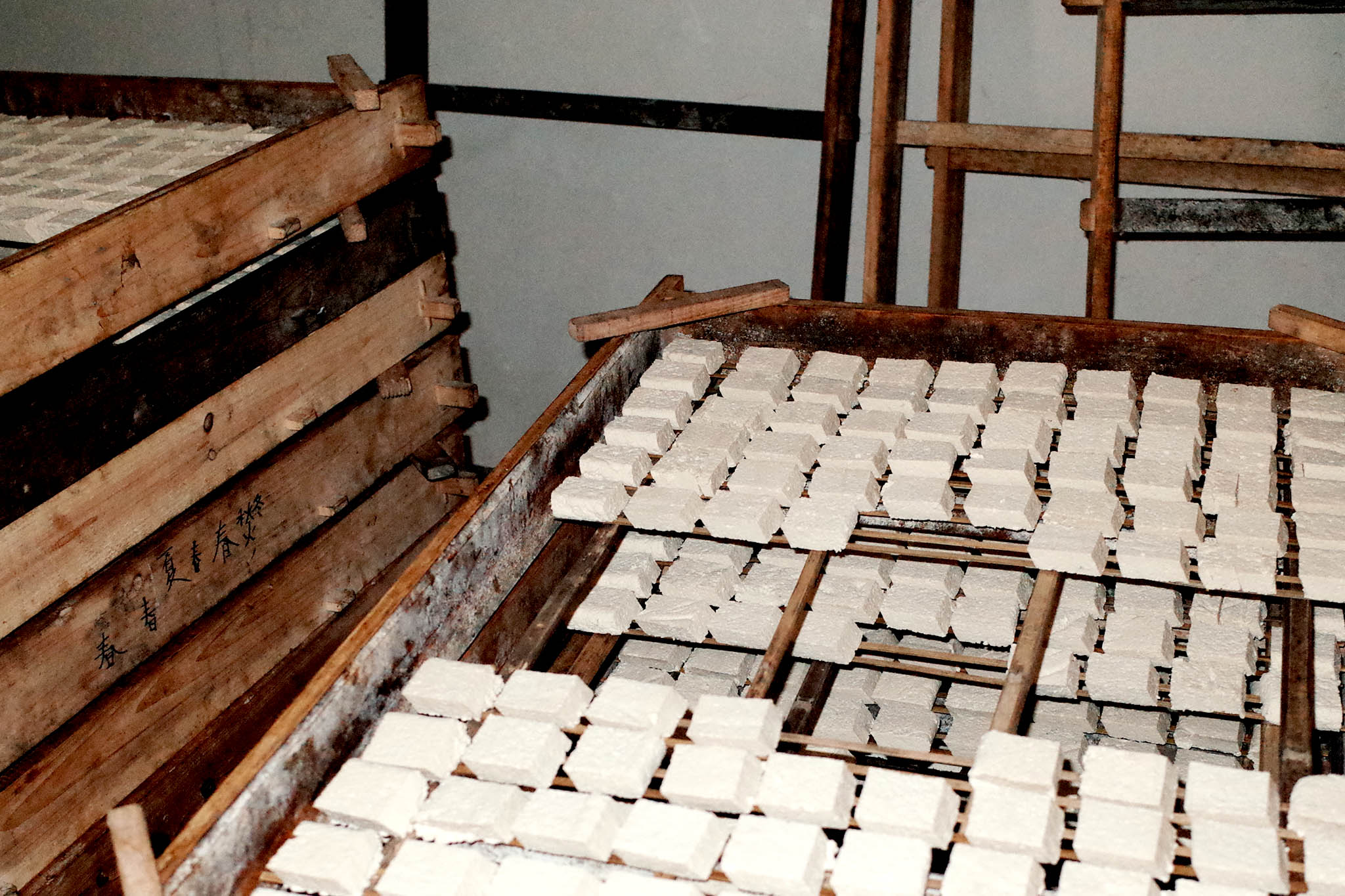
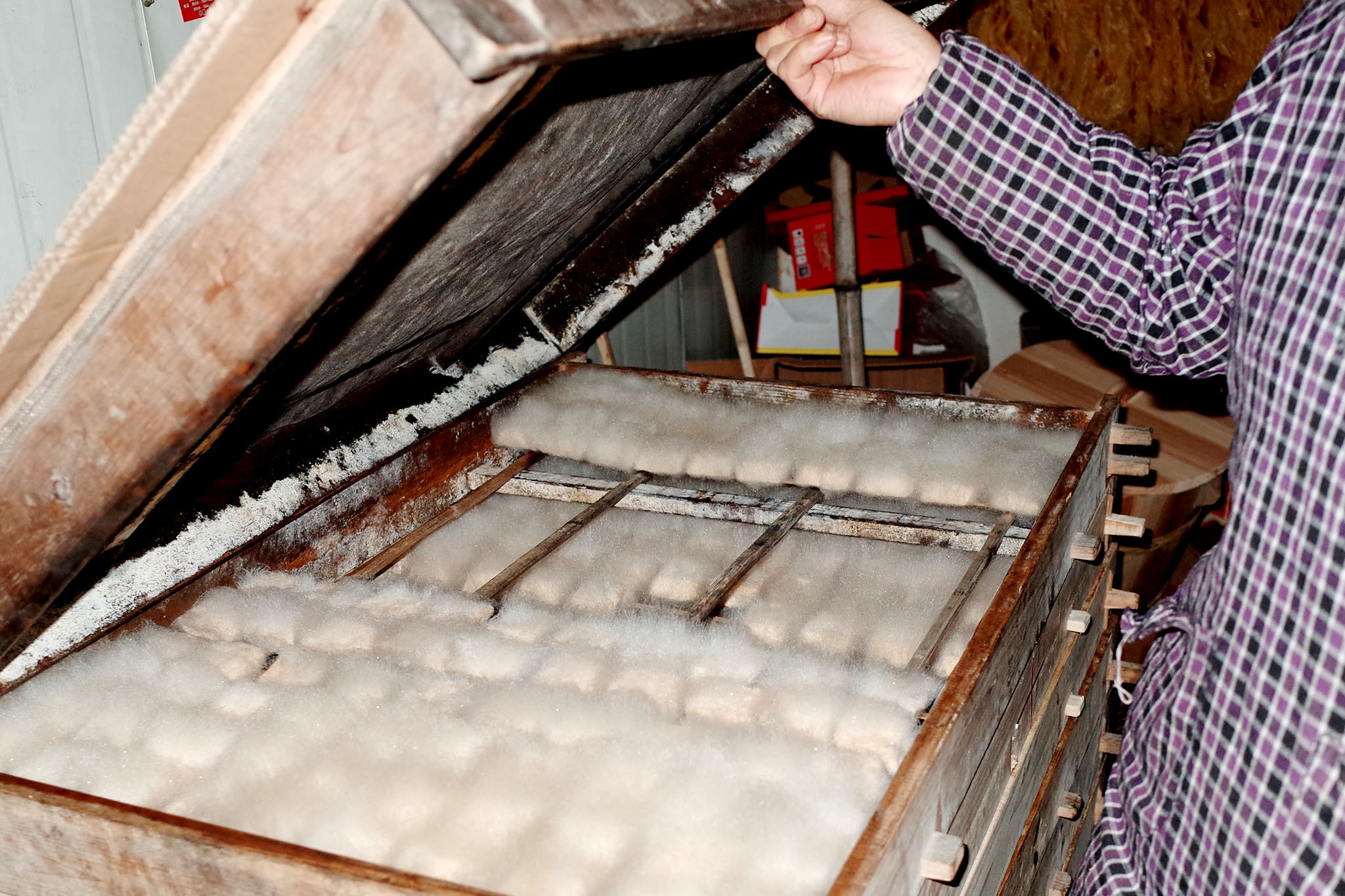
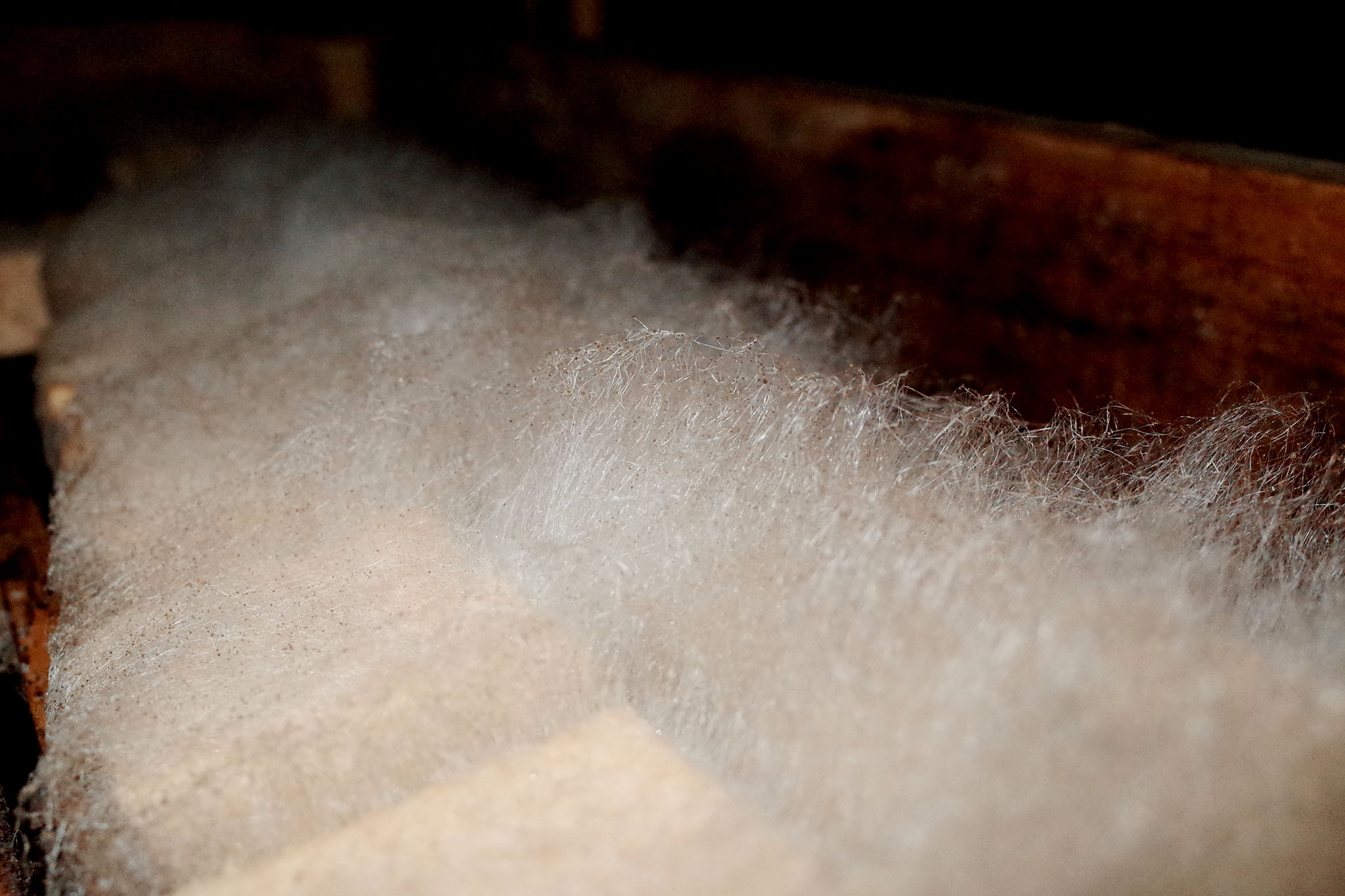




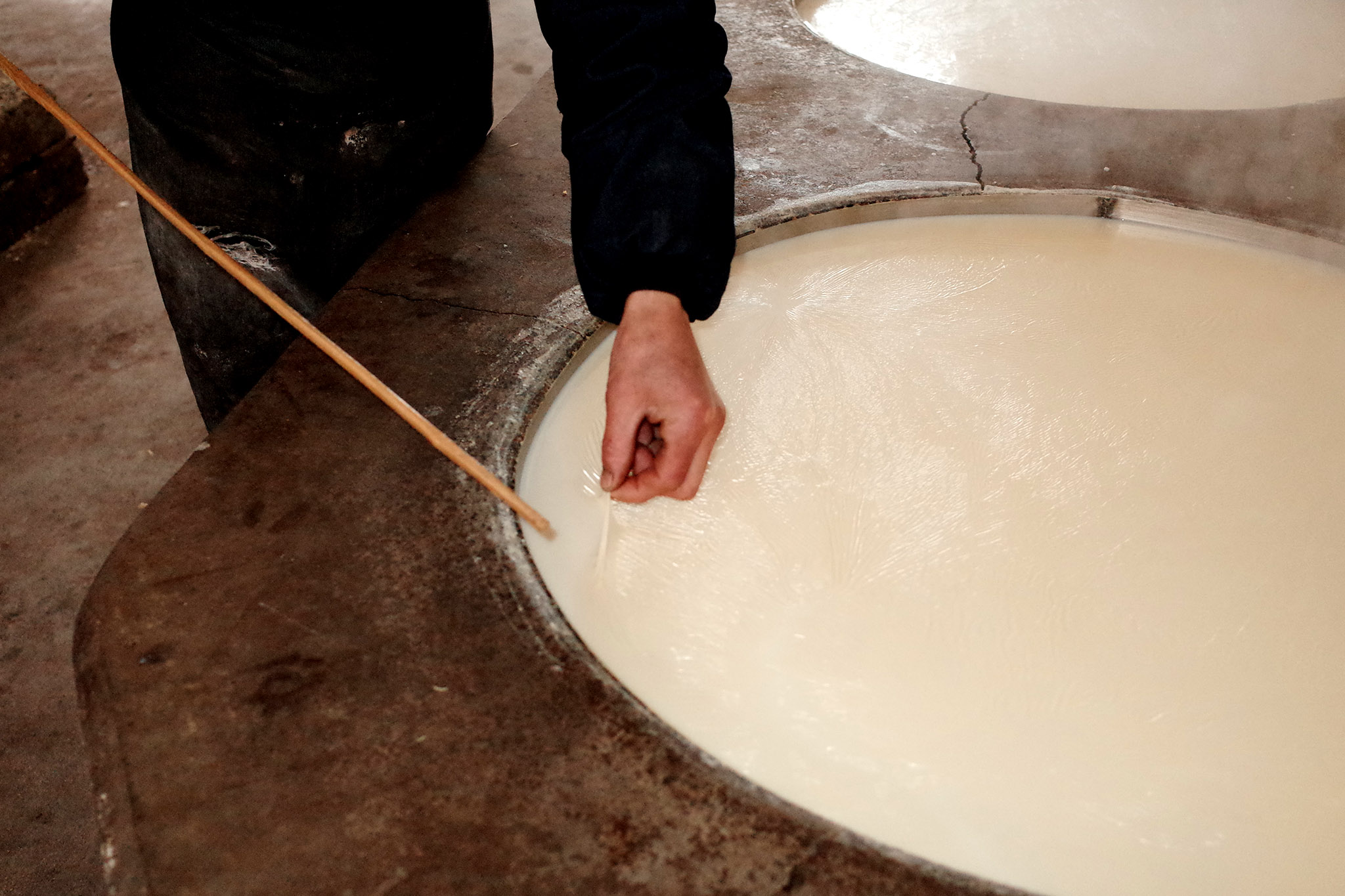
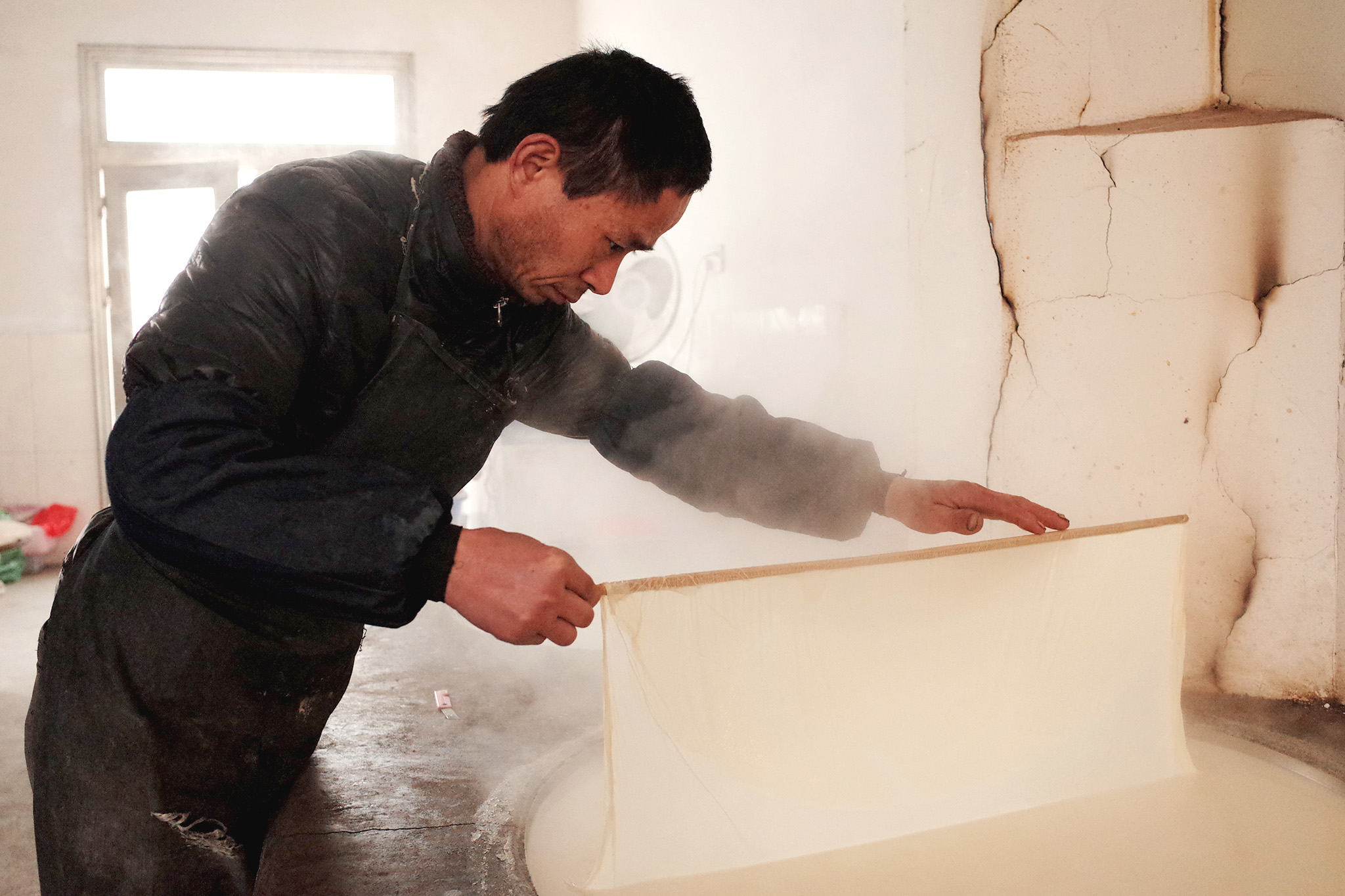
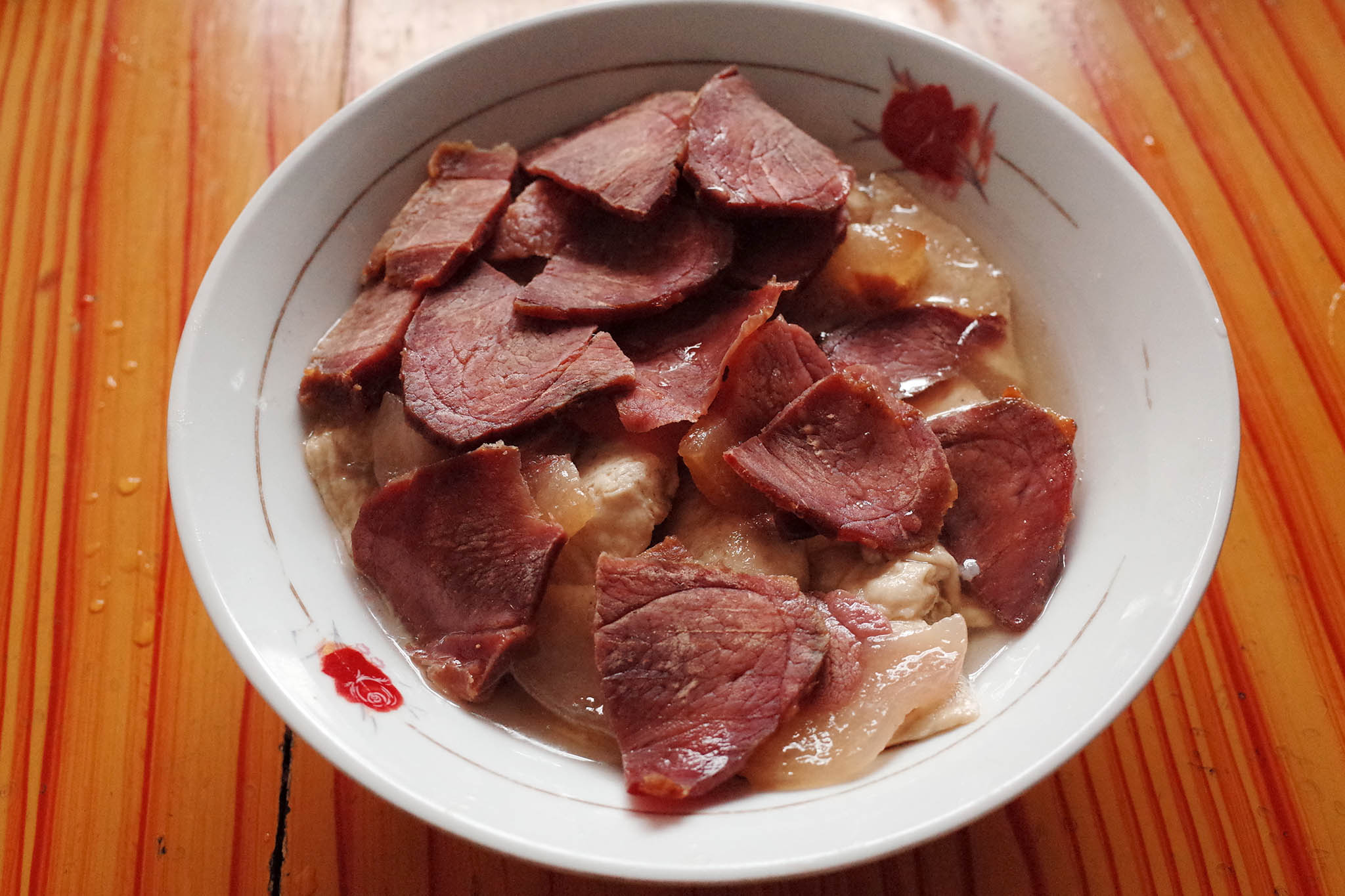



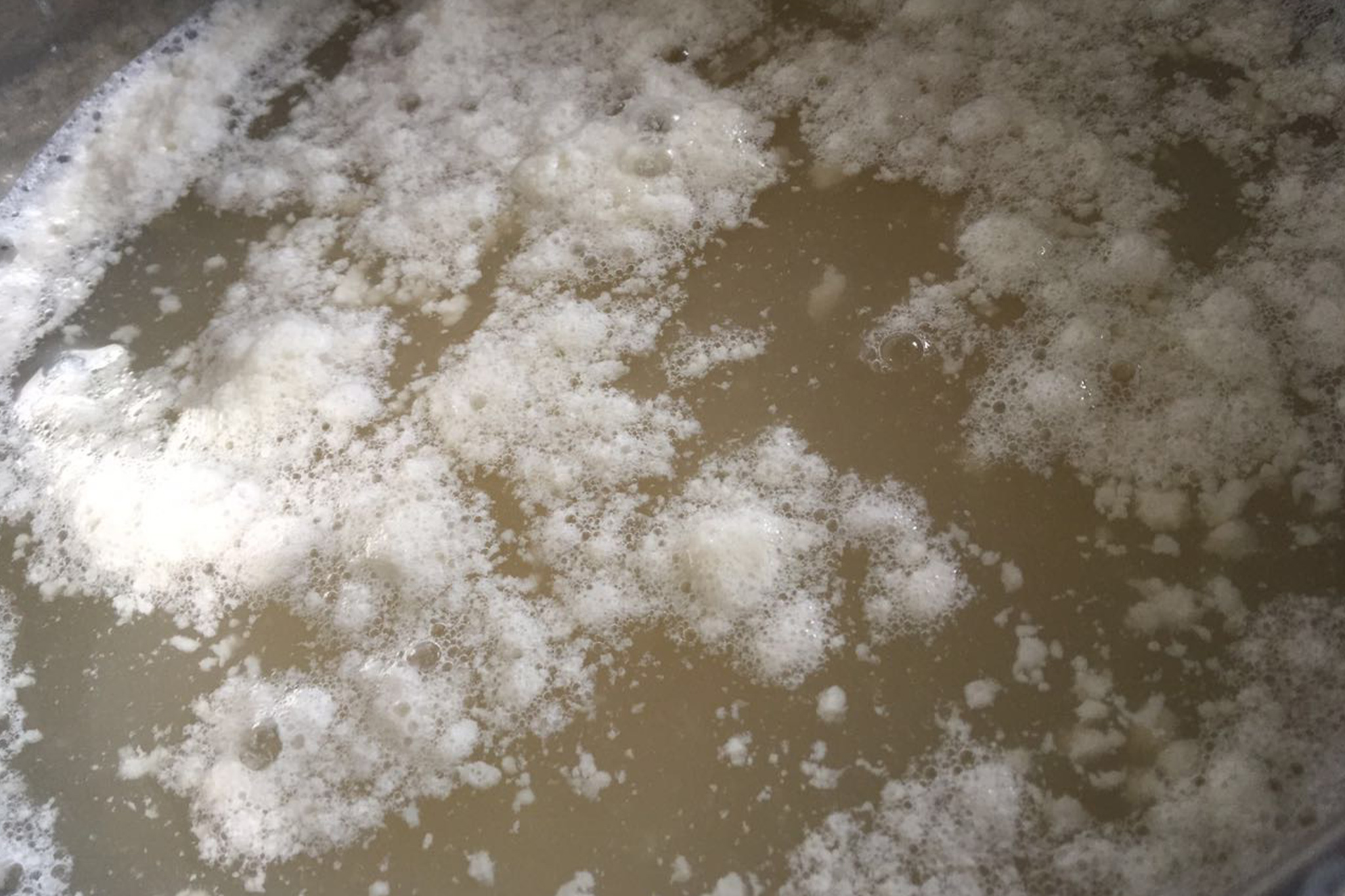
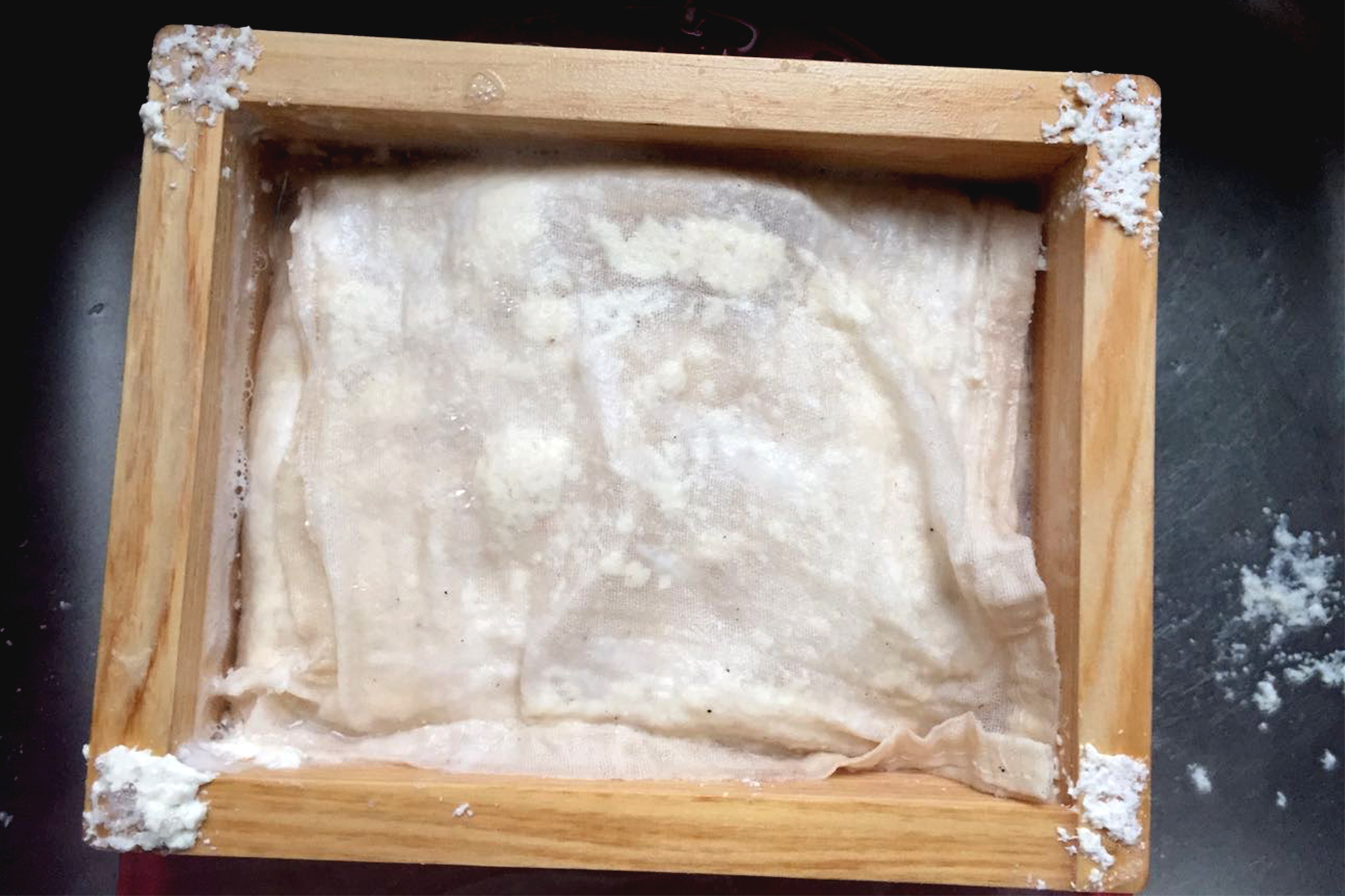
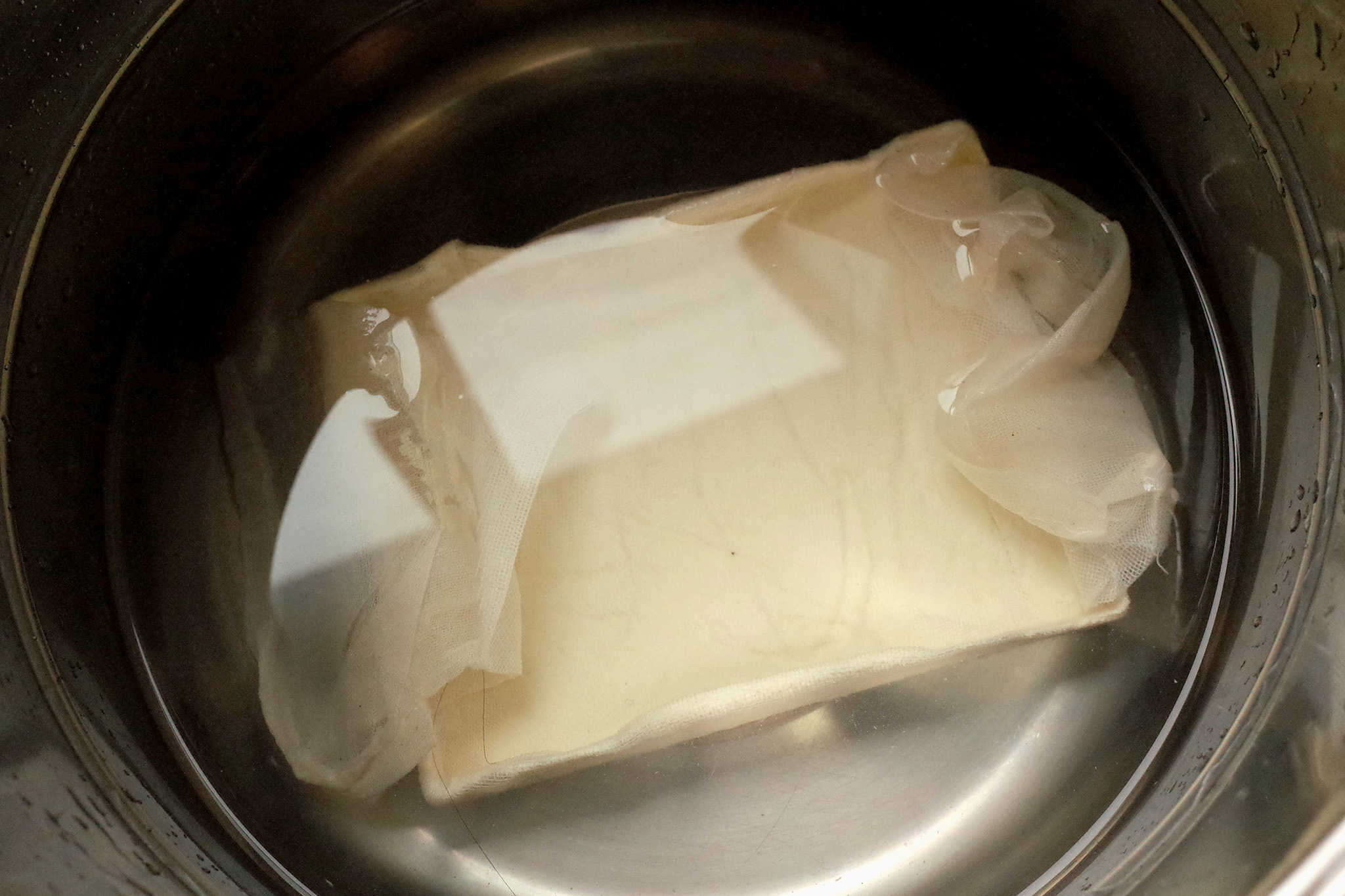


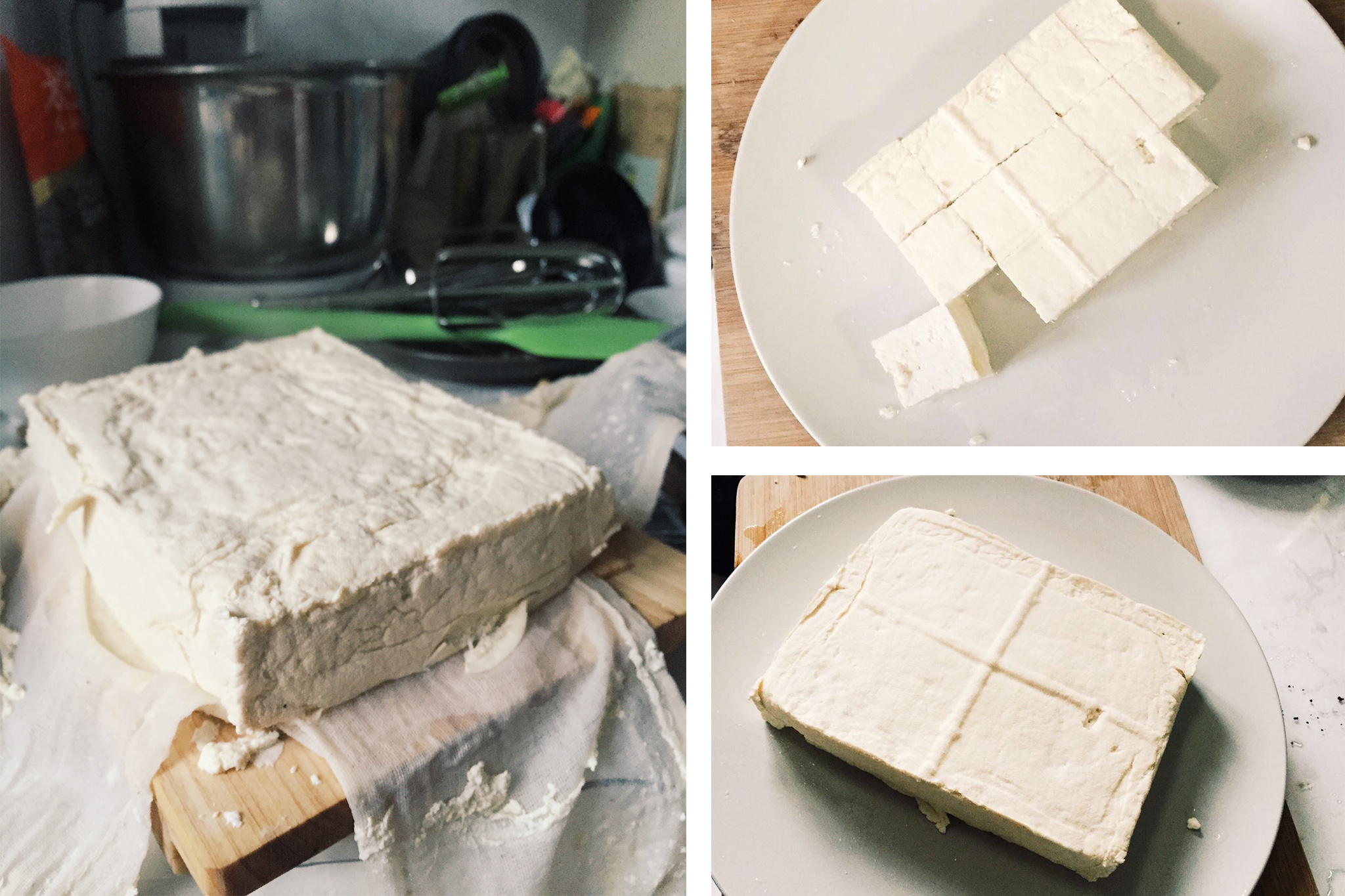

In the final installation of TOFU DRINK we readjusted the making process:

︎
Chapter 2 - Crafts of TOFU DRINK
Combining woods, ceramics, glass, metal together, the production process of tofu drinkincludes cooperation with hand craft master in different fields.

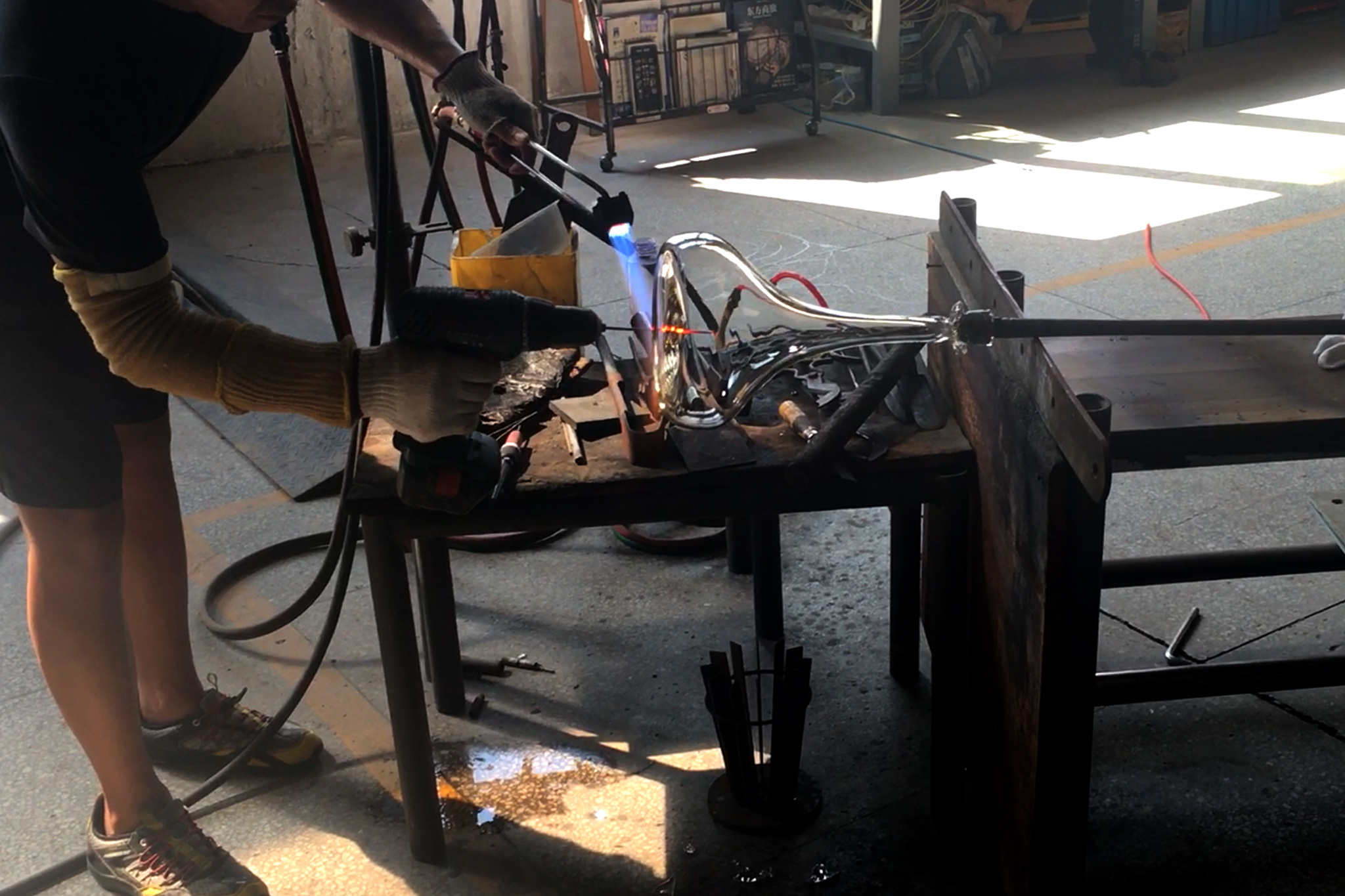

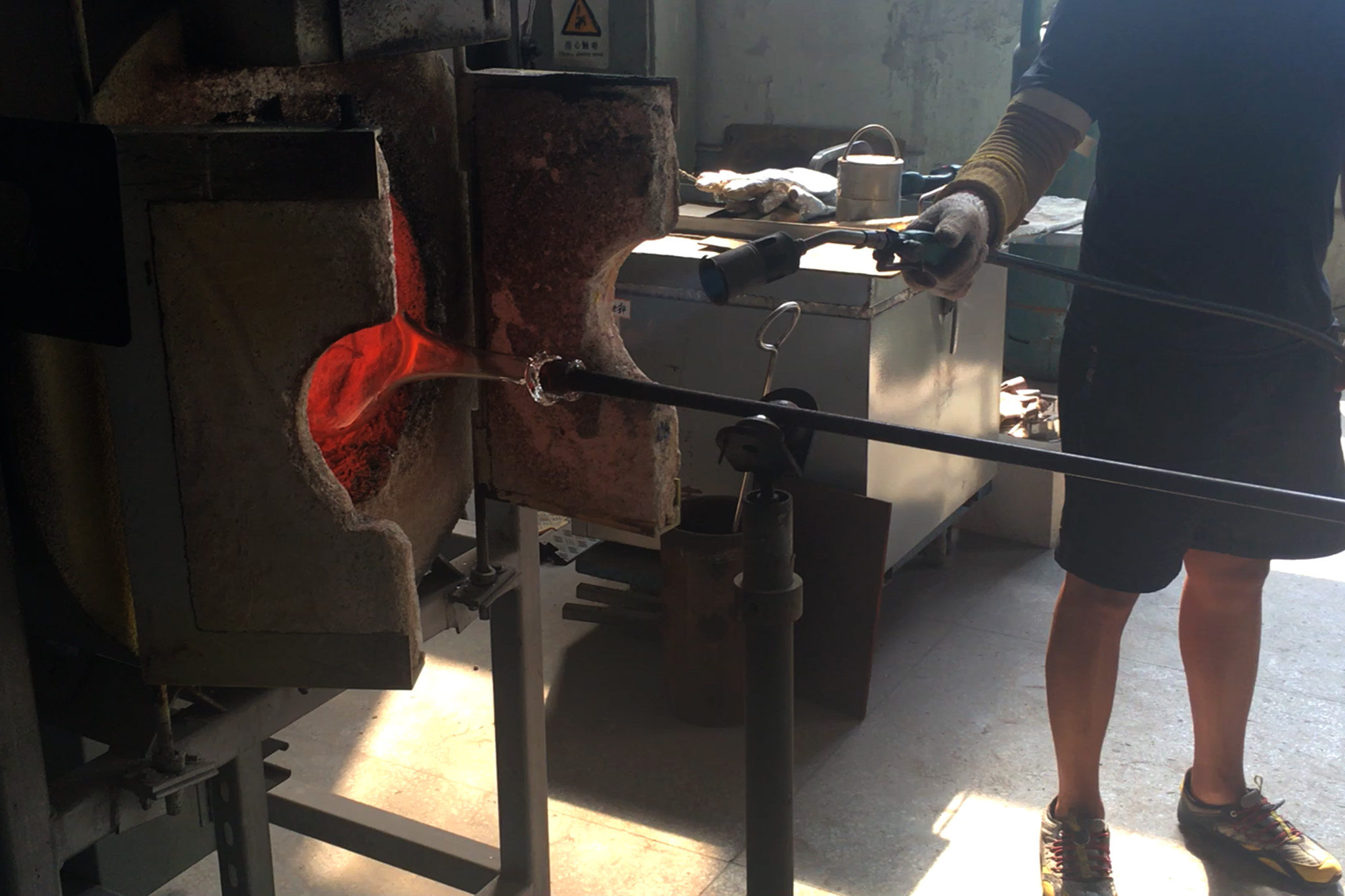
We worked in coperate with a glass atelier in Shanghai to modify our glas parts.


The Breath of MINI LIVING - 米兰设计周体验食物艺术
24.04.2017 | 悦&溪婧
MINI LIVING 是意大利造车品牌MINI旗下的一个持续进行的实验设计项目,他们为城市生活提出新理念,创造新的生活空间。在2017的米兰设计周中他们与SO-LI建筑工作室合作,打造了这个名为”Breathe”的体验空间,旨在能够在有限的空间与资源的前提下建立一种可持续的生活方式,同时在与之相伴的展览空间中介绍了与现代生活紧密相关不同领域的前沿设计作品与设计师。
︎
在展览中 Laila Gohar 和 Pepi de Boissieu 的作品吸引了我们的注意。Laila Gohar是位驻足纽约的设计师,将食物作为艺术媒介和传播工具,通过创造欢乐、多感官的试用活动来探索人类互动的本质;Pepi de Boissieu在巴塞罗那经营一间创意工作室,作品主要聚焦于食物。两位设计师携手创造了一个饮食体验空间“The Art of Good Food”,通过一个“有意识的”的Bar向有食趣并愿意为此支付5€的食客们展示了一份充满诗意且营养十足的菜单,借此希望将人们与生活之基本所需——土壤、阳光、氧气与水再次相连。展示空间依照四个生活基本元素分区,同时向人们展示人类是如何将它们借助饮食转换为能量。
The Art of Good Food | 一个“有意识的”Bar
EARTH.
Eating local is a great way to cut down on lood
miles and, if you want to start right now. you can
help yourself to some of these Milanese mushrooms.
sprouted right here at Salone del Mobile. and served
on an earthy mix of wild rice and quinoa.
OXYGEN.
Feeling tired? Time to take a deep breath and
sprinkle on some sprouts. The high iron content
in these alfalfa sprouts ensures you get the most
from the air you breathe by raising your blood’s
oxygen level.
WATER.
Our bodies are more than half water, which means
we're a lot more hydrated than a bottle of cooking
oil, but lagging way behind the rambutan. Discover
how the different foods score on the water scale.
SUN.
As well as providing us with warmth. light, and
vitamin D, the sun also offers a food preservation
service no refrigerator can beat. We’ve used simple
sunlight to create these fruit leathers - a little
piece of sunshine you can taste.
Eating local is a great way to cut down on lood
miles and, if you want to start right now. you can
help yourself to some of these Milanese mushrooms.
sprouted right here at Salone del Mobile. and served
on an earthy mix of wild rice and quinoa.
OXYGEN.
Feeling tired? Time to take a deep breath and
sprinkle on some sprouts. The high iron content
in these alfalfa sprouts ensures you get the most
from the air you breathe by raising your blood’s
oxygen level.
WATER.
Our bodies are more than half water, which means
we're a lot more hydrated than a bottle of cooking
oil, but lagging way behind the rambutan. Discover
how the different foods score on the water scale.
SUN.
As well as providing us with warmth. light, and
vitamin D, the sun also offers a food preservation
service no refrigerator can beat. We’ve used simple
sunlight to create these fruit leathers - a little
piece of sunshine you can taste.
突然邂逅这样一件作品,不知是该感叹确实在欧美、我们之前视野之外的世界各地活跃着各种各样的食物设计师,还是该赞美自己好运气,毕竟在mini living和so-li建筑的合作空间外排队近一个小时的疲惫后,确实只想悠闲坐坐吃吃,顺便听听故事了。
展区内四个不同主题被布置环绕在空间四周,当我们在前台点单,每人被分配到一个小碗与一只汤匙后,便开始了绕场一步一步的流程体验。
︎
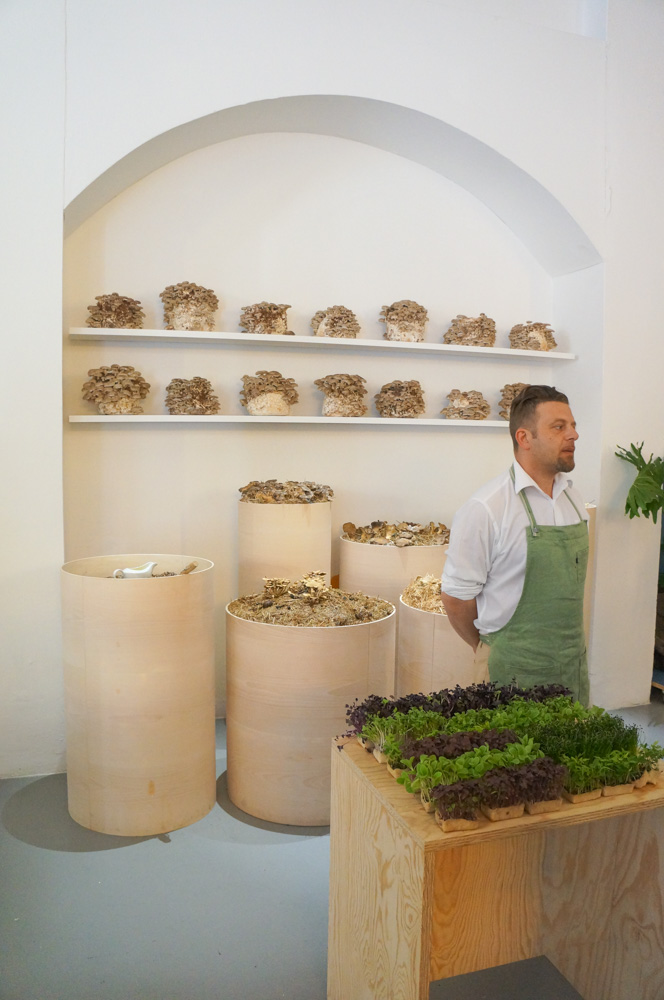
EARTH SALAD.
Using a sprouting system we created a funghi ecosystem.
These mushrooms were grown right here in this cafe, proving
that with ingenuity and some effort food can be grown within 0 km.
Living spaces can be be reimagined into farming spaces.
/
Wild rice, quinoa, brown rice, mixed mushroom, spring onion.
OXYGEN.
Using the scissors, chop sprouts and sprinkle onto the earth salad.
Using a sprouting system we created a funghi ecosystem.
These mushrooms were grown right here in this cafe, proving
that with ingenuity and some effort food can be grown within 0 km.
Living spaces can be be reimagined into farming spaces.
/
Wild rice, quinoa, brown rice, mixed mushroom, spring onion.
OXYGEN.
Using the scissors, chop sprouts and sprinkle onto the earth salad.
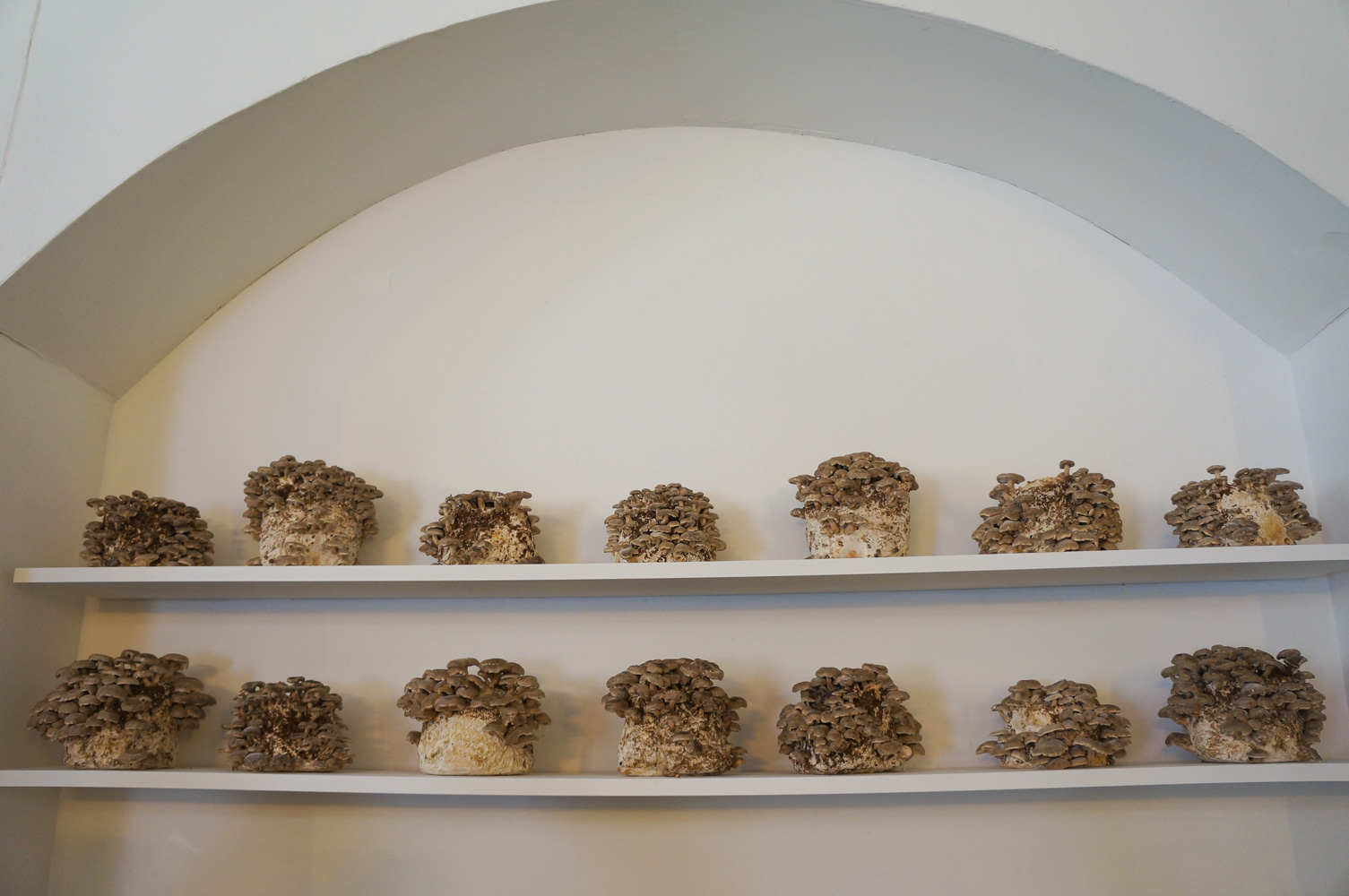
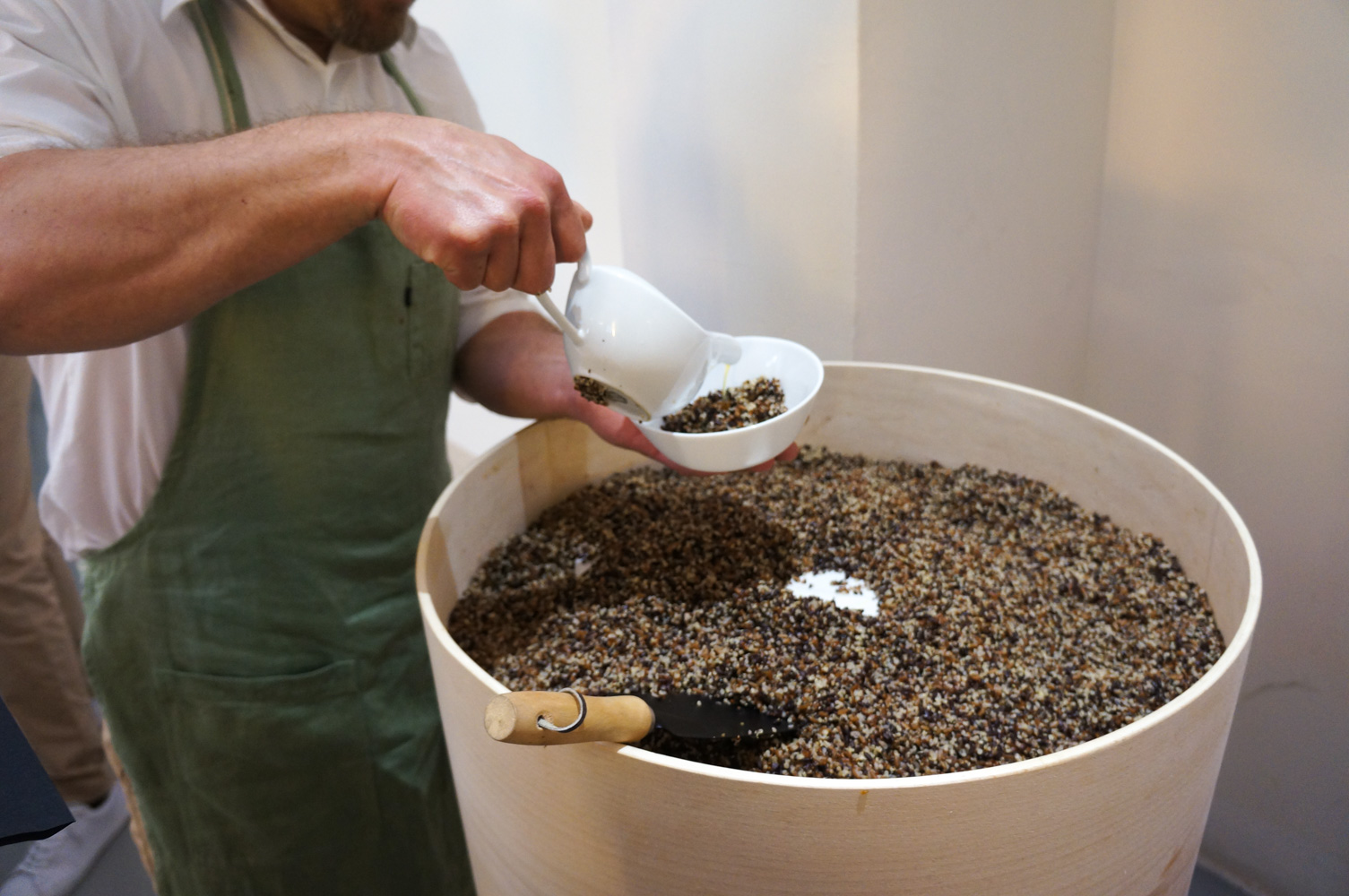
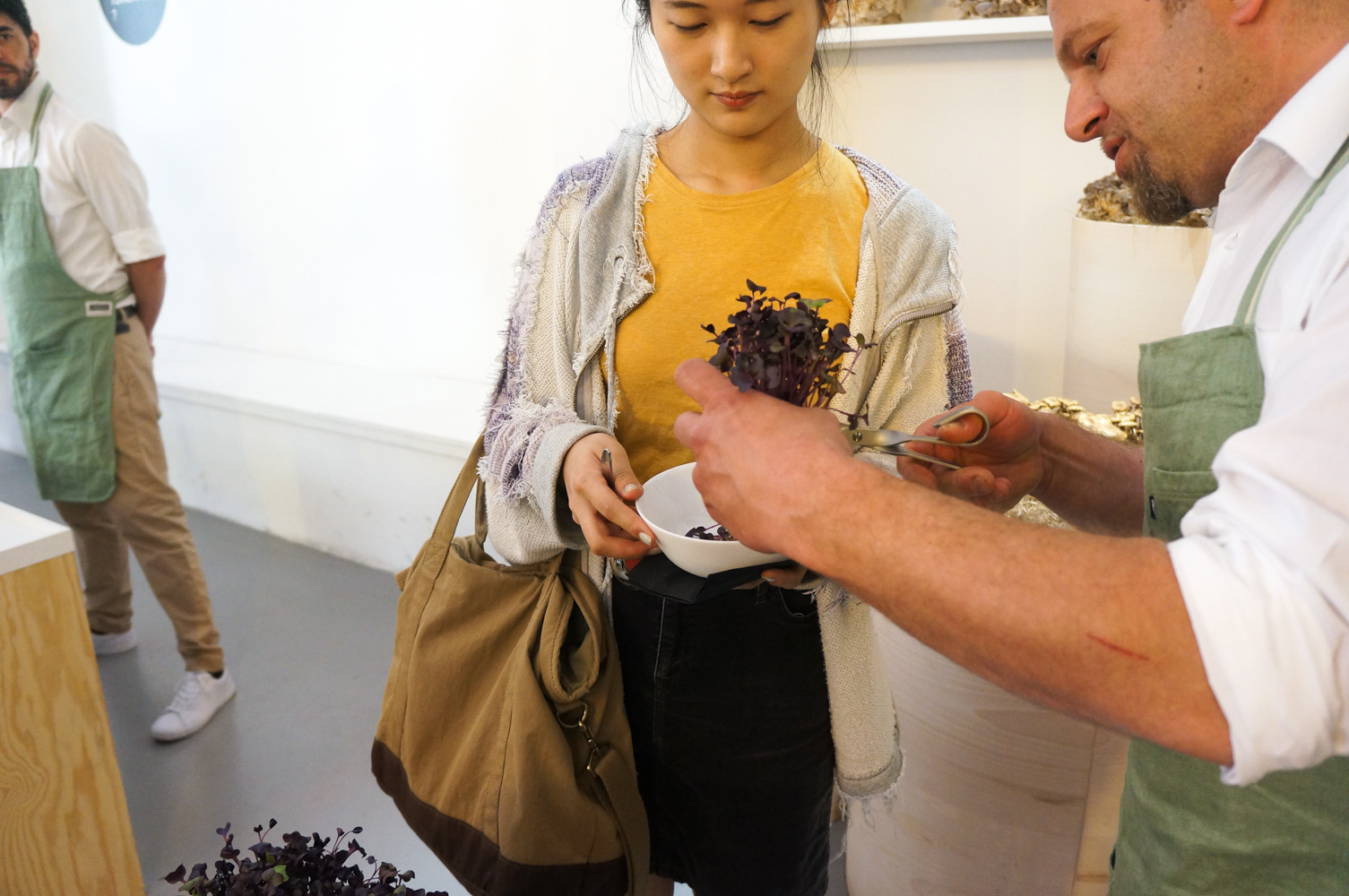
首先来到“地味”与“气味”单元。展柜上几团菌类丛生的泥土团,极力营造着刚从大自然中挖来的“野”态,然而似乎却是在场馆展厅之内被培育出来的实验物种。讲解员兼服务生为我们拔下几丛,又淘起一把野米撒上,再从密密麻麻的芽菜中剪下一二,浇在着原生态满满的一晚“地味沙拉”上,便算是前菜了。
习惯了奶酪与红酒的沉重口味,清新菜味地到来别致地点缀了舌尖,我们懵懂点头:确实是十分“地味”了。
︎

WATER SCALE.
This water scale is designed to express the water content in different foods.
Starting from the oil, which has no waterat all,
all the way to the rambutan fruit which is 90% water.
We encourage you to try each food on its own and feel
the gradual water build up on the tongue.
/
Abbazia San martino olive oil, sunflower crackers,
salt baked potat, white pickled anchovies, bagoss cheese,
honeycomb, radish, melon.
This water scale is designed to express the water content in different foods.
Starting from the oil, which has no waterat all,
all the way to the rambutan fruit which is 90% water.
We encourage you to try each food on its own and feel
the gradual water build up on the tongue.
/
Abbazia San martino olive oil, sunflower crackers,
salt baked potat, white pickled anchovies, bagoss cheese,
honeycomb, radish, melon.
收拾收拾,刮刮碗底,来到下一个“水味”单元。在这个单元中食物以其中含水量的多寡依次排列——从含水量为0%的色拉油,到88%的水果。讲解员兼服务生煞有介事架势撑足操作着餐具,一道道为我们盛进碗内。从大自然中直接摘取的食物当然不错,配上腌制后的小鱼确实是美味小食,让人惋惜实验品不能让人大快朵集。
︎
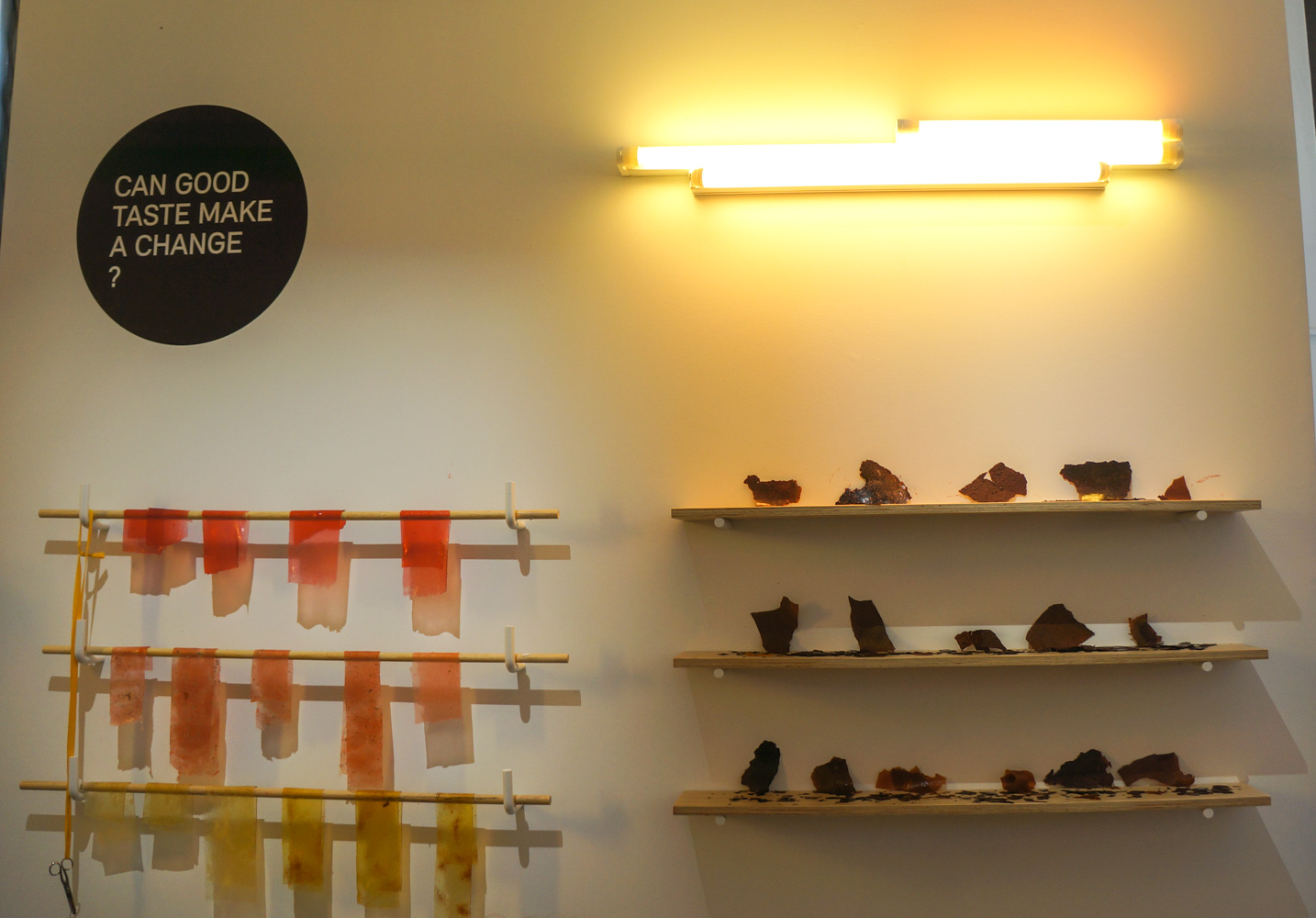
SUN LEATHERS
Leftover fruit from the harvest are collected and dehydrated
in the sun to create a conserved snack that can be enjoyed
at all seasons.
/
Dehydrated apple, strawberries, raspberry, mango.
Leftover fruit from the harvest are collected and dehydrated
in the sun to create a conserved snack that can be enjoyed
at all seasons.
/
Dehydrated apple, strawberries, raspberry, mango.
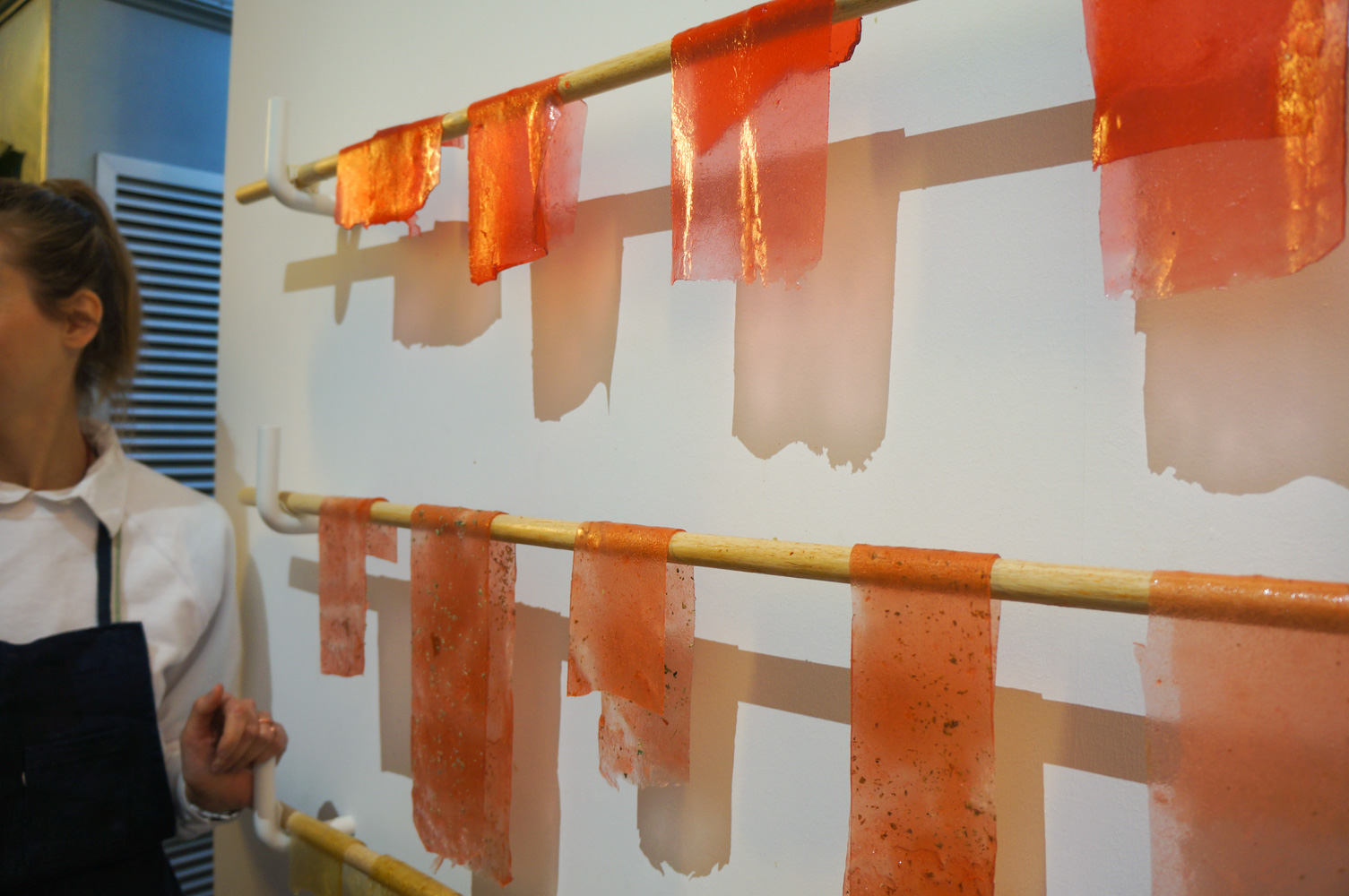
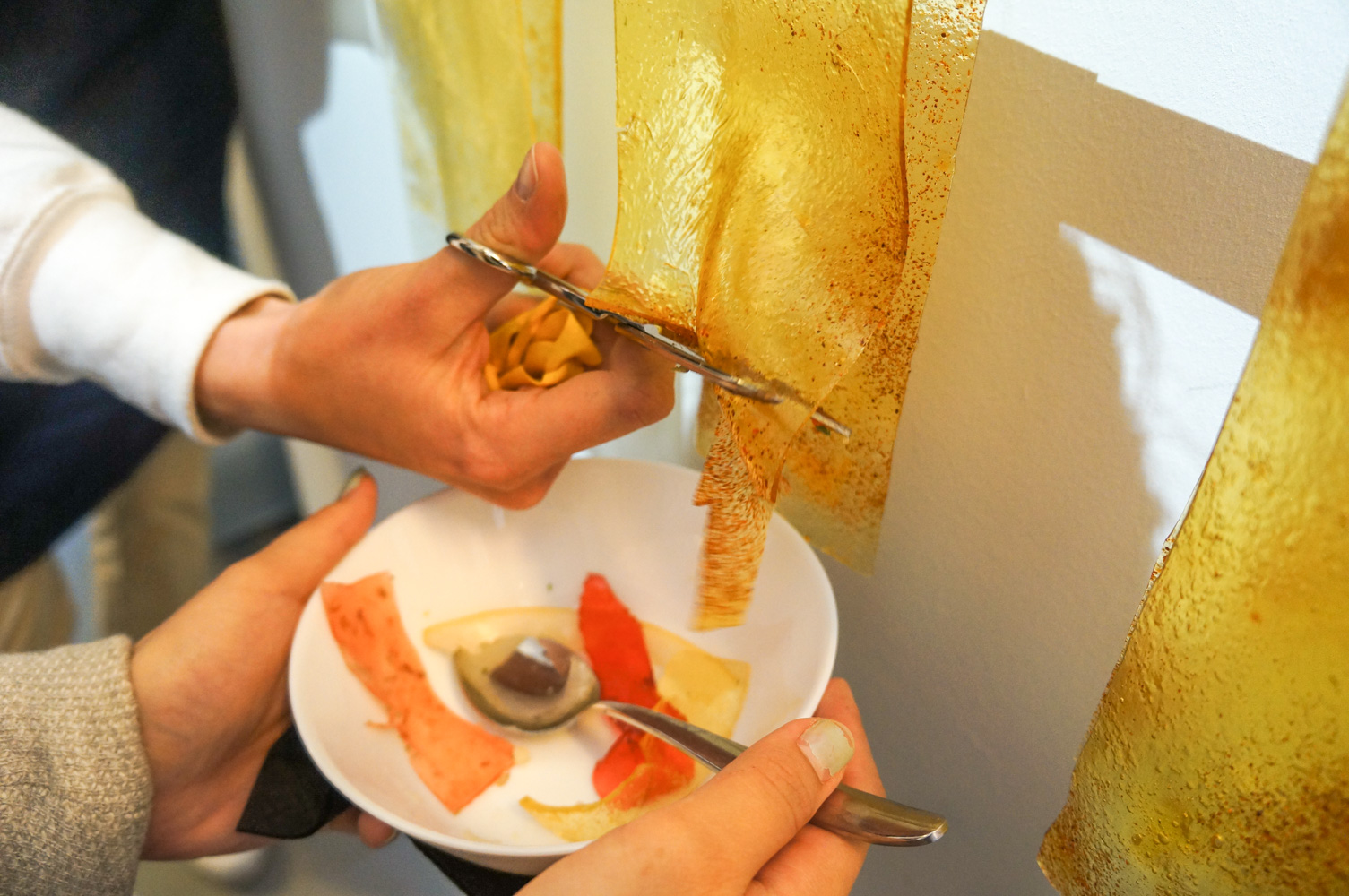
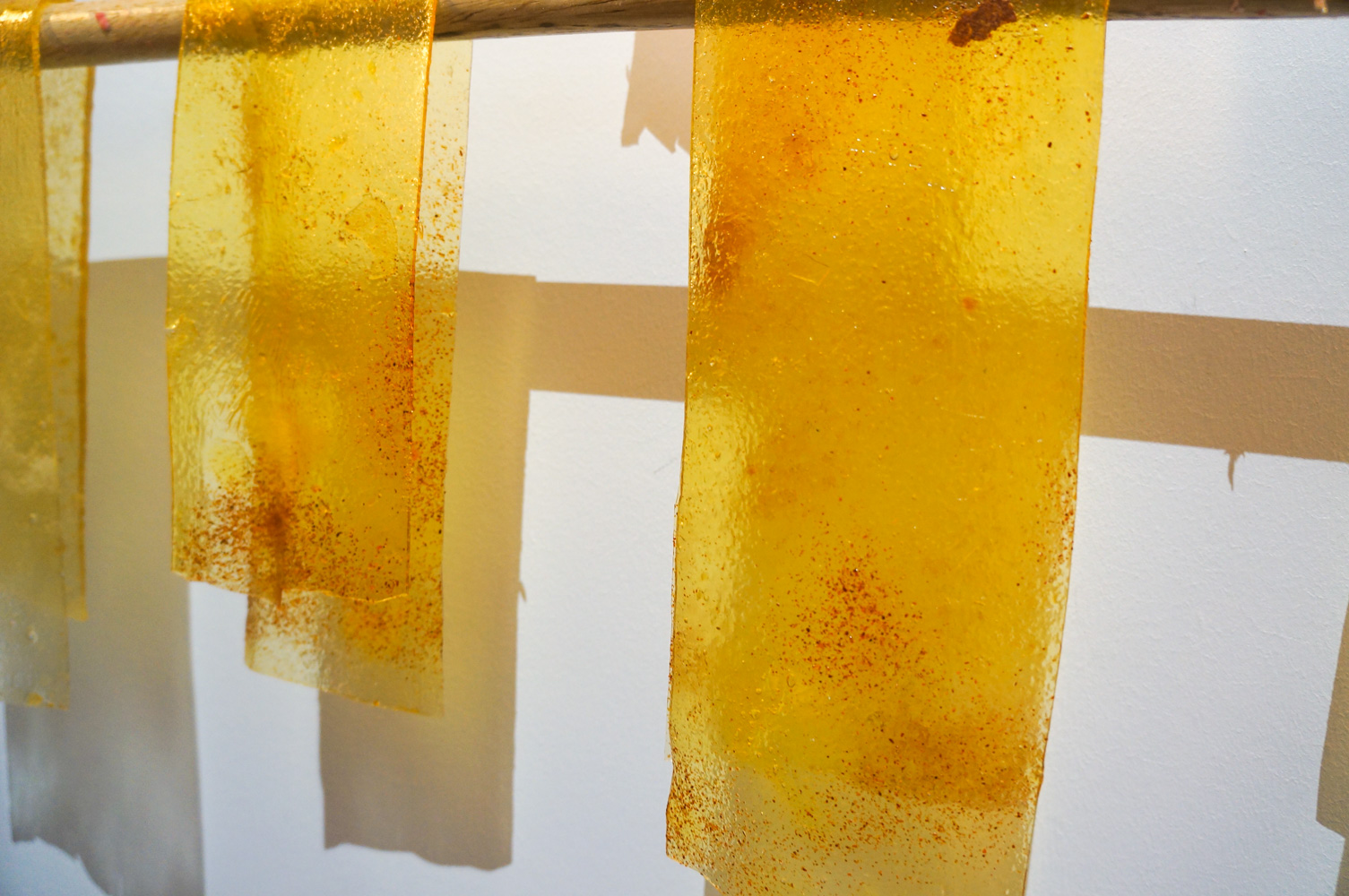
最后一个章节是“阳光”单元,将其命名为“sun leather”确实形象——晒至而成的果皮疏疏落落亮在几根活动的长杆上,给人仿佛刚从室外艳阳中架回来的既视感。讲解员兼服务员手持剪刀,随着大家的饕餮目光手起刀落剪下不同口味的片片“皮革”。“皮革”带胶状口感,让人回想起小时候常吃的软软的山楂卷,但口味稍淡且更加丰富。色彩鲜艳的果皮旁边,架子上铺着些许晒干的果皮,经讲解员解释后才知道那些干果皮不可食用,但是却在向人们展示着果皮完整的生命轨迹。
︎
DRINK.
Sunny tonic.
/
Turmeric juice, lemon juice, ginger.
Sunny tonic.
/
Turmeric juice, lemon juice, ginger.
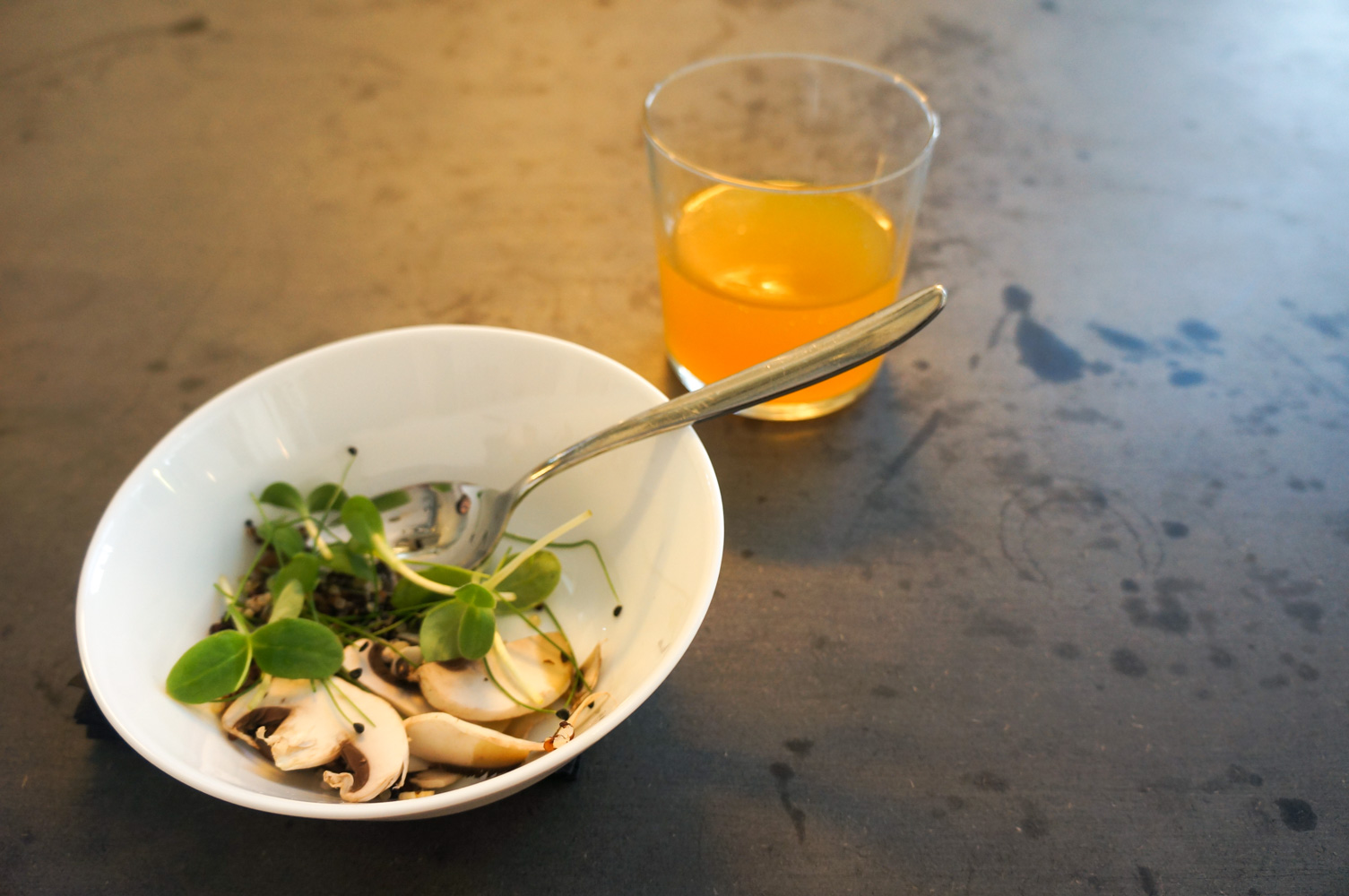
︎
- 小记 -
Xijing 溪婧:
在Laila Gohar的个人网页中,有一段话吸引了我——
Laila Gohar designs unique eating experiences that take place in non-traditional settings all over the world
当不同的饮食文化、饮食习惯已经横亘在人们之间,成为一种阻碍交流的鸿沟的时候,也许设计师可以反而从另一个视点出发,完全放弃传统的饮食方式创造一种全新的饮食状态,在这种全新的状态中,所有人都因一无所知而彼此平等,由此反而营造出一个刺激性的空间,鼓动着人们去探求、去交流、去玩耍……去创造新的回忆。
Yue 悦:
在mini living的饮食体验让我有幸获得了一次回归乡野的机遇,当生活方式回归纯朴,饮食这一部分理所应当地被放大、被解构到土壤与阳光、氧气与水的层面。体验“地味沙拉”的一瞬间,食不知味的我恍然:忙碌的城市生活让我们太久没有放下沉重的负担,用每一个感官去体验所食之物,我们匆匆拿起碗筷,匆匆完成补充能量的日常环节,可能太久没有用心细看眼下的食物。也许优质食物的艺术并不完全在于食物本身,也归因于我们无论作为生产者异或是消费者对待食物的方式,能否让食物拥有一个完整而美好的生命轨迹。
Subscribe Newsletter
订阅电子报
Newsletter archive
电子报存档
Tofoodesign is a design duo founded in 2016 by Yue LIU and Xijing XU, in connection between Milan and Berlin.
They ponder over Western European and Eastern Asian food culture and look for cultural or emotional spark, which can be generated from the fusion of different traditions and sensibilities. They focus on all stories related with food: who makes the food? Where and how is the food made? How can food be part of the different lifestyles of everyone in a satisfying way? Where and how can the act of eating or drinking be rediscovered? How can this pleasure be shared with others in new ways?
They deconstruct and integrate these questions through multisensorial projects, try to give people new possible answers and reflections about food, new ways to think about the meaning of food in our lives. According to real contexts of contemporary society, They create special interactive environments with new forms of experience and emotional ways to bring people in connection with food and others.
︎︎︎︎︎
Visual Communication
Branding | Packaging
Branding | Packaging
Product System
R&D for product & service innovation
R&D for product & service innovation
Experience
Event | Workshop | Laboratory
Event | Workshop | Laboratory
